‘Iya babes! London Fashion Week is here and after the uber-sexy collections in New York, our city’s streets are already tingling with excitement for the Spring Summer 2023 collections on offer. After all, London is the hometown of some of the fashion world’s most innovative and trailblazing talents. Of course, due to the Queen’s death earlier this month, the period of mourning and her funeral – a few things have changed on the schedule (more on that here). Nonetheless, it’s set to be an electrifying season, with the debut show of Chopova Lowena, the homecoming of JW Anderson and the runway return of Christopher Kane. We also have high hopes for the new gen of fashion designer talents who have been dazzling us since they stepped out of school – Stefan Cooke, Feben, KNWLS, Nensi Dojaka and so many more. Here’s everything you need to know from London Fashion Week SS23.



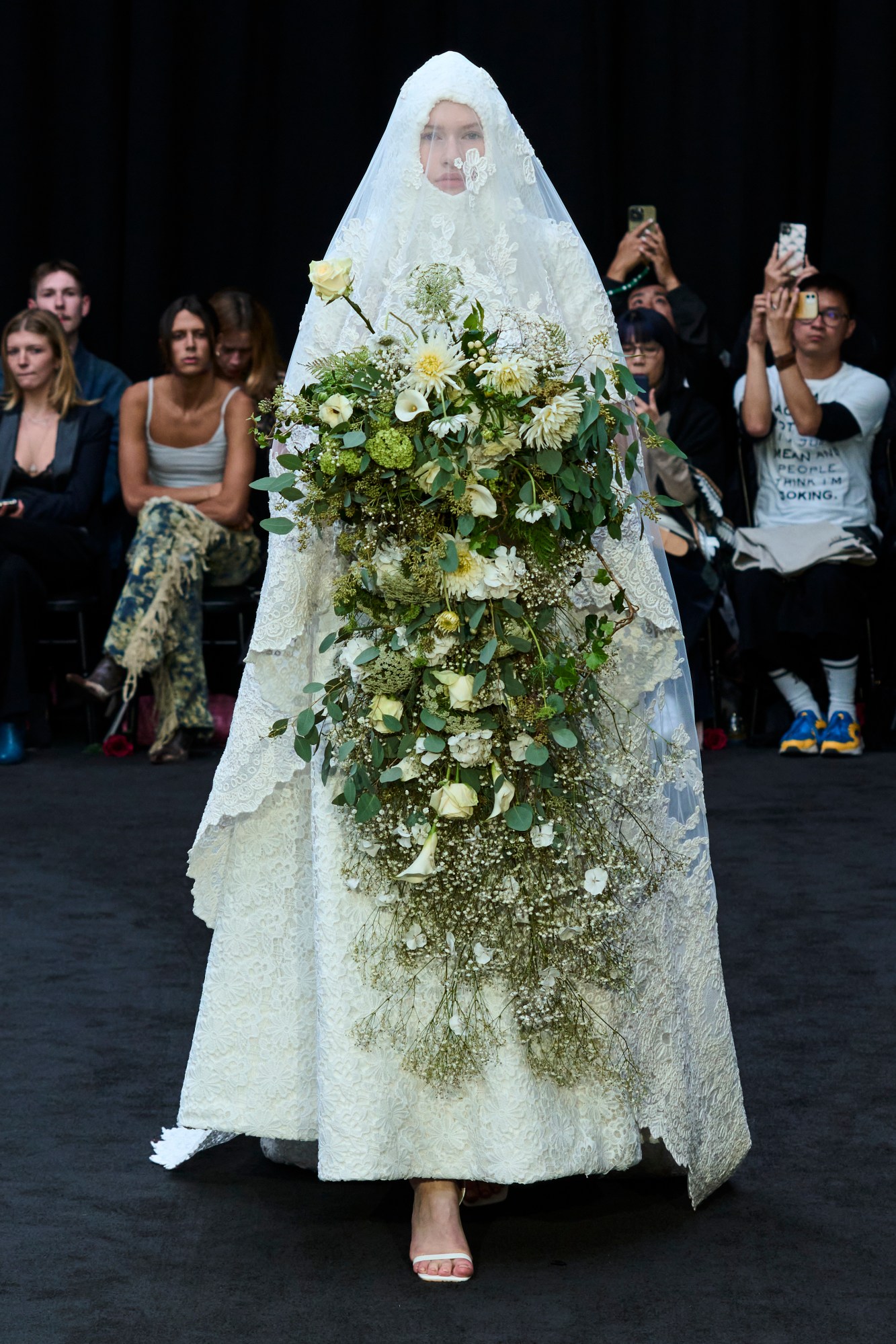
Richard Quinn
The pressure to close out LFW is, presumably, always huge, but this year the stakes were higher than normal. The entire week had been unfolding in the aftermath of the death of the Queen, and subsequently, the atmosphere was at times sombre, at times eerie. Rather than running from that atmosphere, Richard Quinn embraced it with a collection that began with a funeral march and was dedicated to Her Maj “who touched him among so many others with her grace and kindness”. Four years ago she was sitting in the front row, presenting him with the inaugural Queen Elizabeth II award for British design. Now, she was beamed to us by satellite.
A cerebral orb of CCTV screens displayed archive footage of Queen Elizabeth over the course of her life and reign as a parade of models in exquisitely intricate all-black looks trailed dramatically through the middle of the Royal Horticultural Halls. The result was moving, melancholy, more Victorian than Elizabethan (lots of veils covering the face, delicate French lace, tiny black crowns), and historic in its scope and execution (how did he manage to pull this many mourning looks together this fast?). This was the kind of mourning that the English knew how to do properly in the 1900s, before it became all Twitter memes and 30-hour queues on the Southbank.
The rest of the collection was refreshingly post-Elizabethan, the focus veering dramatically from historic to futuristic. Those videos of the queen disappeared and the screens in the middle showed a live feed of the SS23 audience as models boldly stomped past in bulbous body suits, embellished swing coats and polka-dot fur jumpsuits. More covered faces. Hair slicked down, bleached brows. If the first half of the show was a funeral, this was a coronation, except set on another planet. Billie Eilish’s “Happier Than Ever” blasts as confetti streams down on a decidedly Princess Diana-esque final bridal look and on the screens we watch ourselves watch the weirdness, spectators to an accidentally historic end to an accidentally historic season. It’s what she would have wanted. RL
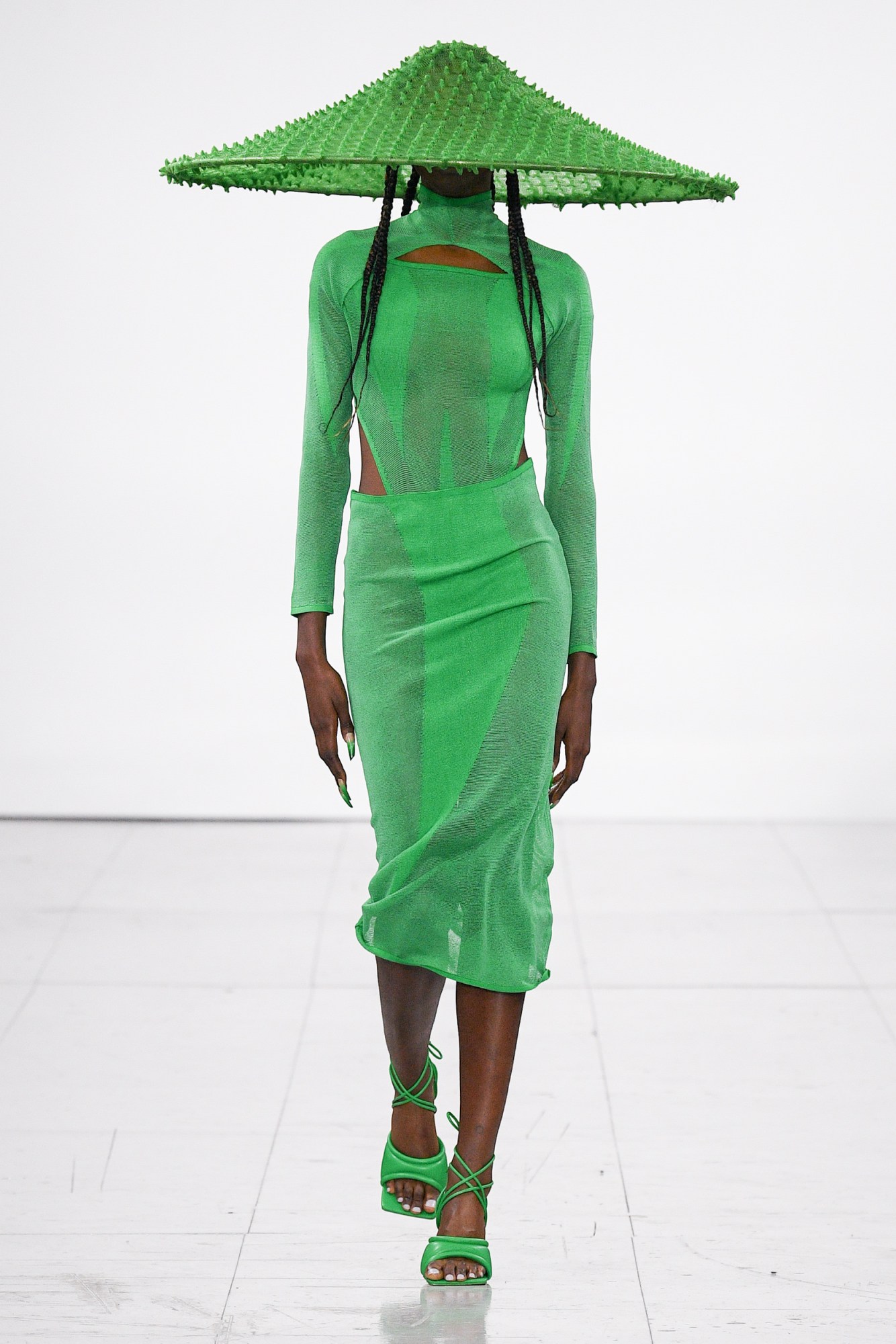
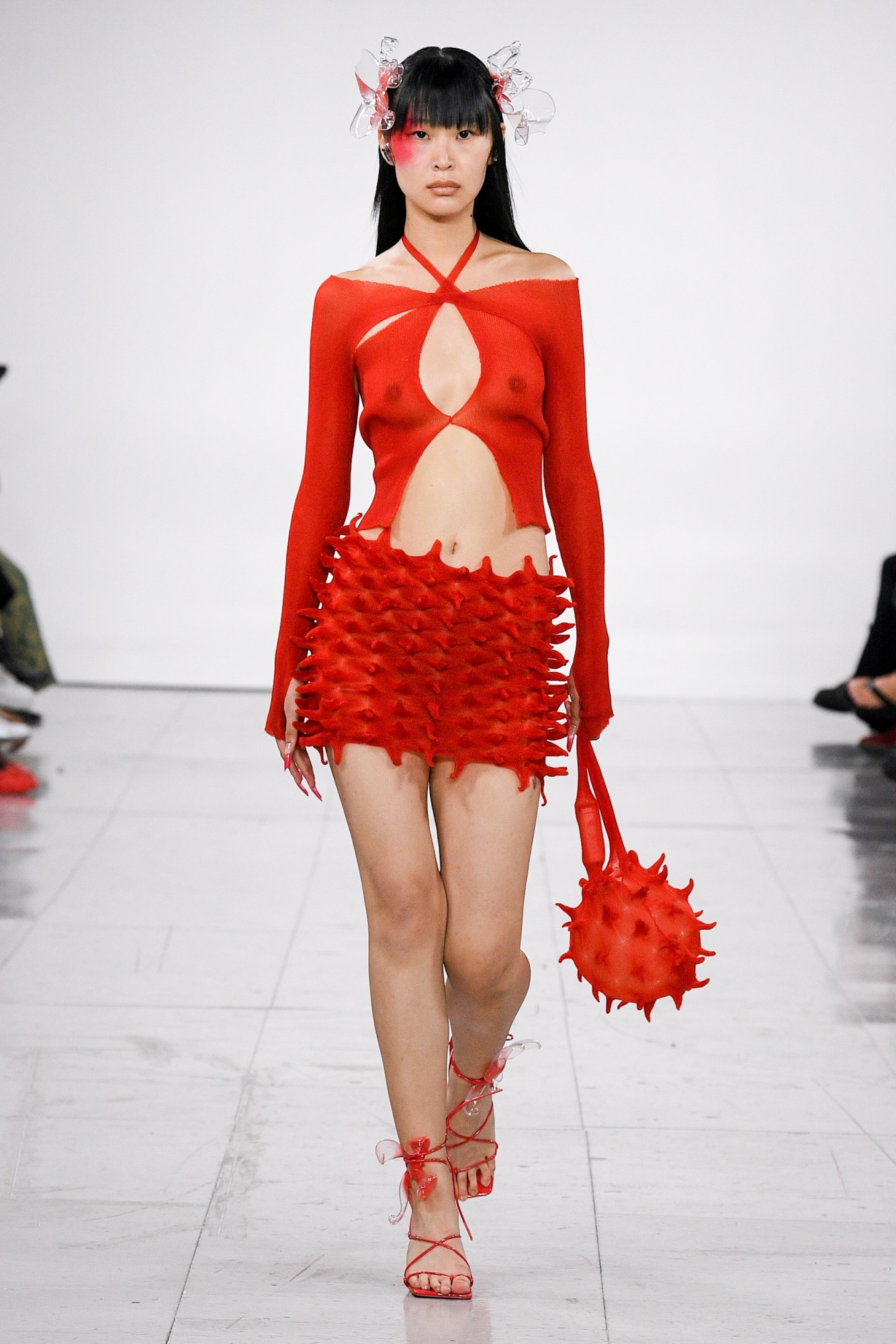

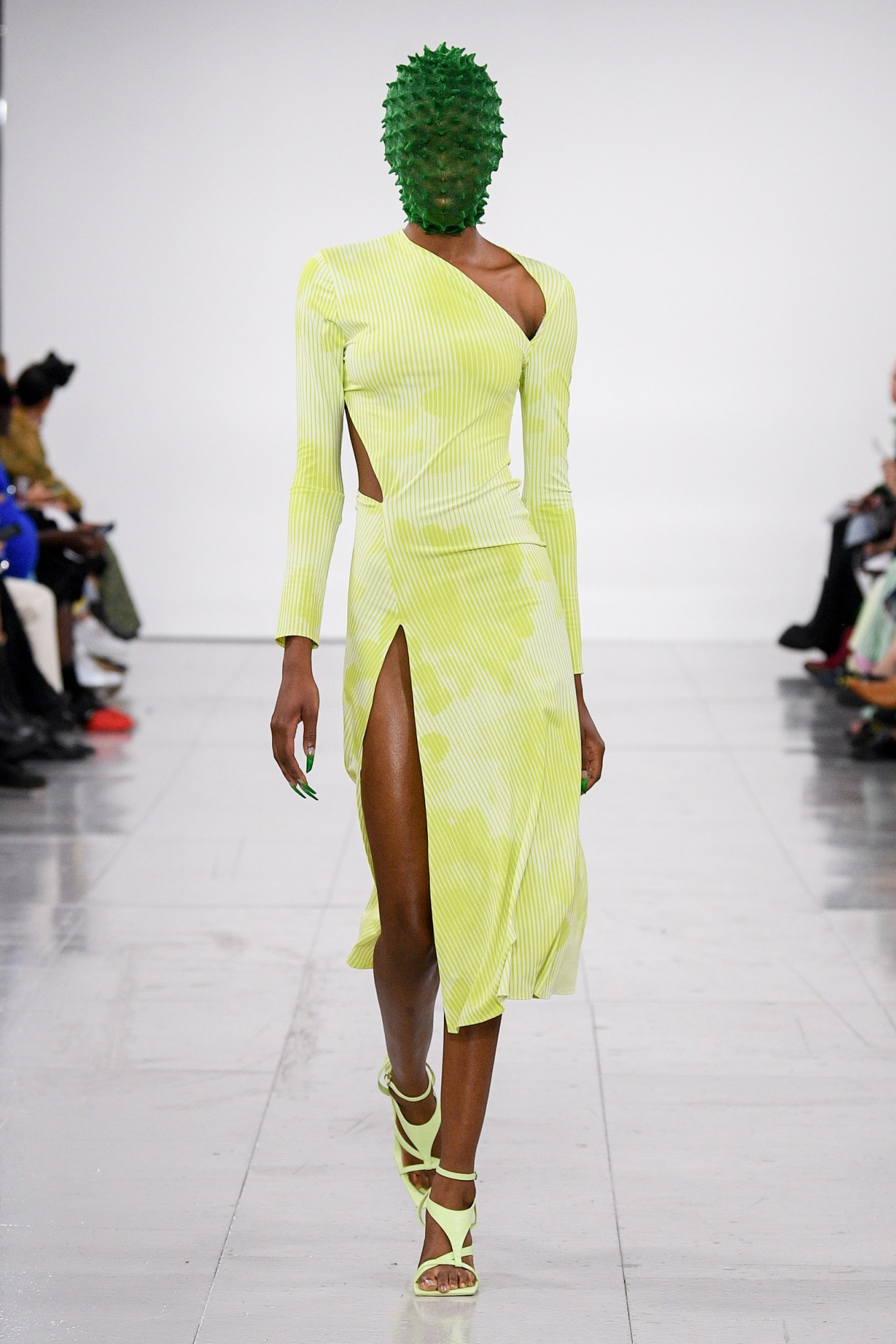
Chet Lo
The audience at Chet Lo’s SS23 show – bathed in a sea of temple incense and tranquil gongs – were aggressively awoken by bright white lights and a thumping techno track as the first model, clad in a jungle green slip cutout dress and a perfectly circular conical hat, walked the runway. It was a fitting introduction to the designer’s first solo London Fashion Week show, though. The bold hedgehog-knit Y2K partywear – showcased in electric-hued sheer low-rise trousers and skirts with visible underwear and matching crop tops or skimpy gloved-cardigans – that Chet became famed for at CSM and Fashion East and beloved by the likes of Chloe Cherry and Dua Lipa were of course still there. But mixed into the collection were nods to the serenity of his childhood growing up Buddhist and going to the temple.
Titled Baai-San, meaning “to pray” in Cantonese, haphazard slashes across the chest on high-cut bodysuits and pelvis-hitting on floral-print, subtly-striped dresses rewrote a well-known Buddhist tale. Within the myth, Mara, the goddess of death, launches a sea of arrows at Buddha, who, now enlightened, deflects them to the ground where the tools of death are turned into beautiful blossoming flowers. Chet’s slashes, though, imagine clothes where the arrows actually hit, with two final sheer gowns in the collection dotted with 3D-printed lotus-inspired flowers and trails of jewels, as if the flowers sprouted from the arrow-pierced body. Evidenced, too, in hulking ballooned sleeves and handbags, both attention-grabbing whilst precarious as vulnerable targets to Mara’s arrows, the reinterpretation of the tale spoke to a cyclical existence – the fragility of life but also the rebirth into something new and beautiful. TG
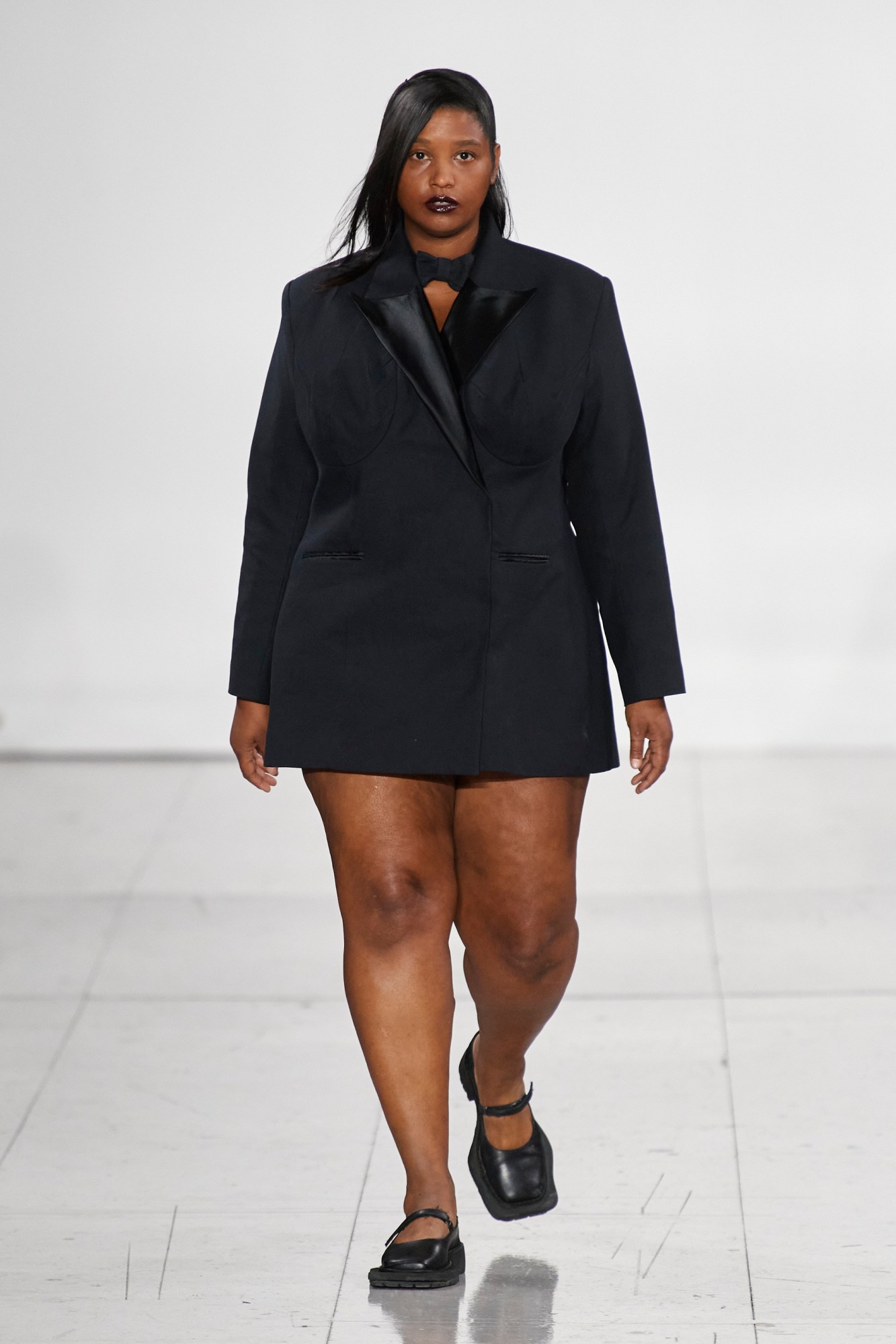
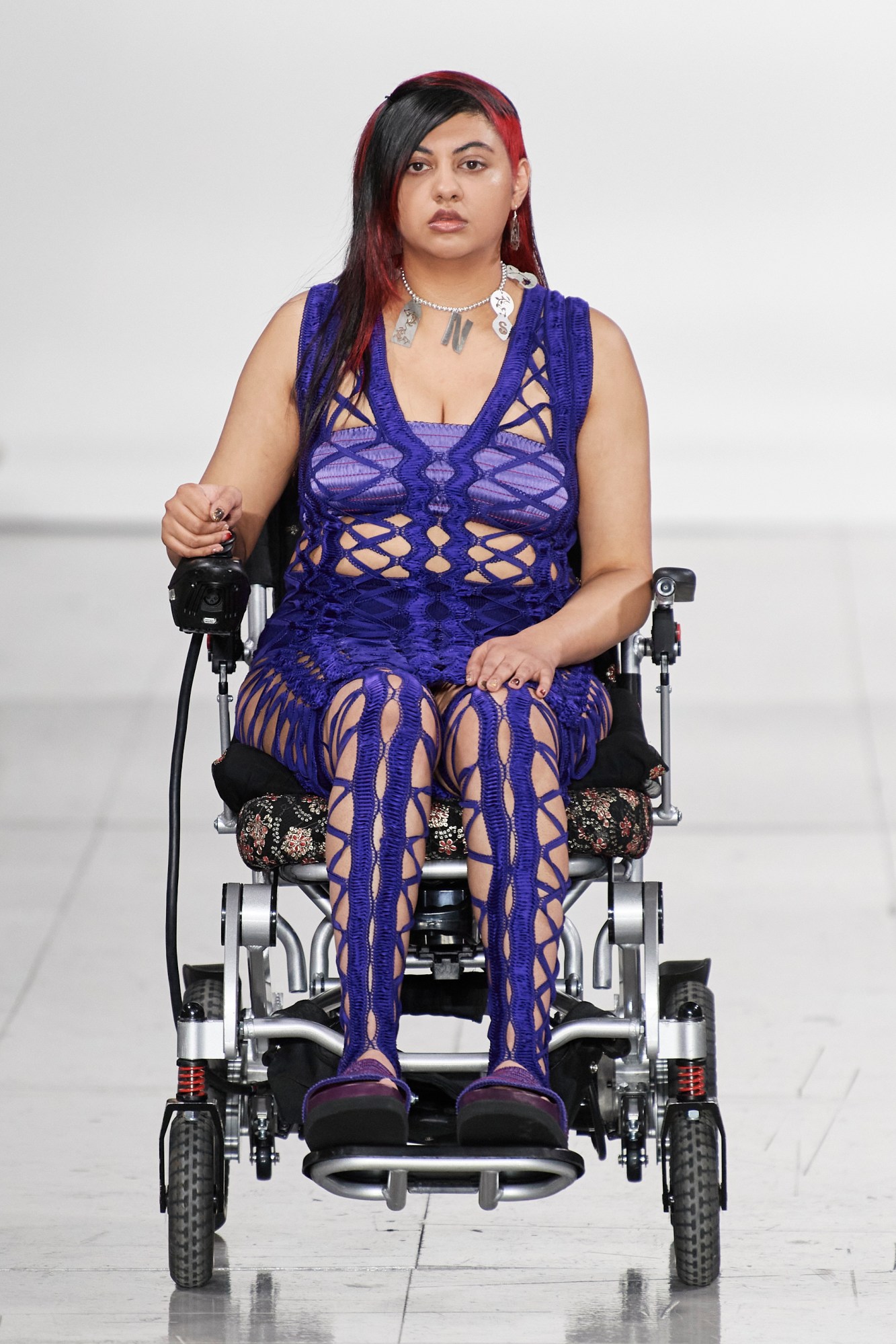
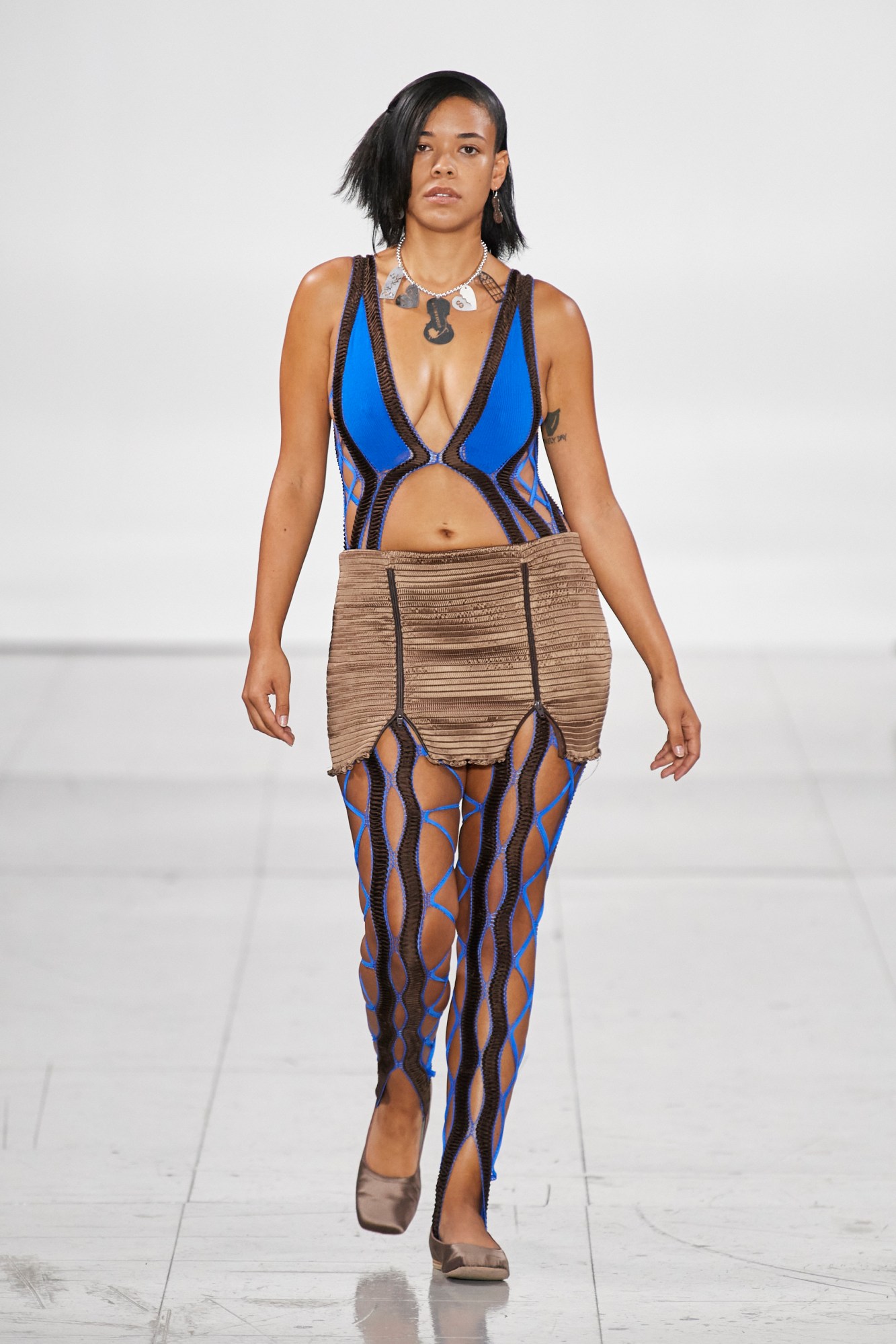
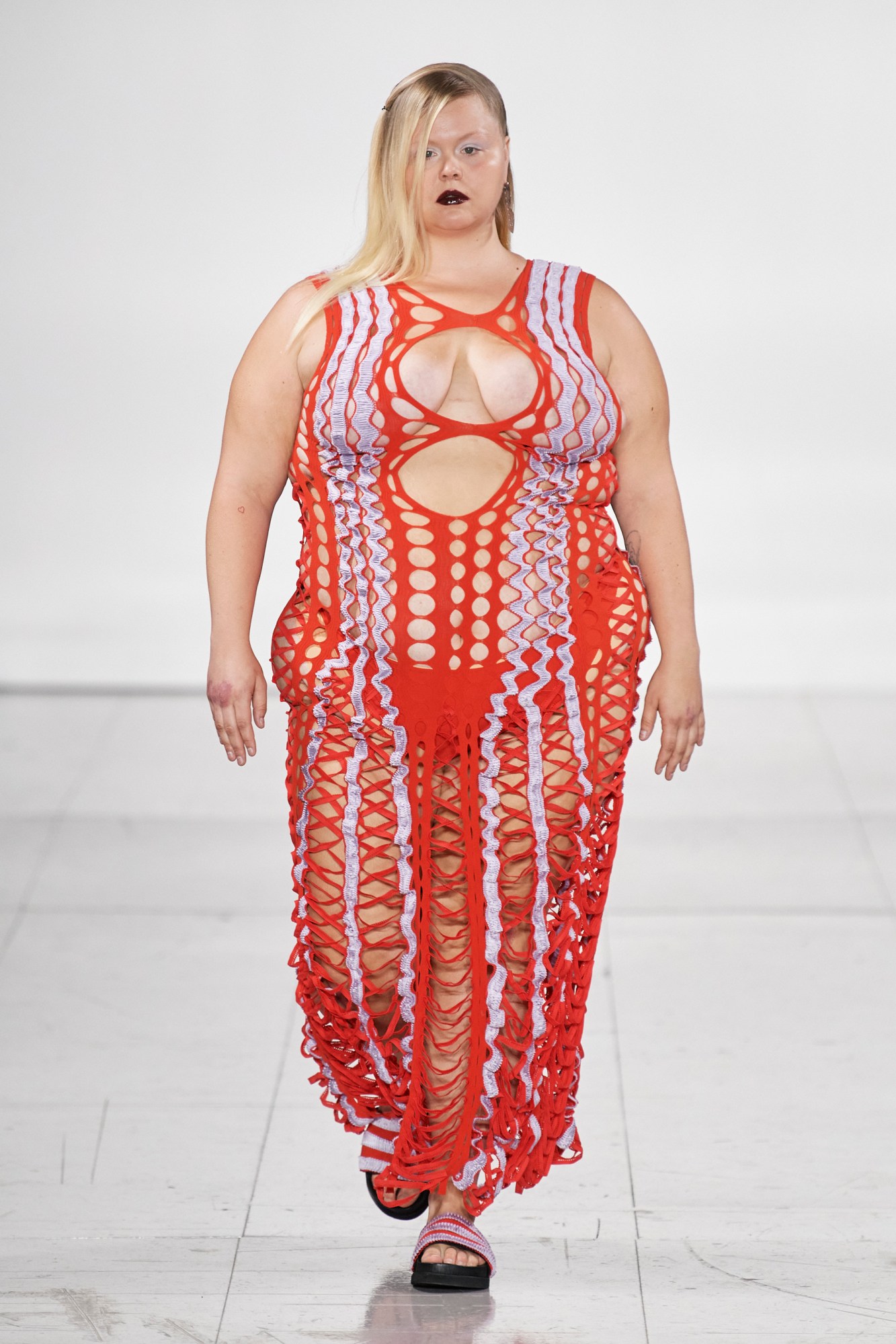
Sinéad O’Dwyer
While far from unanimous, this season in London has seen a notable increase in the number of designers making the effort to represent non-sample-sized models on their runways. Few, however, have gone to quite the same lengths as Sinéad O’Dwyer in her attempts to reframe industry-held perceptions of the bodies that deserve to be seen. For her debut runway show – and her first as a NEWGEN recipient – the Irish-born designer presented a wide-ranging collection that saw her signature body-inclusive techniques – webbed, shirred silk strapping and contoured pleating among them – innovated with gusto, as well the introduction of sharp tailoring and diaphanous gowns.
Drawing upon memories of her mother playing the cello and attending musical practice camps over school holidays in the Irish countryside, this season saw Sinéad tap into the emotional turmoil and sense of personal sacrifice that figures in the life of any artist. Ultra-stretch dresses constructed using a technique that combines shirred silk bands with panels of elasticated ribbed knit came in Beetlejuice red-and-black and lilac-and-scarlet, while billowing pleated trousers were crafted with the ability to play the cello while wearing them in mind. T-shirts bore hotfix crystal embellishments and cartoonish illustrations of weeping musicians, while concert-ready satin wool tuxedo jackets and poplin shirting featured a darted bust that accommodates larger bust sizes while allowing the lower part of the garment to fall flush with the wearer’s body.
As ever with Sinéad, real human bodies – rather than a dissociated, unrealistic idea of what they look like – serve as the point of departure of her designs. What made itself felt in yesterday’s show, though, was the sheer range of bodies that her work accommodates. Handpicked by rising casting director Emma Mattell, the show saw an ensemble that included perhaps the most genuinely diverse representation of sizes, abilities and gender identities that we’ve ever seen on a London runway. At a time when change in fashion is repeatedly called for, yesterday, Sinéad O’Dwyer showed what it should look like, and how to put it into action. MS
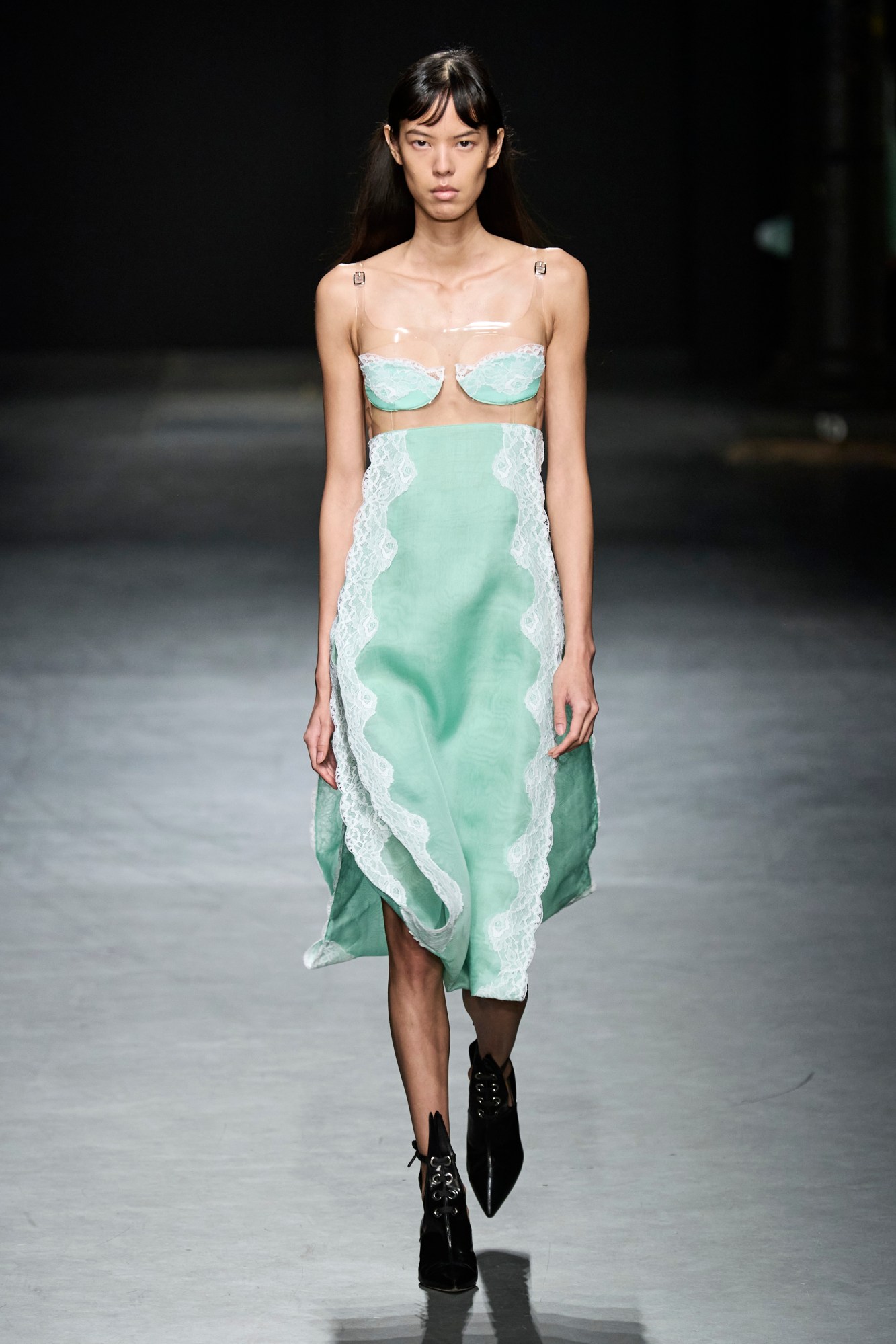
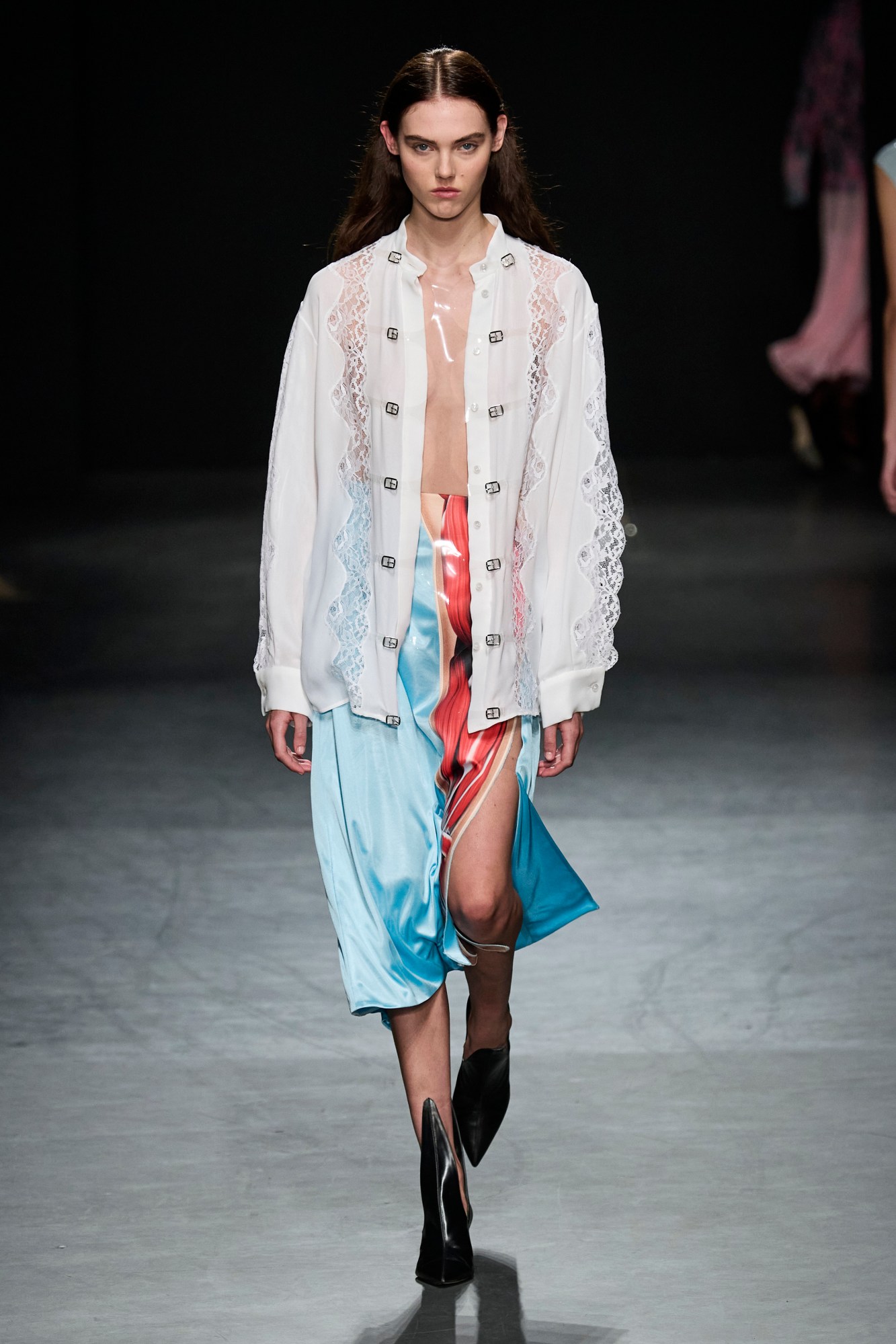
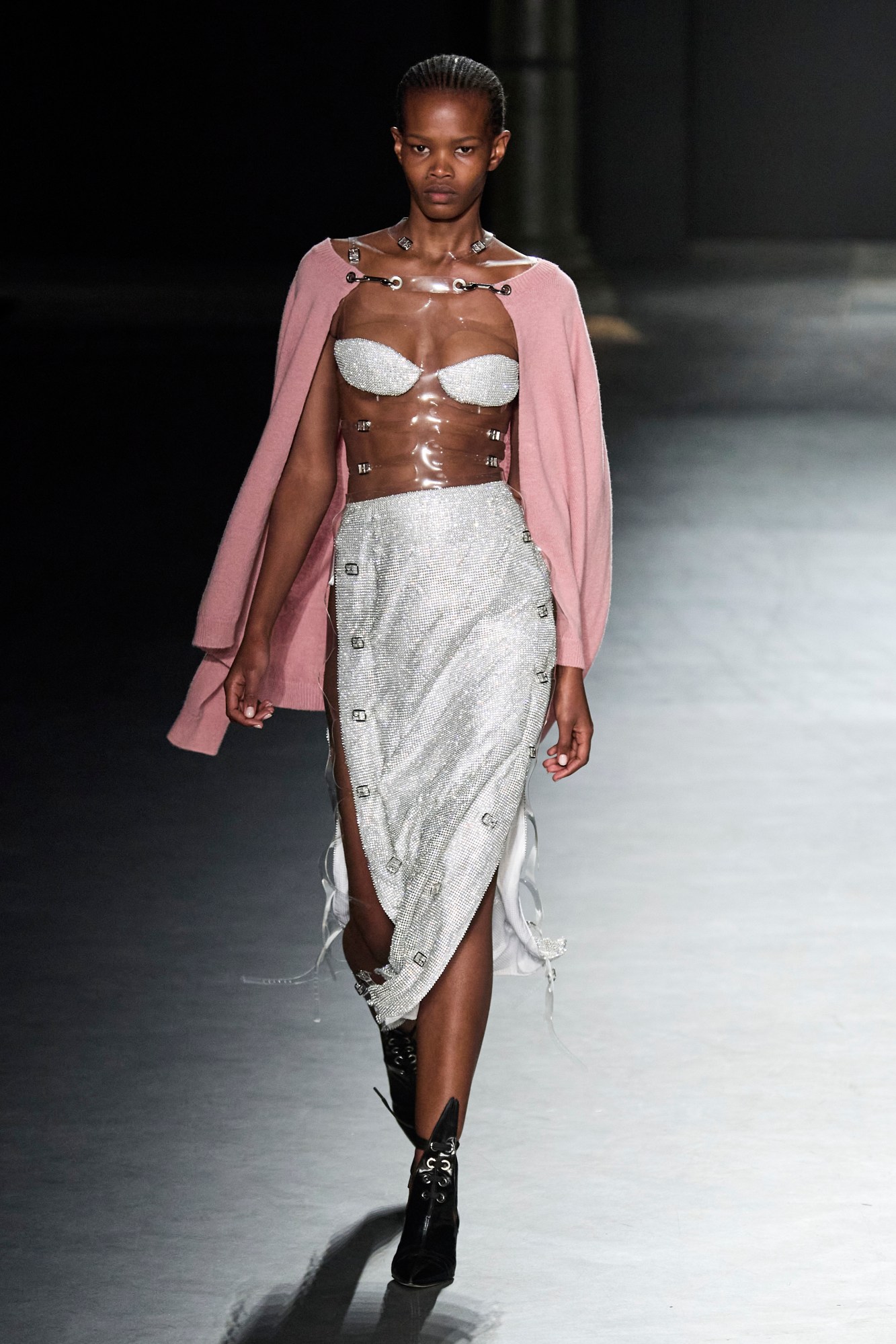

Christopher Kane
Christopher Kane is back! Not that he ever went away, really, but on Sunday night, the Scottish designer made a symbolic homecoming on the London Fashion Week schedule. Observing a minute’s silence at the start of the show in the dim-lit Camden Roundhouse, the energy quickly shifted to full-scale comeback mode. Models emerged through a tunnel of white light in Christopher’s typically slick, perverse examinations of the female anatomy and so-wrong-it’s-right combos of contrasting materials, which this time took the form of plastic vinyls and fondant cashmeres. Essentially, the look was a subversion of Stepford Wife pastel skirt suits, British grandma cardigans (look 40 was actually inspired by Queen Elizabeth II’s final appearance at Balmoral) and typically traditional twinsets. Except, this being Christopher Kane, it was all reimagined for the contemporary vogue for brazen displays of skin; matronly staples seen through the prism of Gen Z’s hunger for hyper-sexualised sizzle.
Suffice it to say, these weren’t your grandma’s Scottish-woven cashmeres. They were far more sexually-charged. Underneath the oversized slate-grey cardies (also aptly inspired by the young Queen Elizabeth and her sister Princess Margaret roaming the grounds of Balmoral) were bralette cups suspended from transparent plastic exoskeletal structures that cinched the torso, almost like invisible X-rays, creating the illusion of the muscles lurking beneath the skin. Christopher described them as “invisible shields, almost like armour”. Elsewhere, apron skirts in sorbet tulles came with the medical precision of nurse’s uniforms, spliced along the leg with scalpel-edge slits, edged with wedding-cake lace. And graphic floral satins — “symbolic of life and death … celebration and condolence” — appeared on razor-sharp A-line minidresses. Some of them even came in wipe-clean vinyl, which only encourages your mind to wonder what for.
Dotted throughout were anatomical illustrations of hands and feet, taking centerstage on languid silk dresses. “Hands and feet are basically symbolic of strength and power and overall aggression,” Christopher explained. “This was about dissecting a woman, in the most beautiful sense. Protecting the body, almost forensically.” He went further by mentioning the recent events of the overturning of Roe v Wade, and what that political decision means for generations of women’s autonomy over their own bodies. And sure, these clothes are about the body, its strengths and vulnerabilities — but they’re also just as much about celebrating them. Clothes to be relish in all the carnal pleasures a body is capable of experiencing. OA
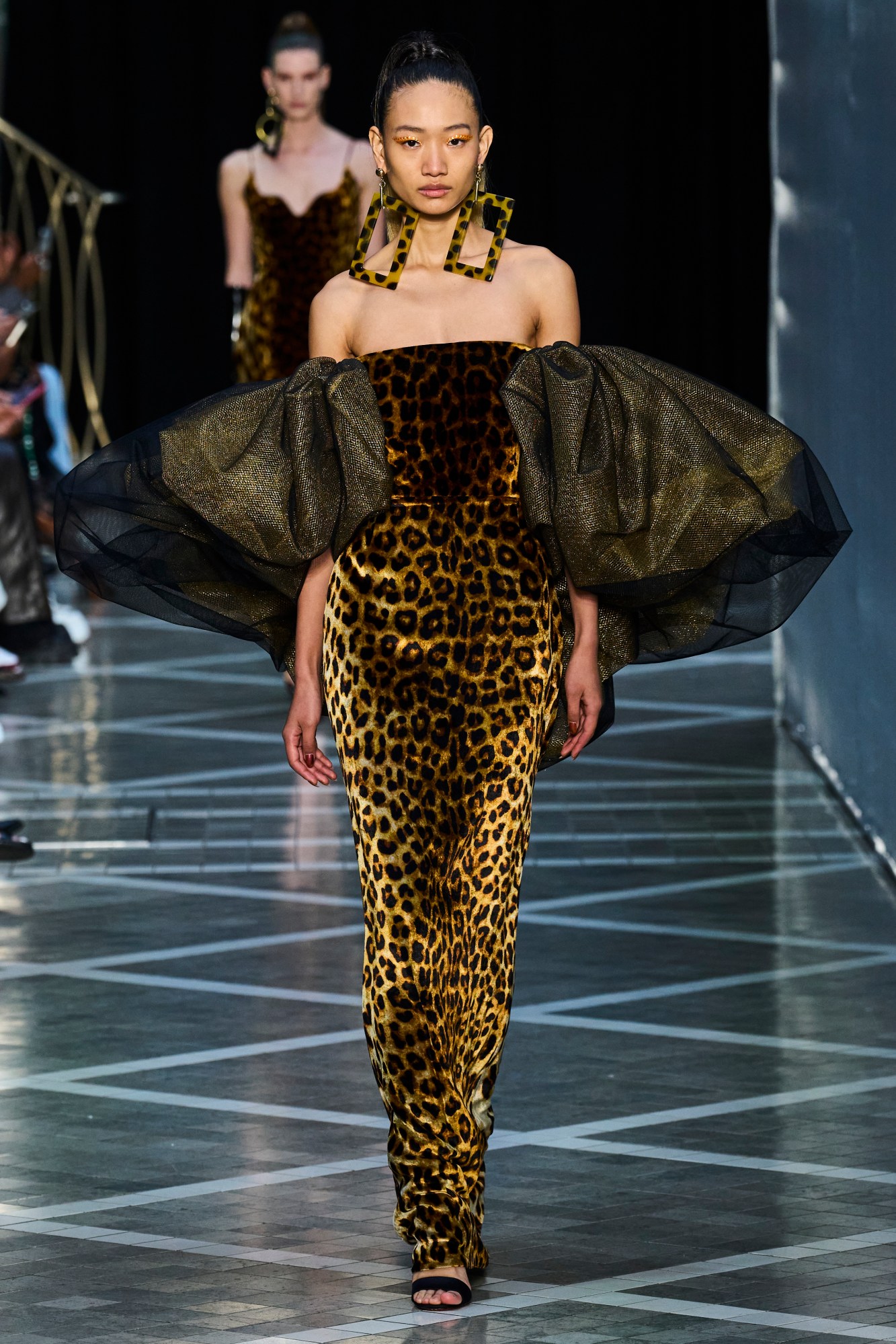


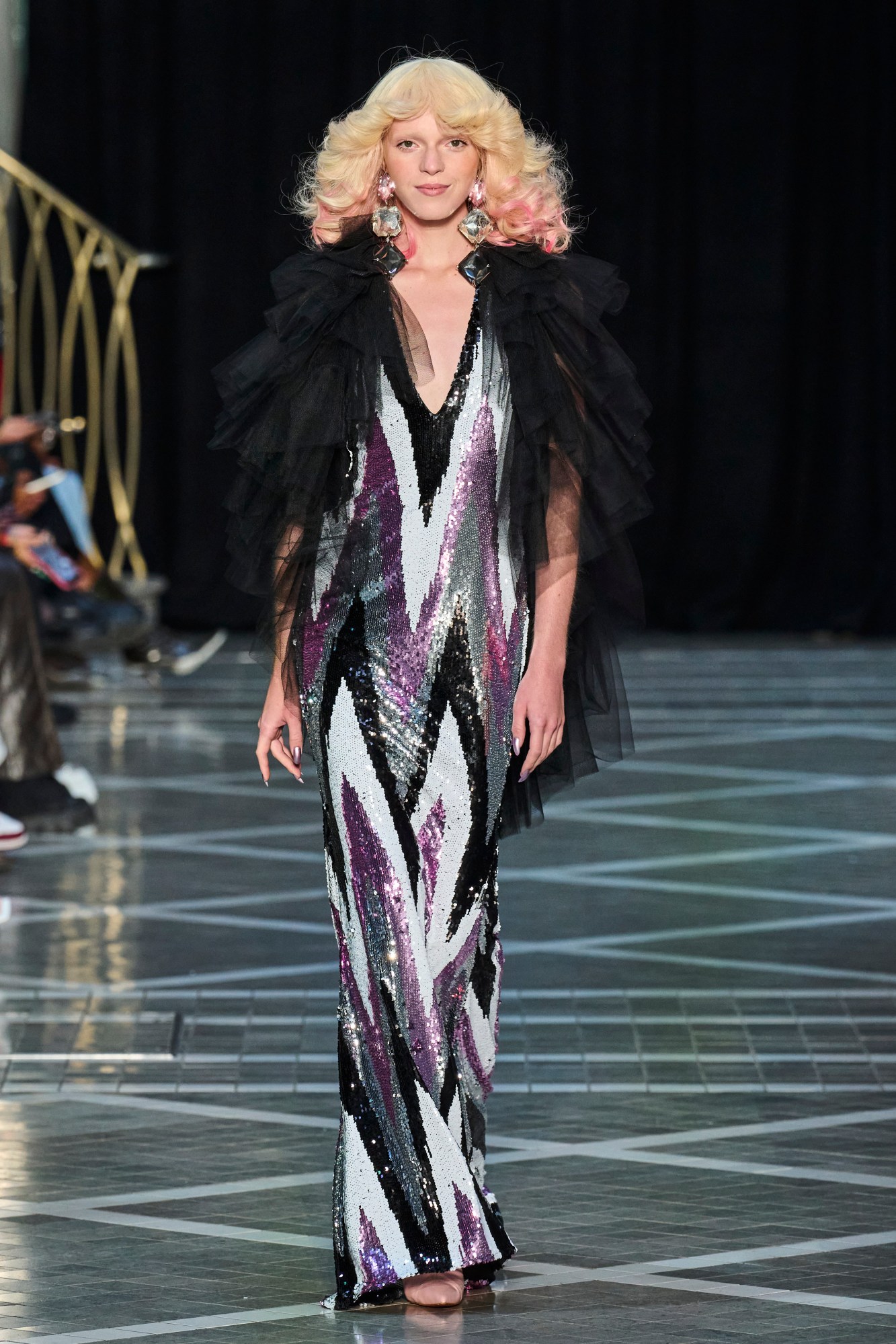
Halpern
In the grand, Dreamhouse-like architecture of The Royal Exchange, Halpern‘s SS23 show paid homage to not just one, but two of the past century’s most iconic women: Barbie and The Queen. Naturally. The opening look, displayed powerfully in complete and eerie silence, was a homage to her Late Maj, all-engulfing silhouettes in royal regal blues meant to evoke “a reign that promoted creativity, openness and a widespread support for creative freedom”. More of a personal than a political statement, the timing of this LFW-in-mourning is for Michael especially poignant; after moving to London five years ago to attend CSM, the New-York born designer is becoming a British citizen this year. “This singular look is a way for me to show my gratitude to the Queen for encouraging designers like myself to express in the only way we know how,” he says of the opener, “through the power of fashion and optimism. It has always been my ethos that, in times of darkness, I look to the fantasy of fashion for its optimism and strength. This particular instance is exactly that.”
As the vision in blue disappears, disco replaces silence; the rest of the show was a different kind of celebration of a different kind of cultural institution for the 60th anniversary of the Barbie Dreamhouse. The models, decked out in lush blue, star-strewn velvets, ruffles upon ruffles, leopard print (of course) inspired by the humble, Kat Slater-esque house-coat, plunging necklines and more glitter and sequins than Barbie — or the Queen — would know what to do with, are inspired by the dolls Michael loved so much as a child and also by the luscious disco-inspired looks from his mother’s wardrobe. The result is a childhood fantasy of a glamorous hostess, the kind of woman you can imagine hosting the kind of parties you would never have managed to get invited to in 1980s upstate-New York, the kind of parties Mrs Halpern presumably excelled at. RL
Simone Rocha
What do lacy lingerie and military uniforms have in common? A sense of utilitarianism, one could argue. Though they may seem worlds apart, aesthetically speaking, both genres of clothes uphold and support, albeit with different kinds of straps, garters and buckles. The unexpected common ground between the architecture of frou-frou underwear and the clothes worn on action-packed assault courses are what provided the impetus for Simone Rocha’s SS23 collection. “This idea of strength and power, but broken down through femininity,” as the Irish designer explained a few days ahead of her show in her light-dappled studio on the Regent’s Canal, where her fittings take place in front of a tall Venetian mirror. We took a sneak peek of the collection, and caught up with Simone to find out more. Read the full story here. OA
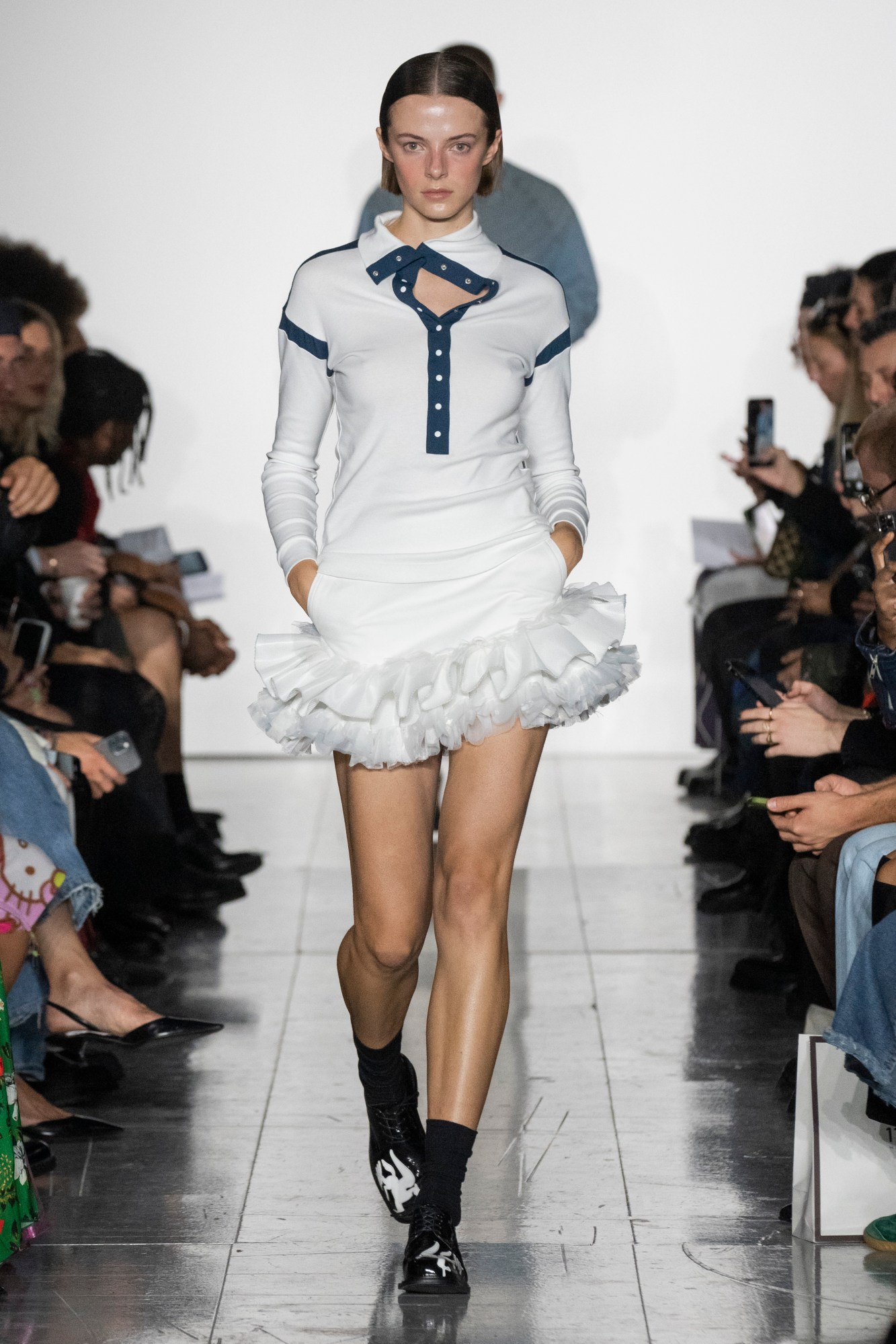
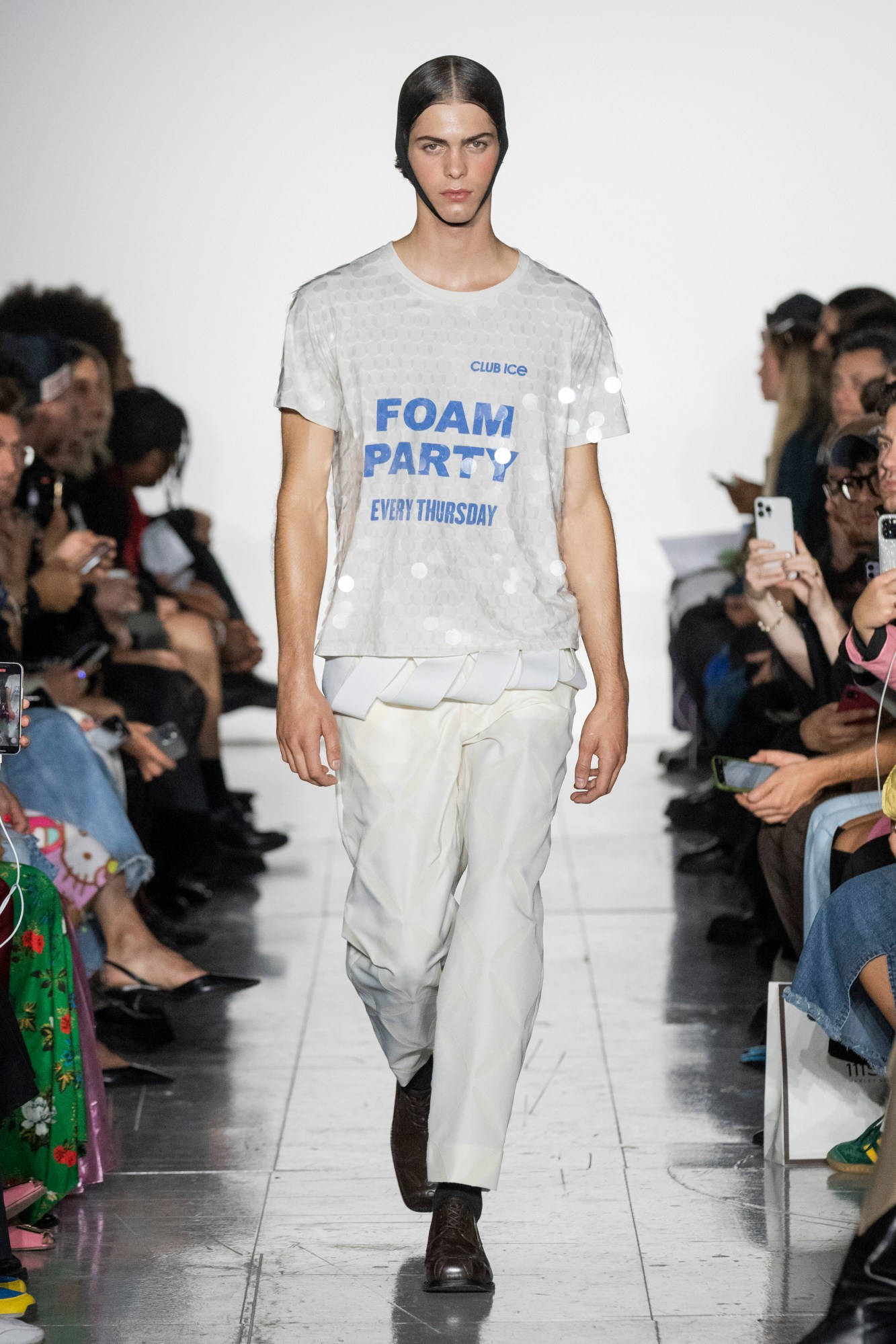
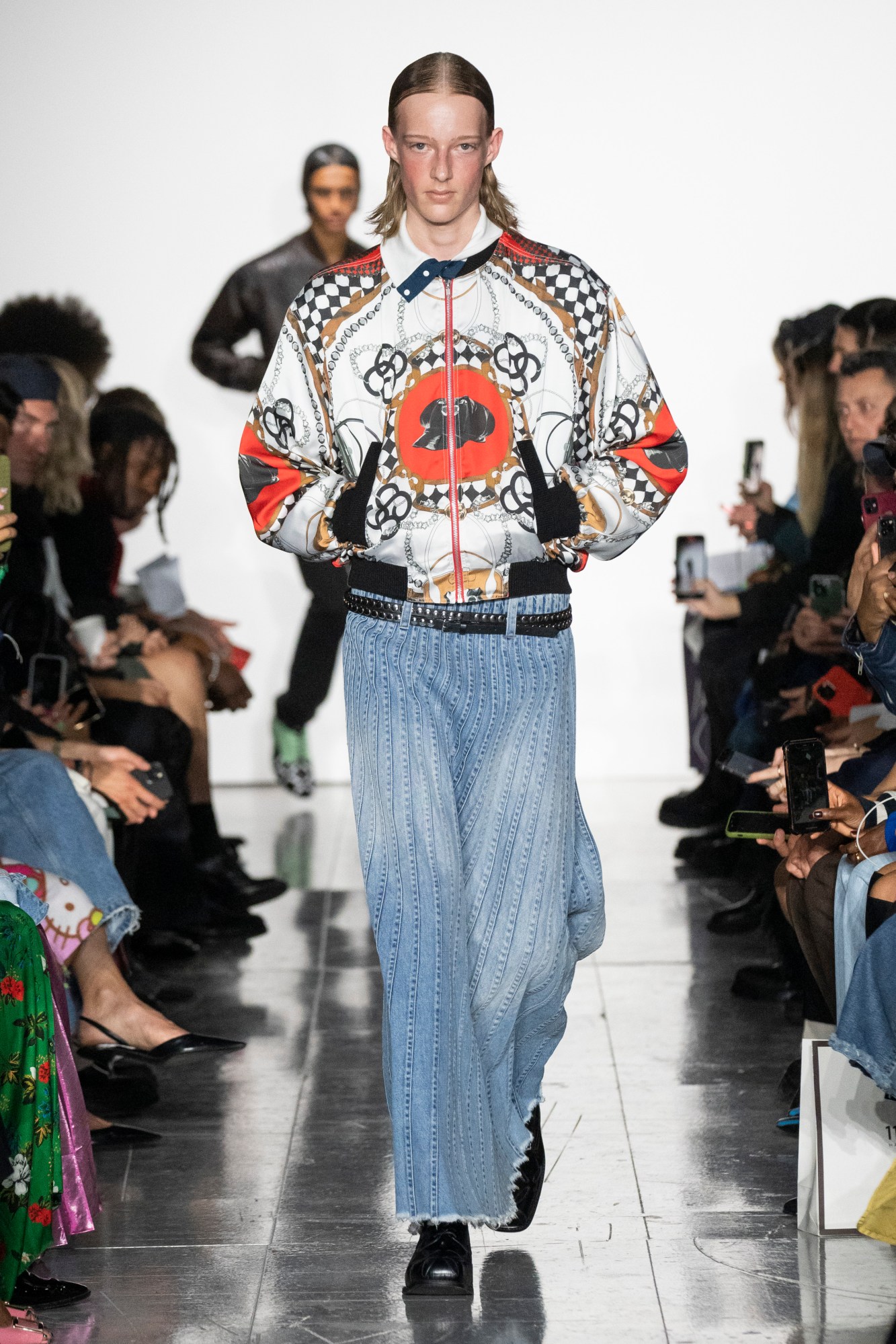
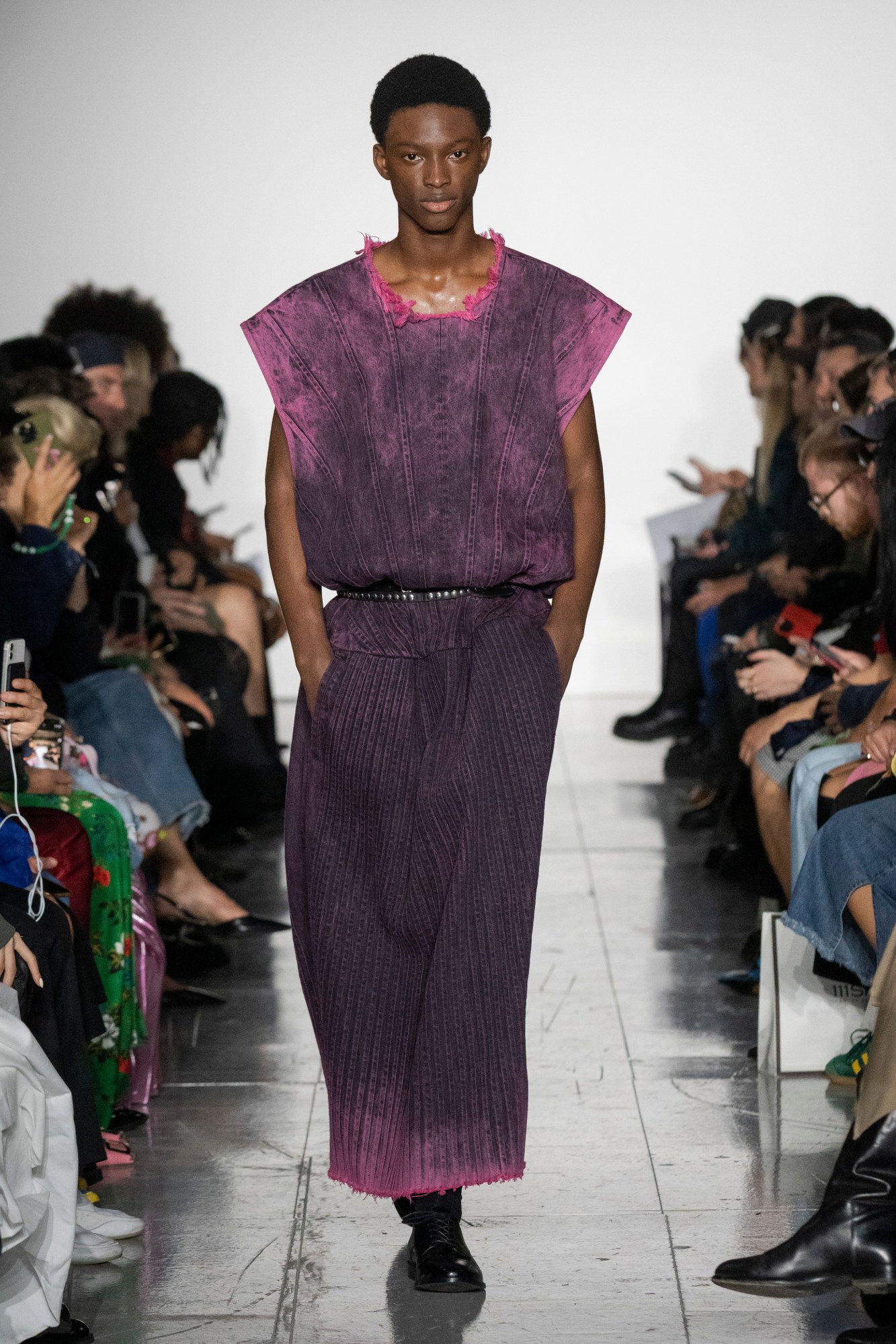
Stefan Cooke
Since first arriving on the London scene in 2019, fresh out of the Central Saint Martins’ MA, Stefan Cooke and Jake Burt have cemented a reputation as perhaps the city’s most directional menswear designers. Their hallmark aesthetic – an aspirational, mod-ish perspective on luxury that echoes the lean-silhouetted chic of mid-00s Hedi Slimane – has earned them legions of loyal admirers – particularly rakish guys instantly recognisable in slashed lozenge knit sweaters, skirted jackets and chain-linked button-strap bags. All the while, however, Stefan Cooke has also been patronised by a good number of female fans, a fact that no doubt prompted the duo behind the brand to put out its very first womenswear looks for ONE, its SS23 collection.
A mock-neck jersey mini-dress covered with blue ribbon bow appliqués and a faintly nautical polo-dress with a warped collar came with frilled tutu hems – a nod, it seemed, to the designers’ previous reinterpretation of theatrical costume garments. Skinny equestrian trousers worn throughout riffed on the label’s signature drainpipe jeans. Elsewhere the sport’s kinkier connotations were acknowledged in silk bombers and cardigans that bore prints redolent of horse girl-y carré d’Hermès, but with leather harness and baker boy hat details in the place of ceremonial ponies.
While this season may have marked the first time we’d seen womenswear pieces on the Stefan Cooke runway, far go that to say that they were explicitly demarcated as such. Just as they have long been worn beyond the runway, there was a fluid ease to how – and by who – pieces were styled. The aforementioned screen printed pieces were worn by male and female-presenting models alike, as were almost-priestly floor-skimming, felled-seamed skirts in indigo and pink-washed denim. Chintzy vintage tees covered with shimmering paillettes conveyed gender-irreverent camp, while a delicious chocolate bomber with intricate debossed braiding across the chest would bring an air of irresistible tomboy chic to anyone who wore it. At last, Stefan Cooke for one and for all! MS
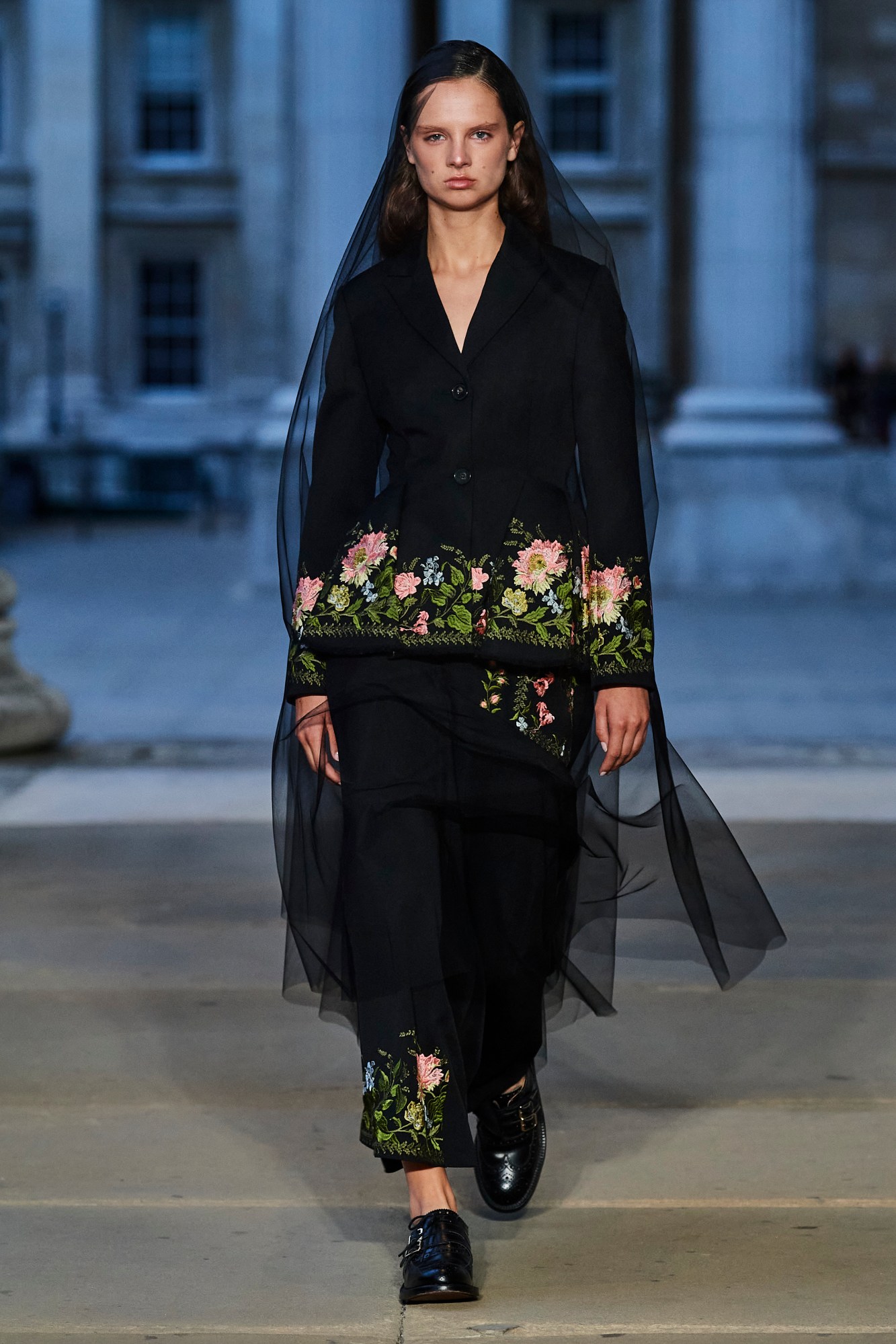
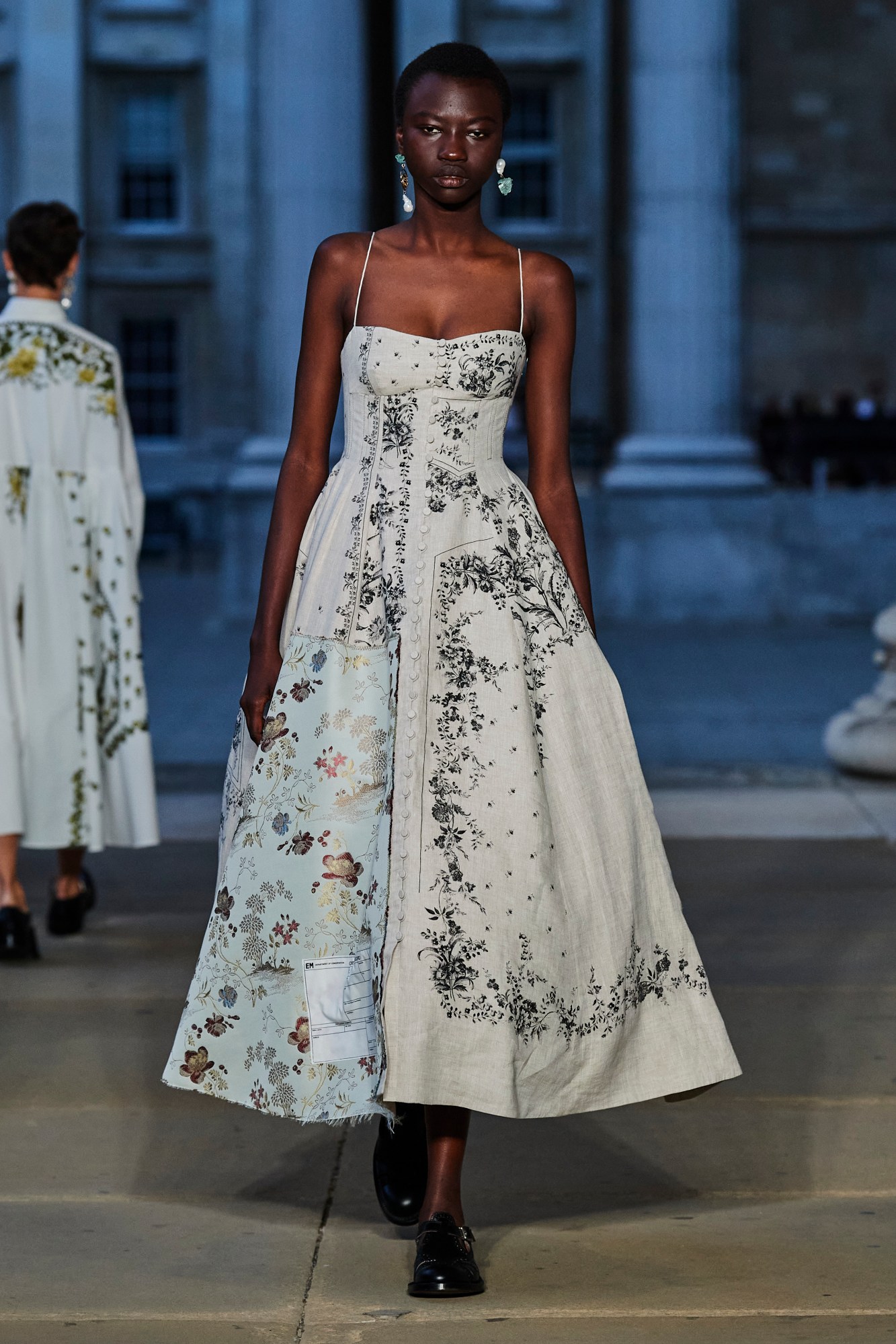
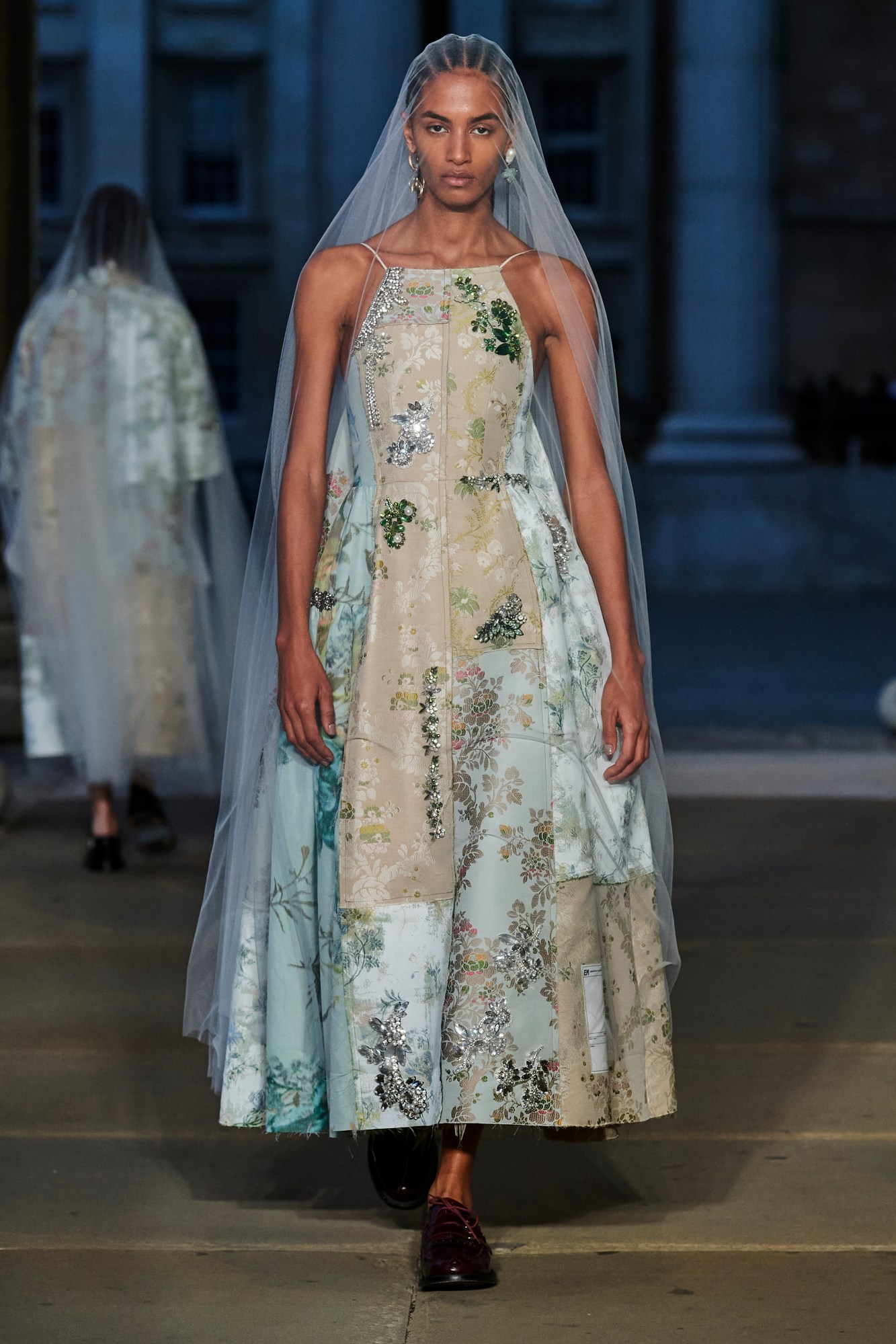
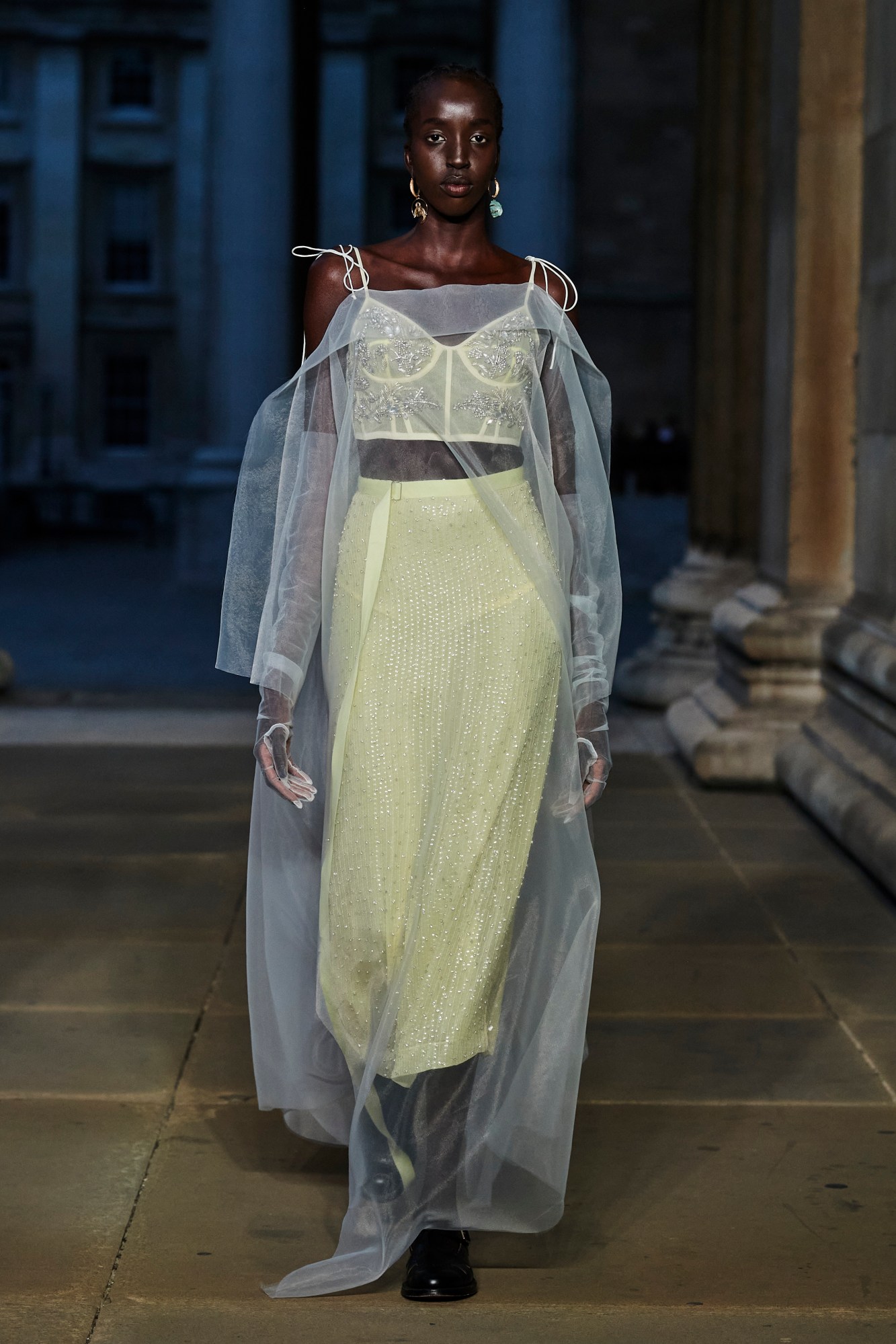
Erdem
The three black veiled looks that closed out Erdem’s SS23 collection will probably get the most attention. This was a show staged on the eve of Queen Elizabeth II’s funeral, and the mournful black veils, worn over monochrome floral-embroidered tulle dresses, ended on a sombre note. It opened with another black veiled look, this time worn over a black jacket, decorated with a remnant of 18th-century floral embroidery. But in between these funereal openings and closing the collection was anything but – instead, what we saw amounted to a languid, historically minded, look at the power of beauty.
Staged under the neoclassical Portland stone columns of the British Museum, this was a collection inspired by the art restoration that goes on within the museum, with Erdem spending time observing the restoration teams at the Tate, the V&A and the National Gallery, as well. “The collection examines the space between care and obsession in the pursuit of preservation,” the show notes explained. So there were the remnants of embroidery that popped up across the collection, prints based on the works of old masters, but they were subdued and ghostly, these historic masterworks haunting their current iterations at garments, or alternately resplendent in a flush of improbable newness.
In these institutions, Erdem and his team witnessed 18th-century embroidered dresses being revived, and a 15th-century oil painting being restored using a 17th-century Dutch etching of the painting as a guide. Through its observations of how these artistic residues become new again and are reborn, it was really a collection about how the past and the present interact, how we remember and conserve, the passion and creativity of those with the responsibility to guard our artistic heritages. “Restoration is not only about repair,” the notes explained, “It is an immersive act that asks one to see and feel through the eyes of others, too.” FP
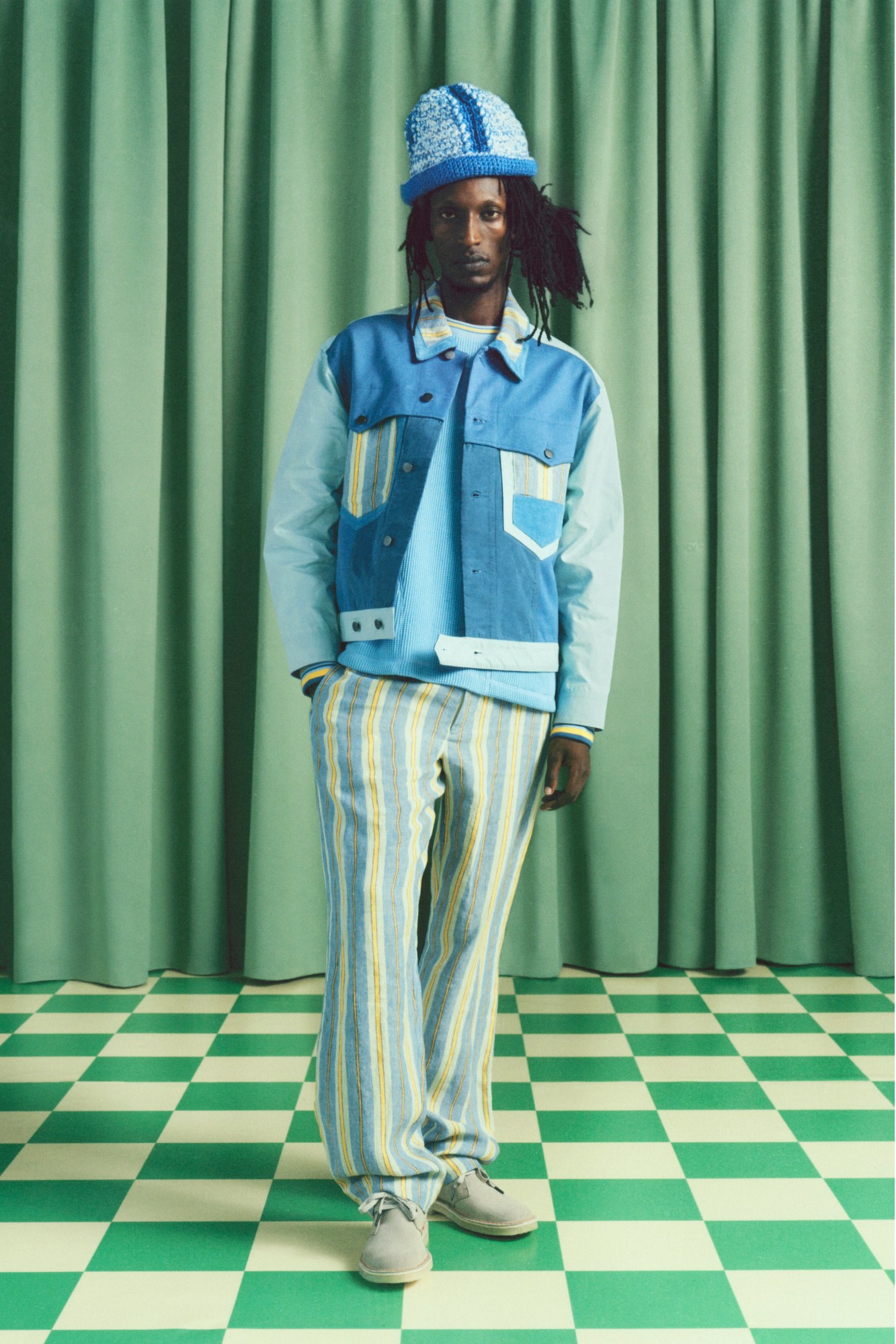
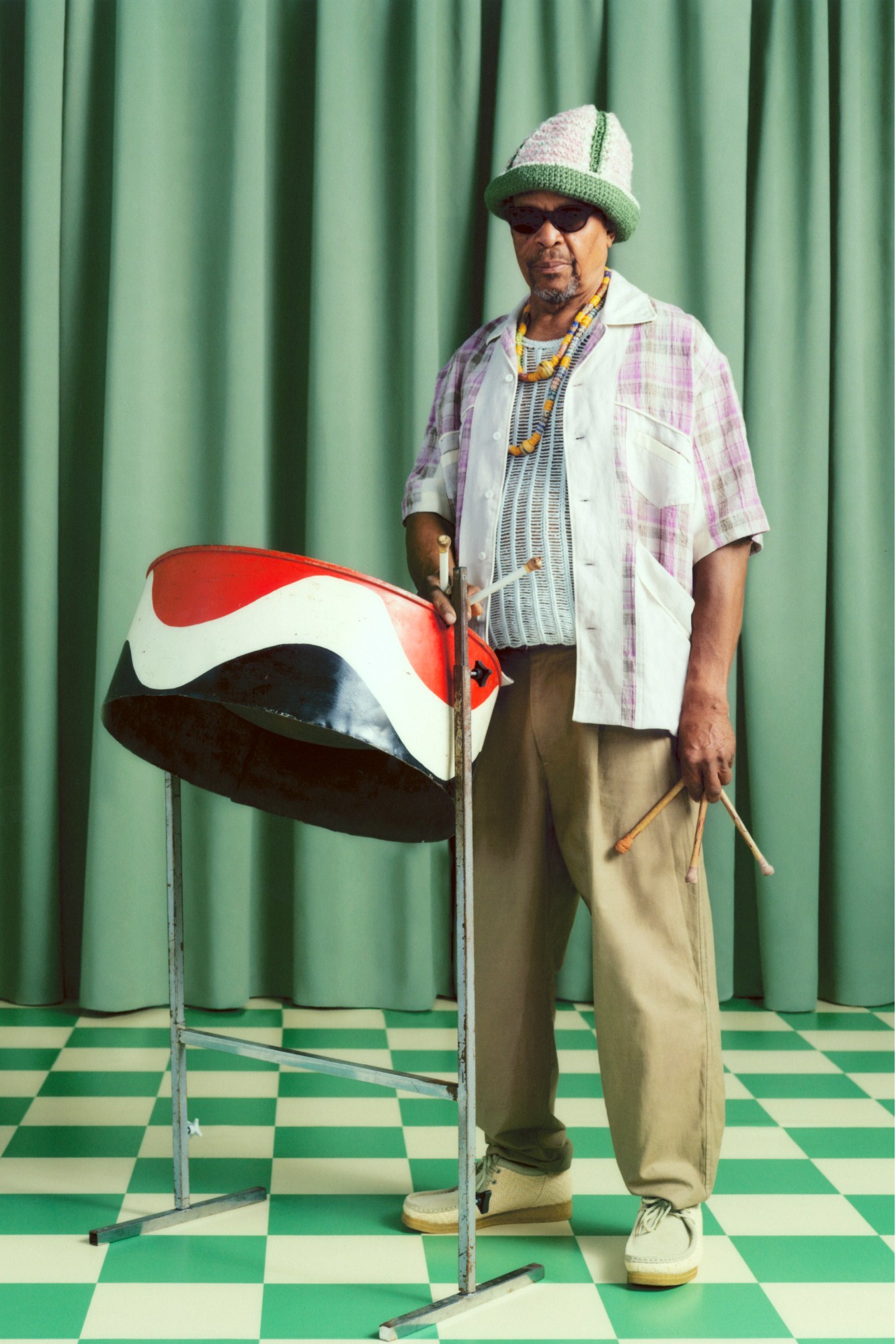
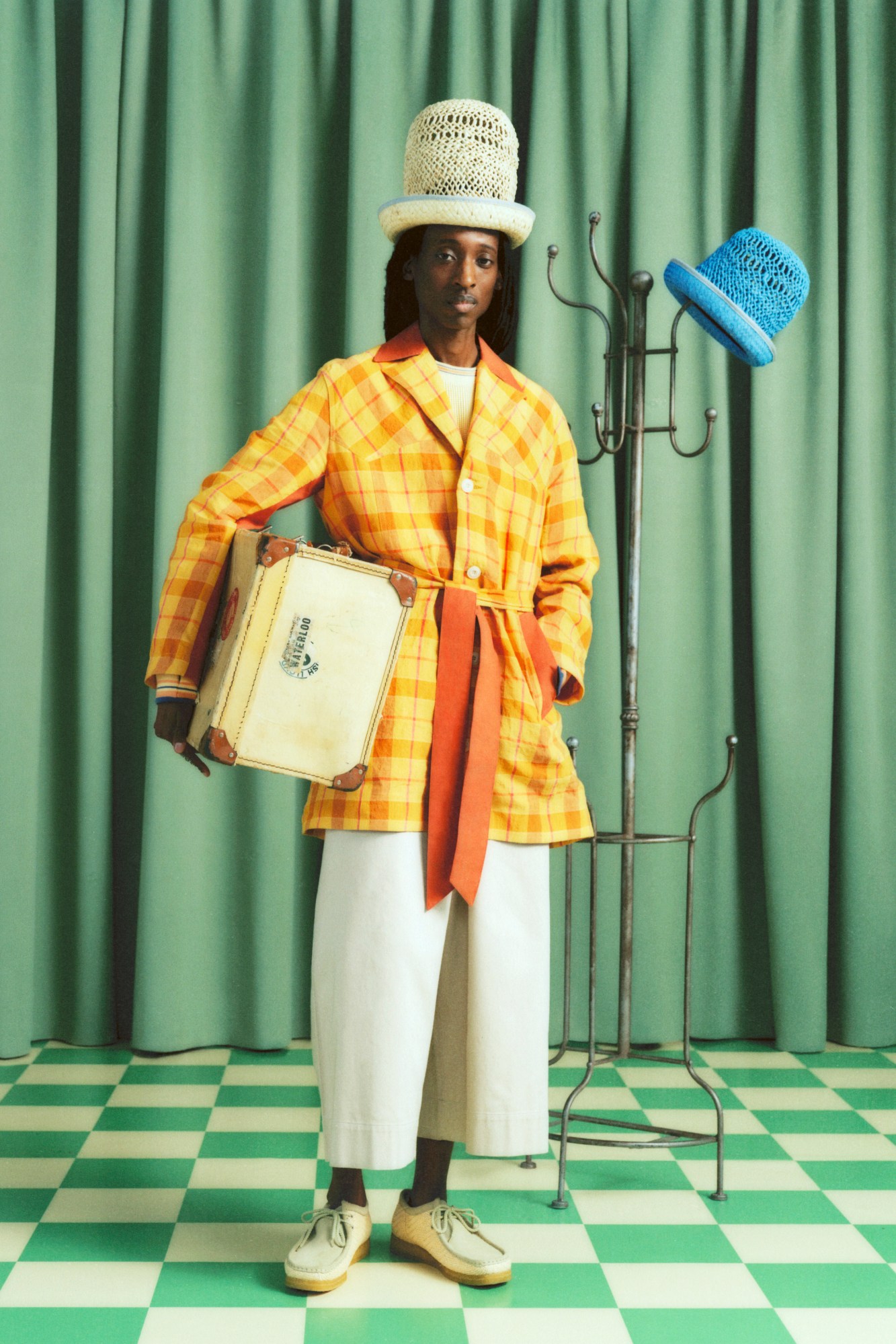
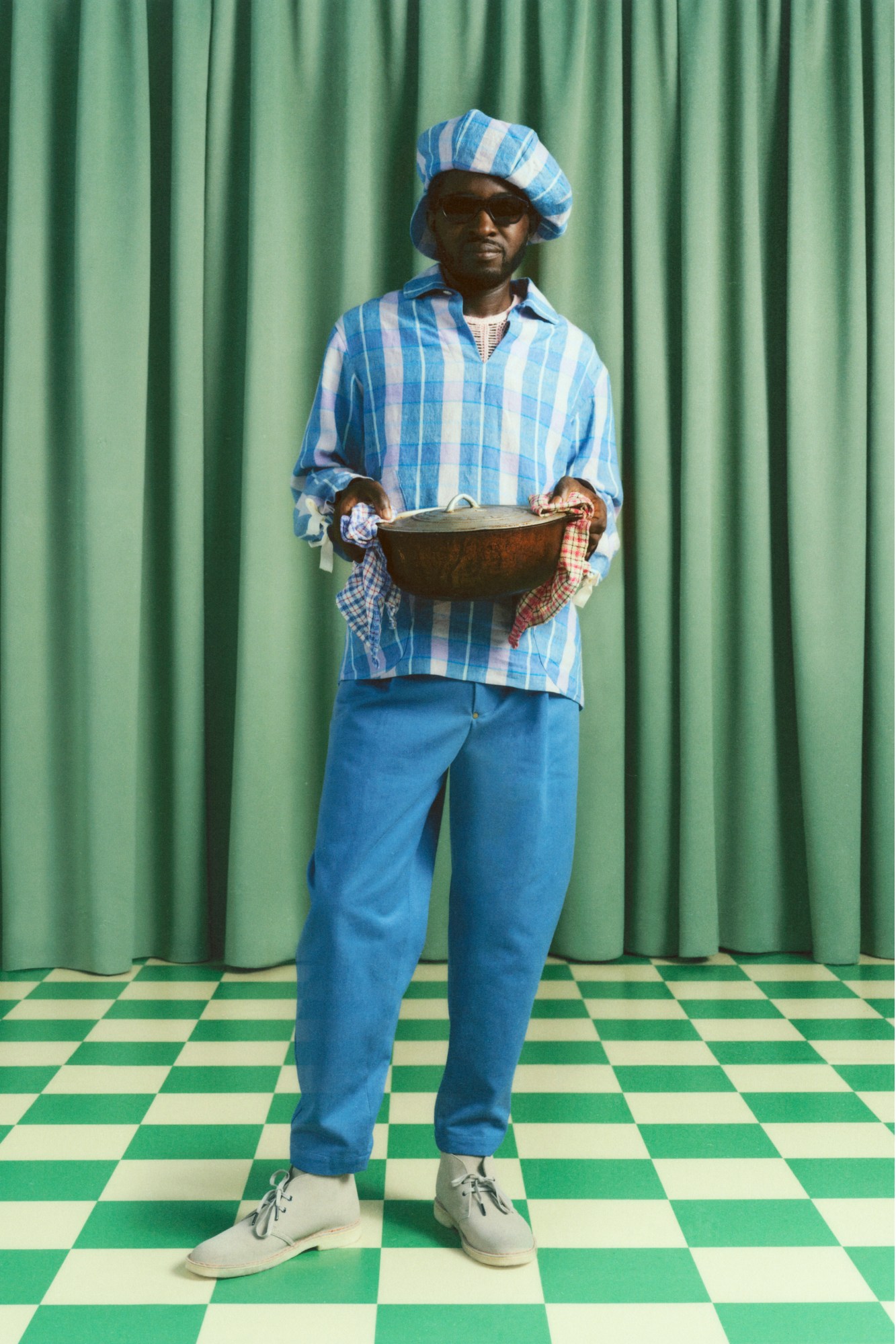
Nicholas Daley
Anyone familiar with Nicholas Daley will know that music – in particular the unfathomably vast canon of Black folk music – forms the bedrock of his eponymous brand. This season, of course, was no exception, with the designer taking the rich history of Calypso music as his point of departure, looking to the creative output of actor, singer and activist Harry Belafonte as a focus. Common formal ground was found in what was described in the show notes as “calypso’s uniform” – wide-legged, high-waisted pants worn with roomy, wide-lapelled shirts, and brightly hued beanies and tam caps. The textured hues of Althea McNish’s textiles and Sonia Boyce’s paintings informed the collection’s pale of oceanic blues and warm citrus tones, while florals bloomed into Nicholas visual repertoire for the first time, appearing in intricate Japanese embroidered fabrics and a luxurious silk jacquard created by with English weaver Stephen Walters. Elsewhere, Nicholas’ yen for collaboration resulted in graphic motifs create by two young artists, with the self-taught Ethiopian-Norwegian artist Olana Janfa creating bespoke monograms and typefaces inspired by Ethiopian orthodox art, and London-based Kione Grandison creating the steel pan logo seen across this season’s jersey pieces. A collection that inspired feelings of celebration, and one well worth celebrating. MS
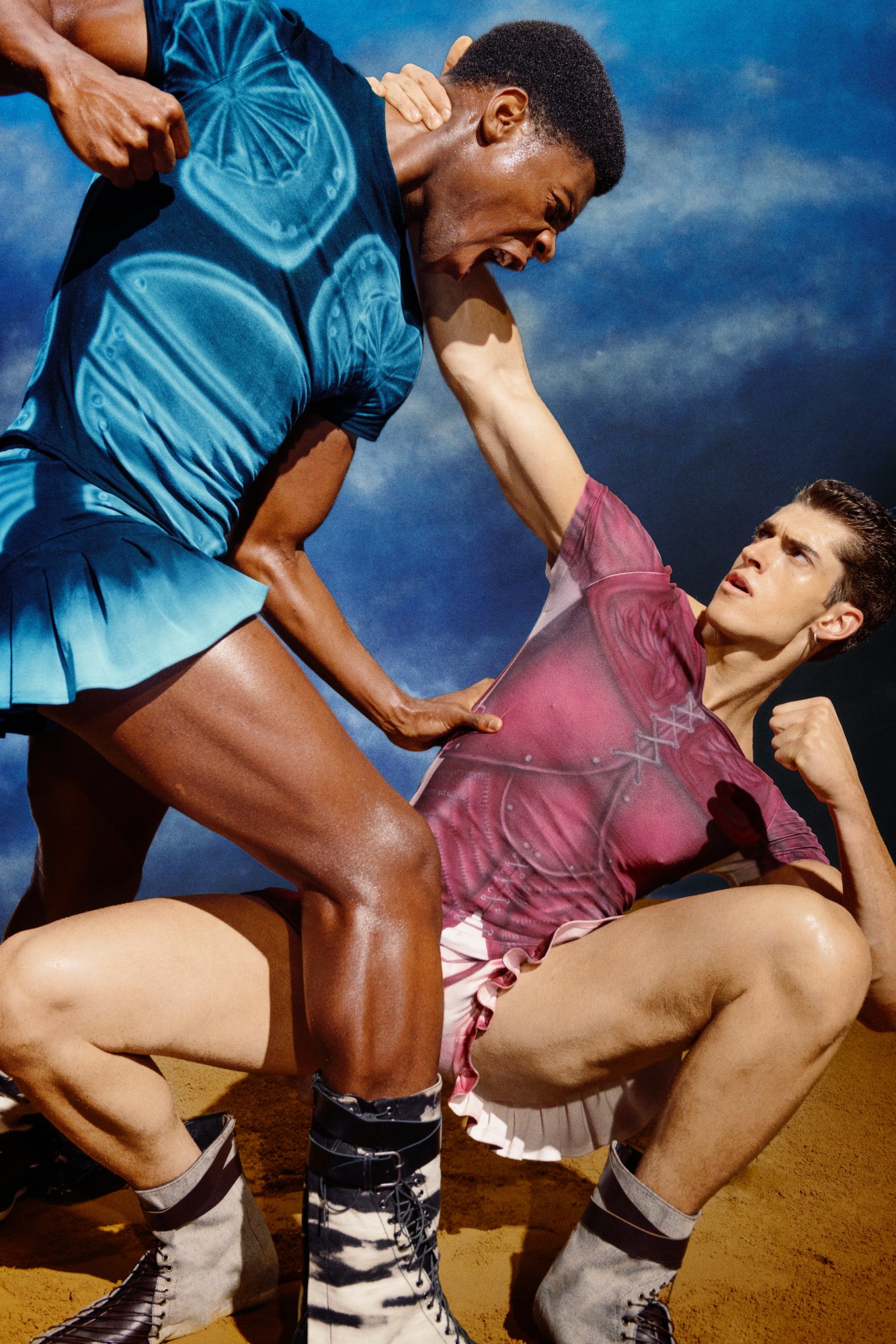
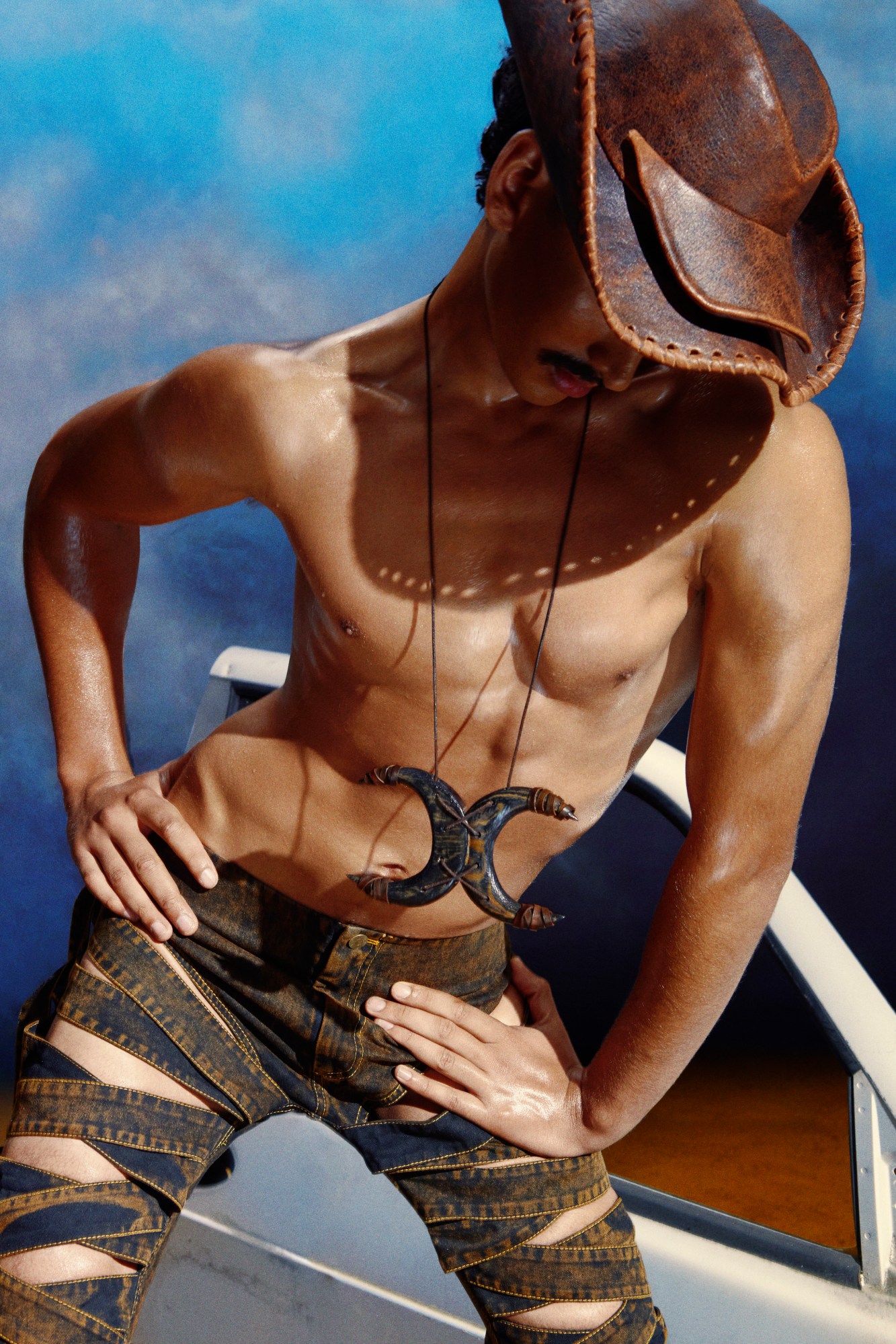
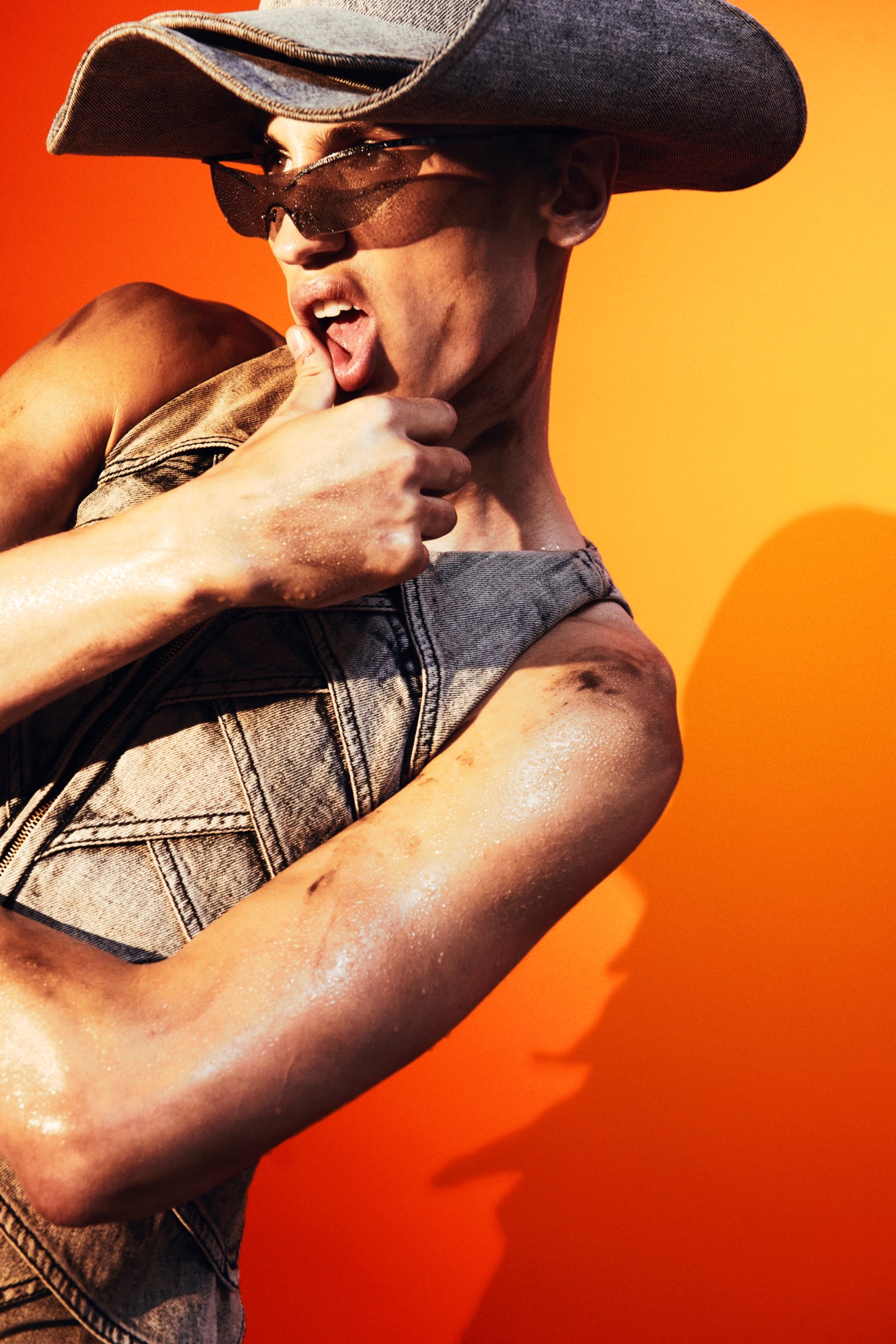
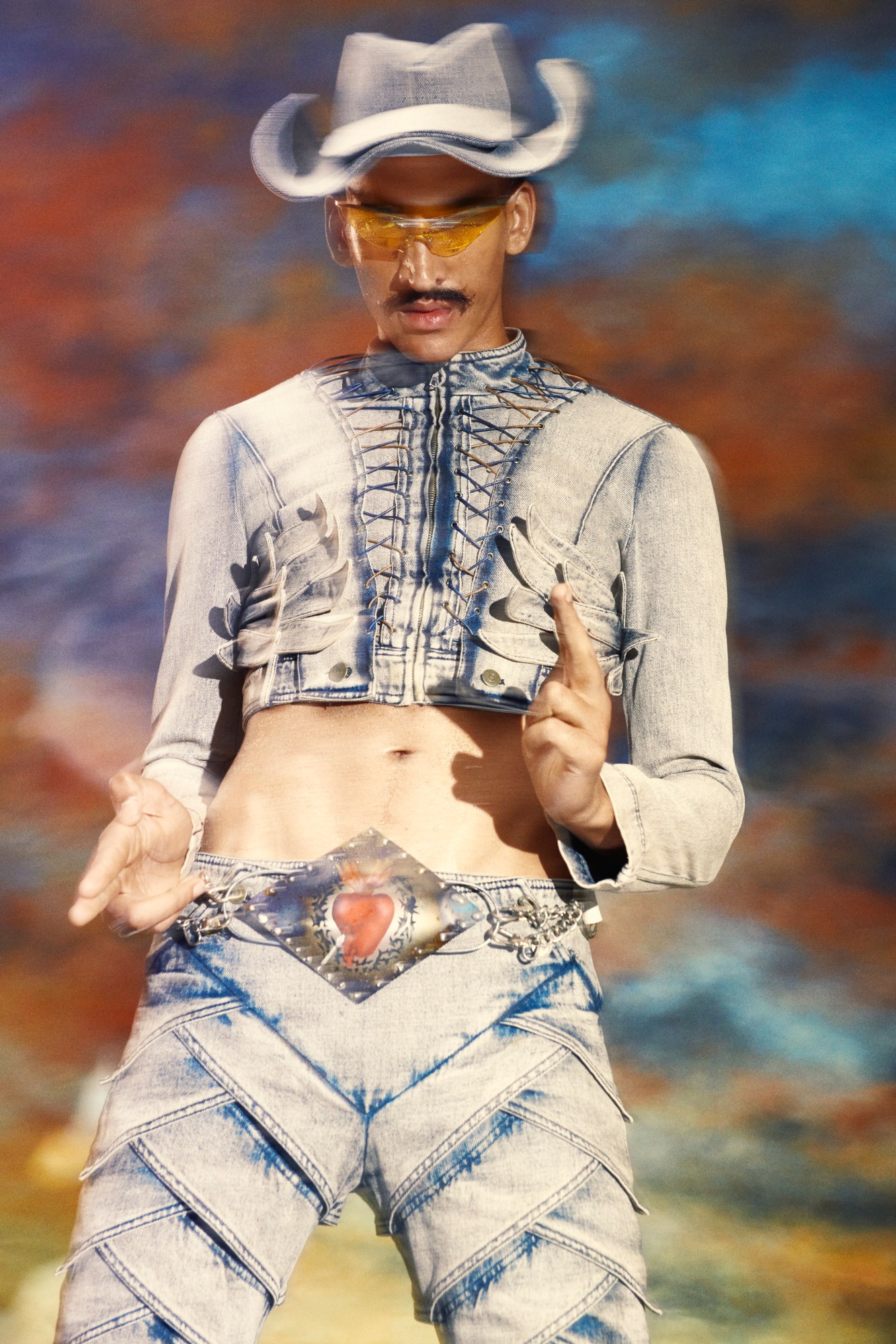
GOOMHEO
CSM and Fashion East alum Goom Heo has become one of London fashion’s rising stars with her oft-dark explorations of masculinity through a futuristic, even apocalyptic, lens. Inspired by the homoerotic photography of Karlheinz Weinberger in the 50s and 60s of rebellious Swiss male youth, the fashions they wore and the dissociative facial expression, GOOMHEO’s SS23 collection, “Dystopian Beach” — the campaign for which was shot by Heji Shin — continues her legacy, turning to traditional menswear tropes and reimagining it for the unrestrained men of today. Accessorised with oversized belt buckles, the denims of gun-slinging cowboys are acid-washed, frayed and crisscrossed, either loosely to form a chaps-like silhouette, or tightly like a reptile’s scales. One-piece ensembles, topped with cowboy hats, are made up of a revealing black bondage jumpsuit or missing leg and sleeve halter jumpsuits. Gladiator’s armour is replicated in printed fitted tees and inky denim vests with golden stitching, both then replicated in shorts with billowing ruffle legs and stone kilt-like skirts with structured jackets. Finishing the collection was Goom’s first foray into eyewear with sleek frameless motor shades. Cars, cowboys, gladiators and fistfights: hyper-masculinity at its most hysterical, but make it chic. TG
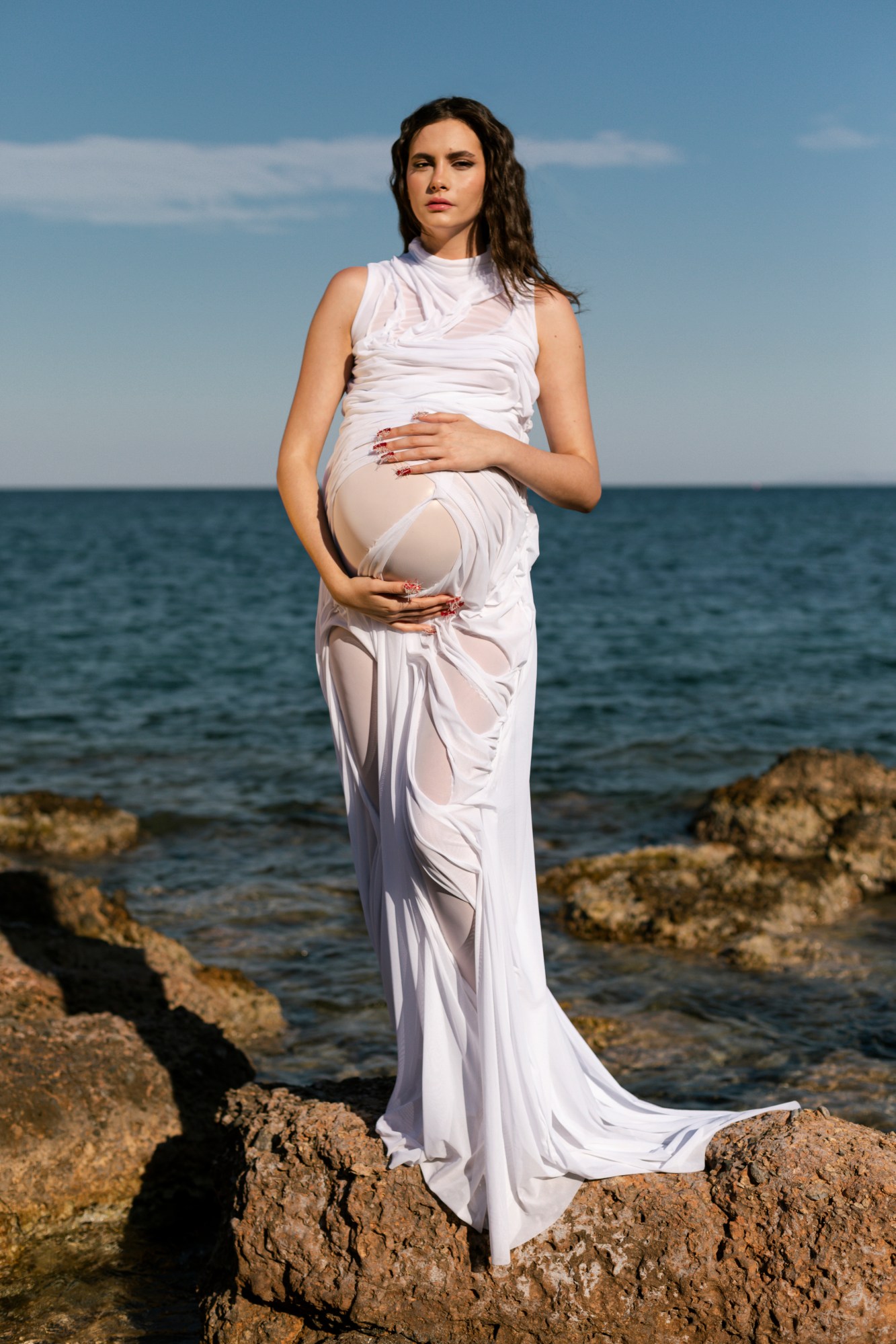

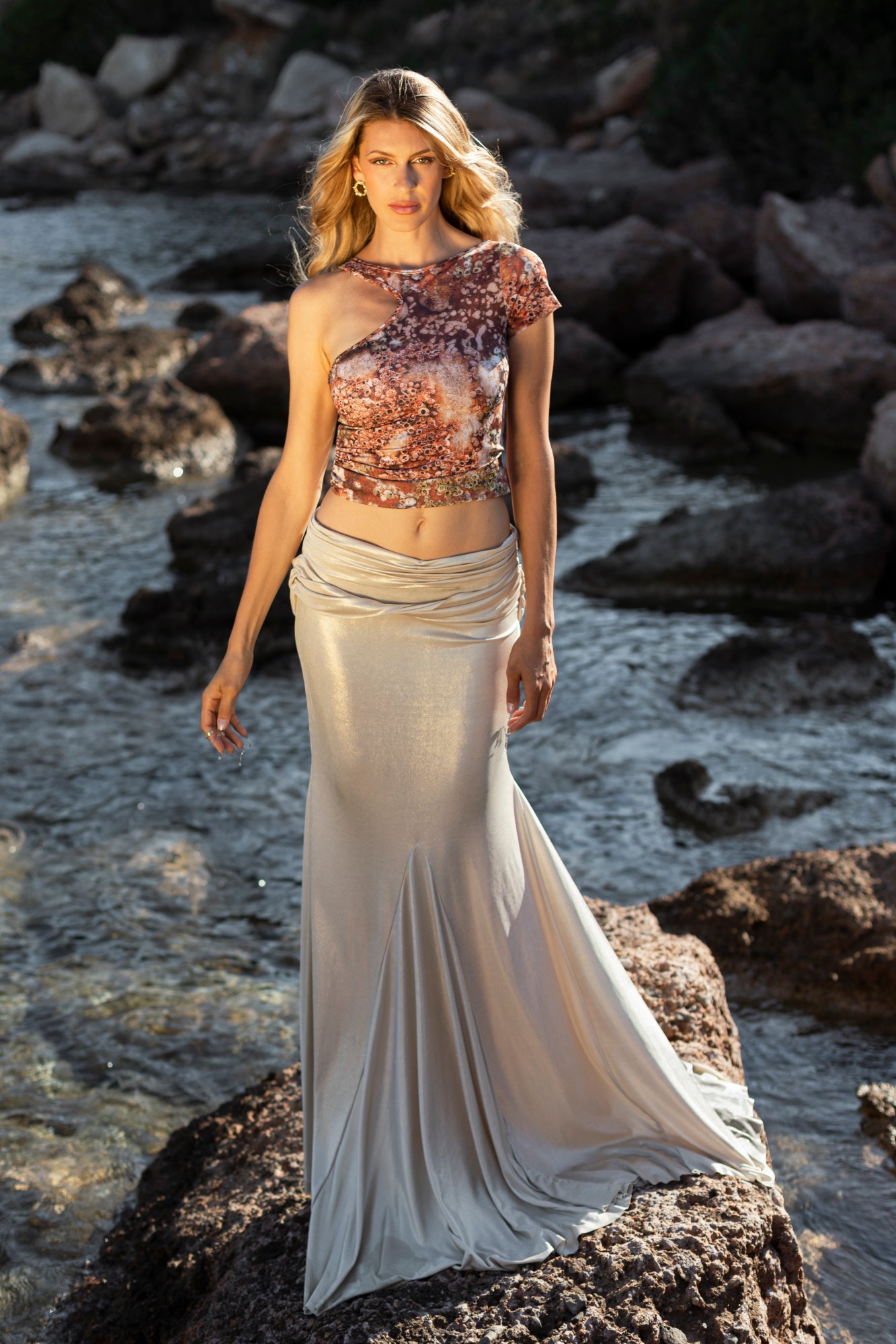

Di Petsa
Continuing with her Grecian goddesswear for SS23, Di Petsa turned to the Dionysian Mysteries for her collection presentation film. The ritual of both ancient Greece and Rome – using wine, music and dance to liberate one of their social inhibitions and unlock their true, natural state – becomes the focus of the main character of the film Aurora, a poet struggling with writer’s block who turns to the divine to search for the words deep within her. The result is a lookbook where a kaftan and bodysuit in metallic lush oceanic blue silks ripple like the Mediterranean; regal gowns in the brand’s signature wetlook fabrics cling to the body beneath in places and billow in the wind in others; and fitted slip dresses, low-rise jeans and bandana tops are adorned with an intricate print of the birthing of Venus or a design inspired by washed-up terracotta pottery found along the shore. With jewel-toned hues in the offering and stones and crystals within gold chains strung across the models’ bodies, Di Petsa SS23 is all about healing, whether that be derived from a divine source or manifested from the beautiful serenity of the earth around you. TG
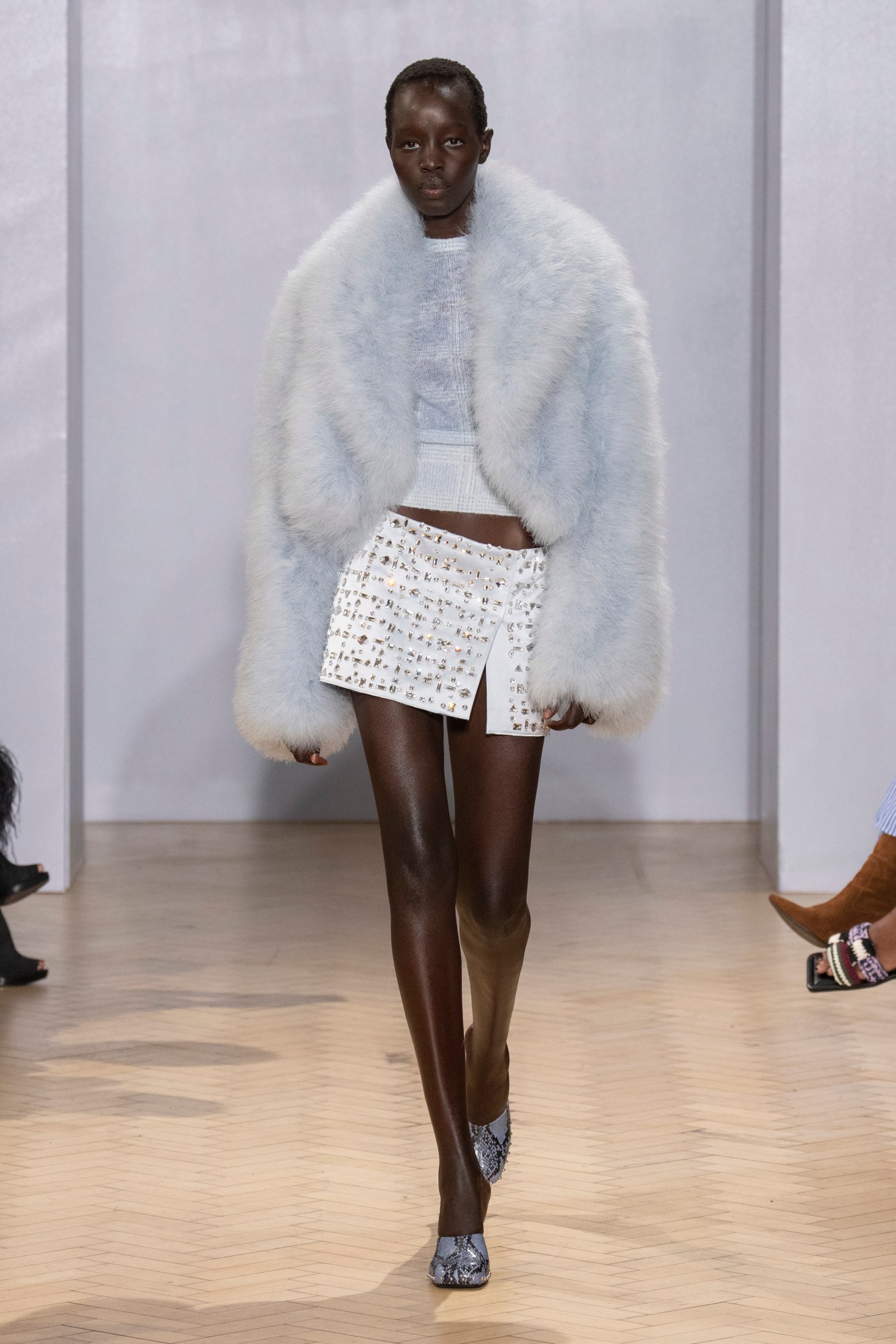
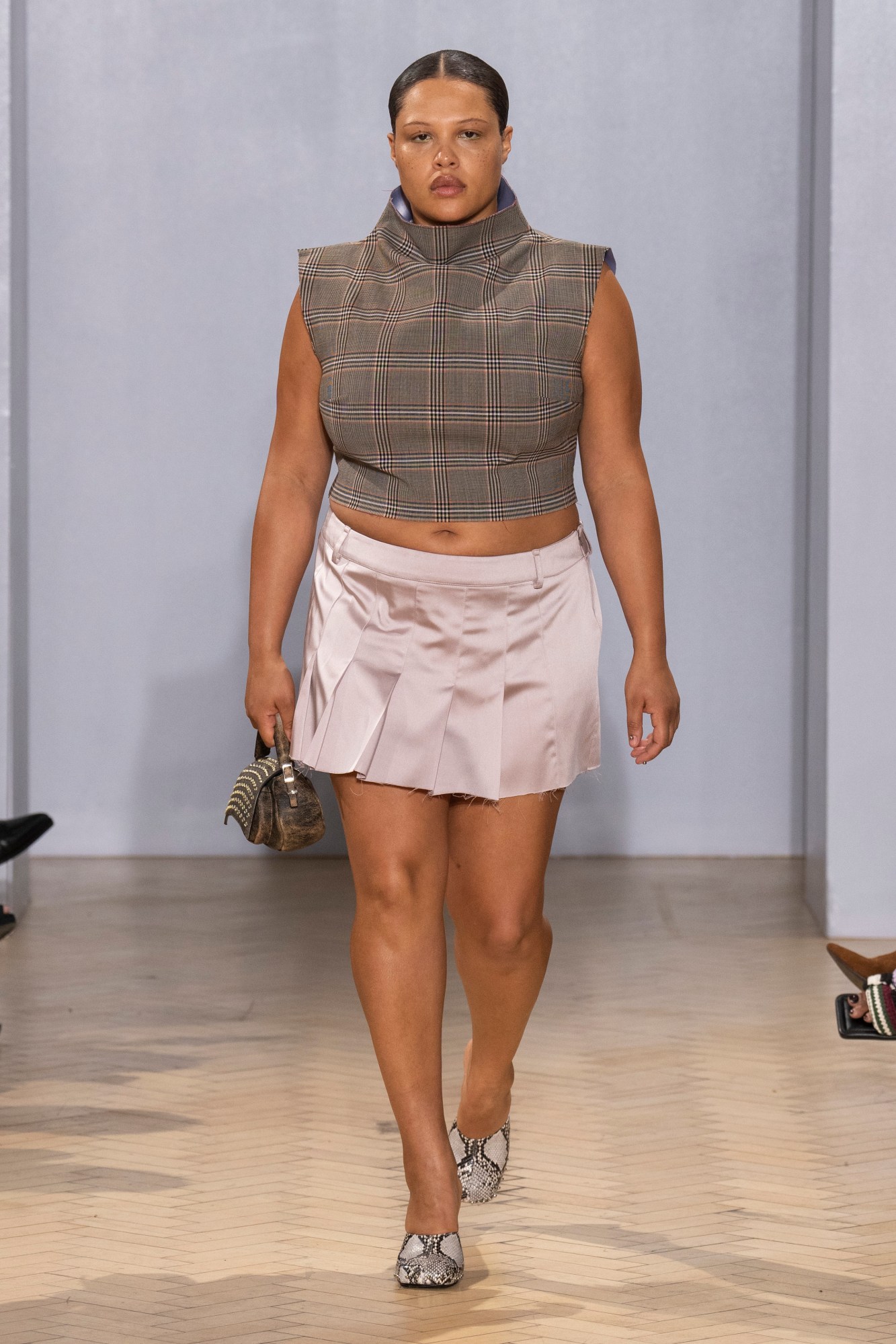
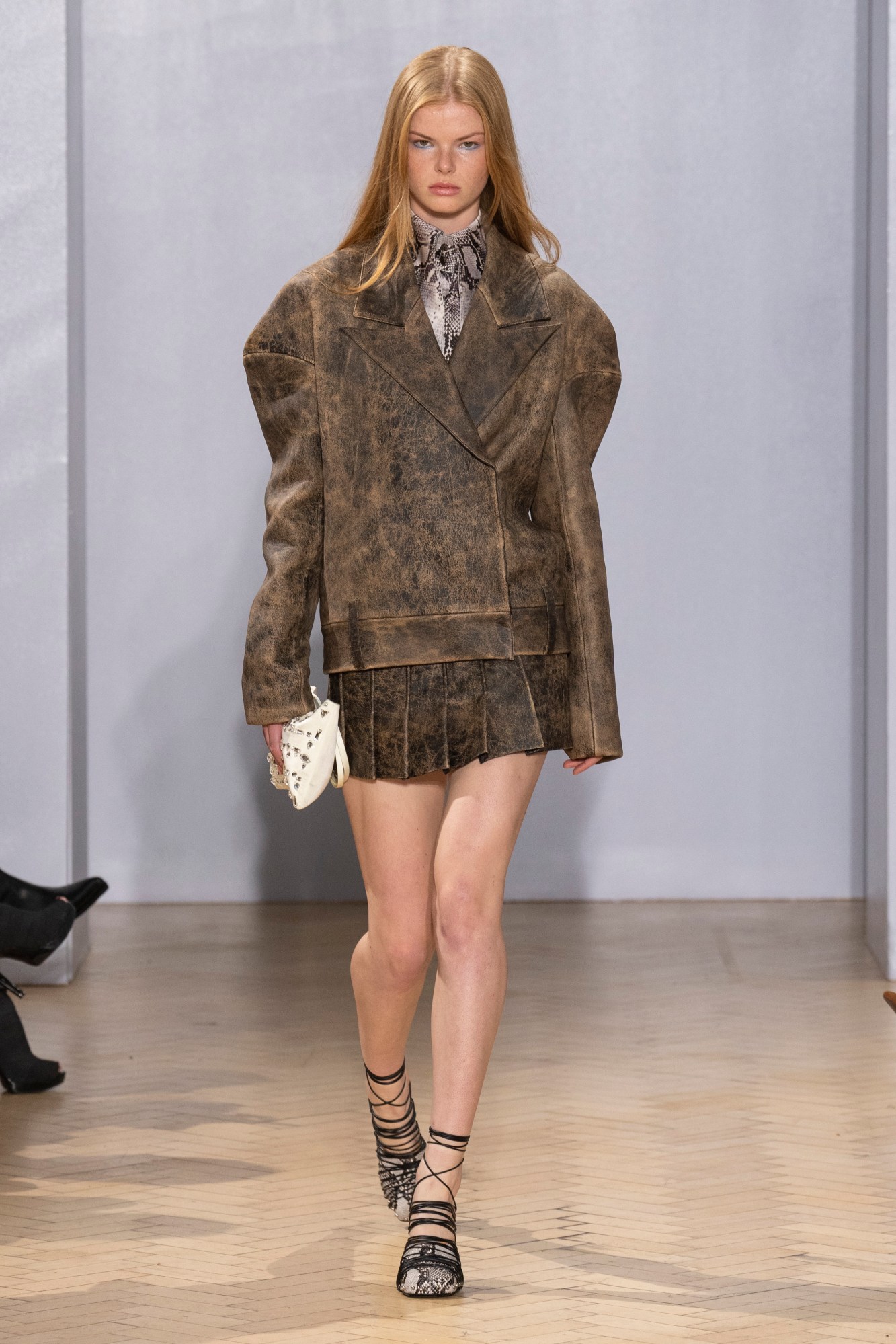
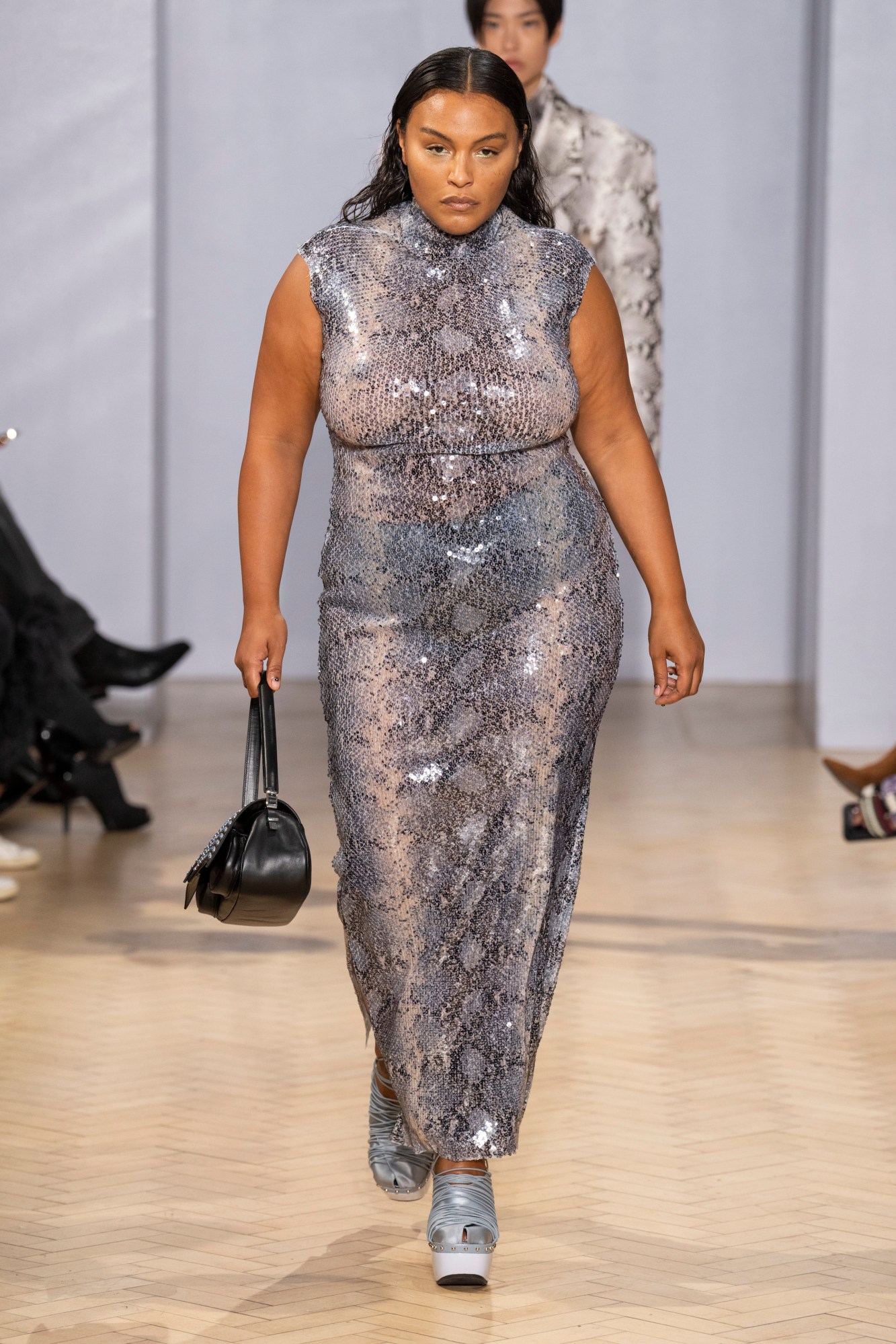
16Arlington
The air at 16Arlington’s SS23 show – staged in a light-dappled hall in Bloomsbury – was steeped with a complex blend of emotions. Though tinged with a mournful energy – this was, after all, the first collection that the brand would be presenting in which its late co-founder, Kikka Cavenati, had not been creatively involved — a palpable sense of lightness nonetheless made itself felt. An acknowledgement that, while Kikka may no longer be physically with us, her spirit and memory lives on though Marco Capaldo and the fiercely loyal community that has coalesced around the brand.
That was indeed the message that shone through in Forget Me Not, a collection that brimmed with strength, confidence and levity. Wide-lapelled faux fur jackets, crystal-strewn slashed satin miniskirts and diaphanous, shimmering column dresses came in cool, light blues, greys and lilacs, nodding to the collection’s namesake flower’s hues. A grey Prince-of-Wales check funnel neck dress and boxy borrowed-from-your-boyfriend blazers with contrast peak lapels exuded insouciant elegance, while jersey slip dresses and slant-shouldered jackets in snakeskin prints suggested a more party-ready flair. A toughness came through in wrapped jacket and skirts combos in beaten up tobacco leather, and energy that was counterposed by the elevated glamour of an expertly cut leather coat decked out in symmetrically aligned crystals. Indeed, a collection that we won’t be forgetting anytime soon. MS
JW Anderson
The crowds were out in full force last night in Soho. The central London neighbourhood, with its narrow streets and neon-lit gay bars, has long been a melting pot of out-of-towners, nocturnal partygoers, and the colourful cast of local celebrities (varying from Hare Krishnas to legendary drag queens). It’s also the neighbourhood where Jonathan Anderson, too, would spend his Saturday nights as a young fashion student and almost two decades later, opened his flagship JW Andersonstore, which is nestled amid arcades, dodgy massage parlours and queer watering holes. Amid the chaos of rickshaws and bar dwellers, Jonathan staged his SS23 show for his namesake brand in the Las Vegas arcade, a 24-hour spot lined with slot machines and candy-coloured gaming consoles. Read our full review here.

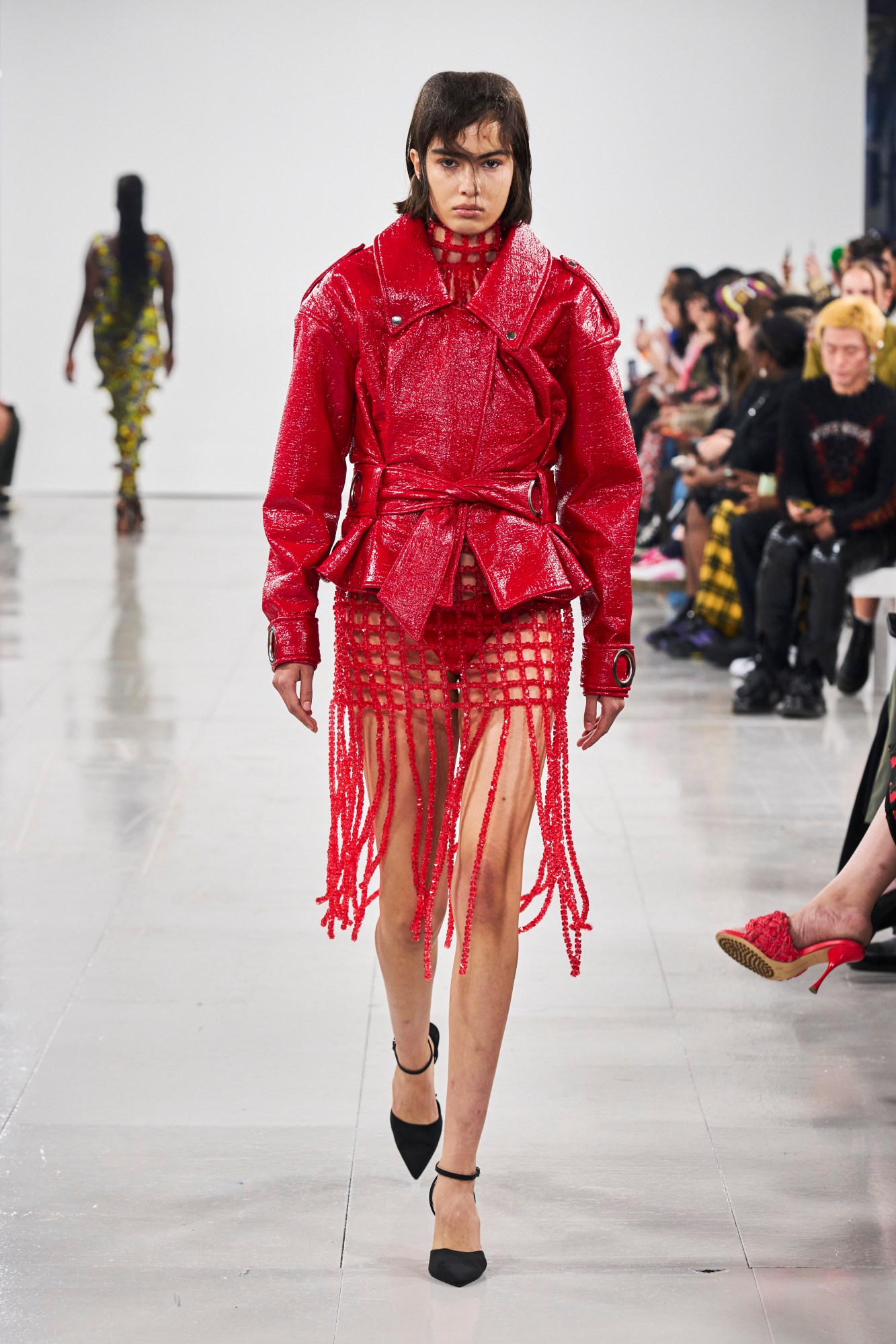
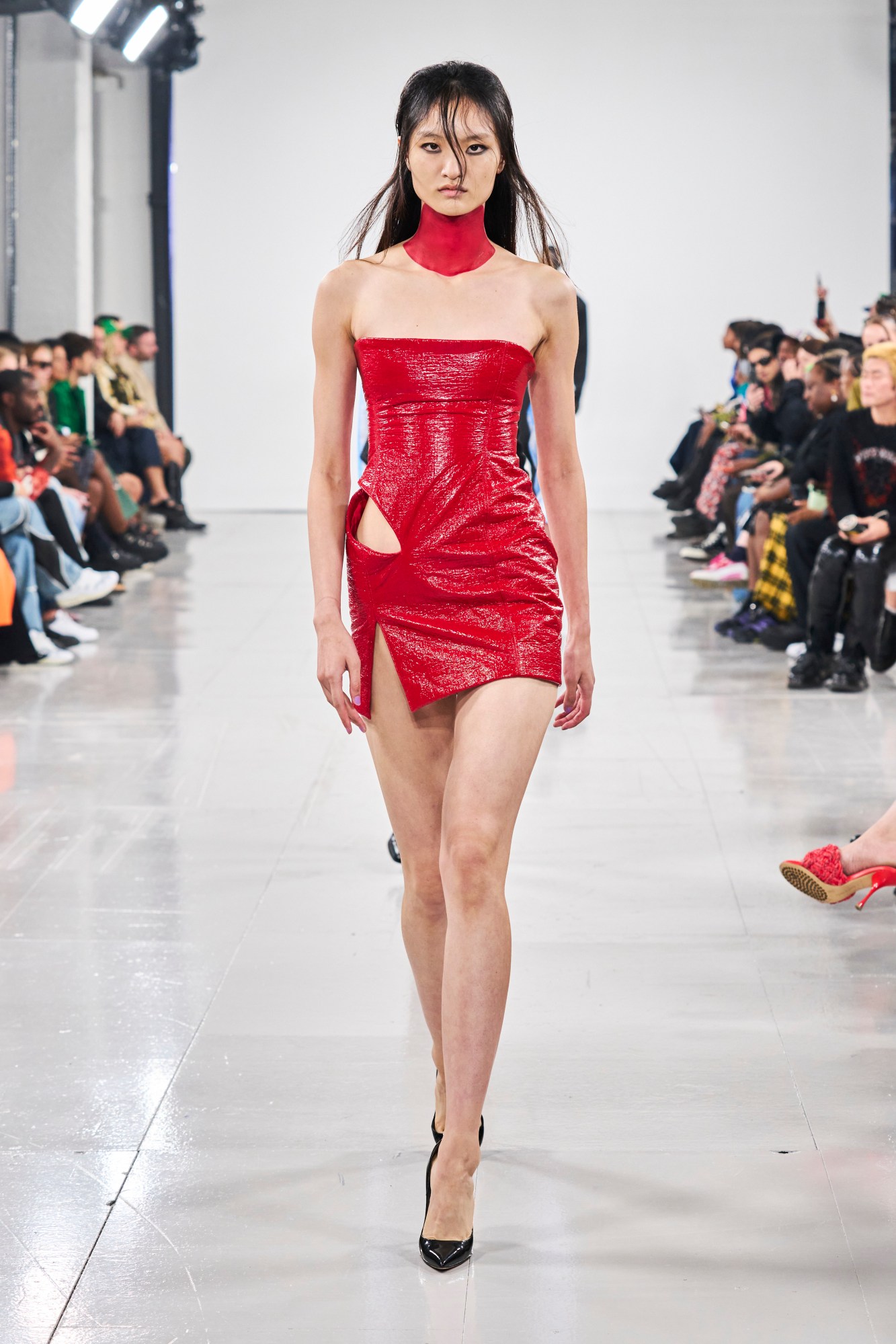
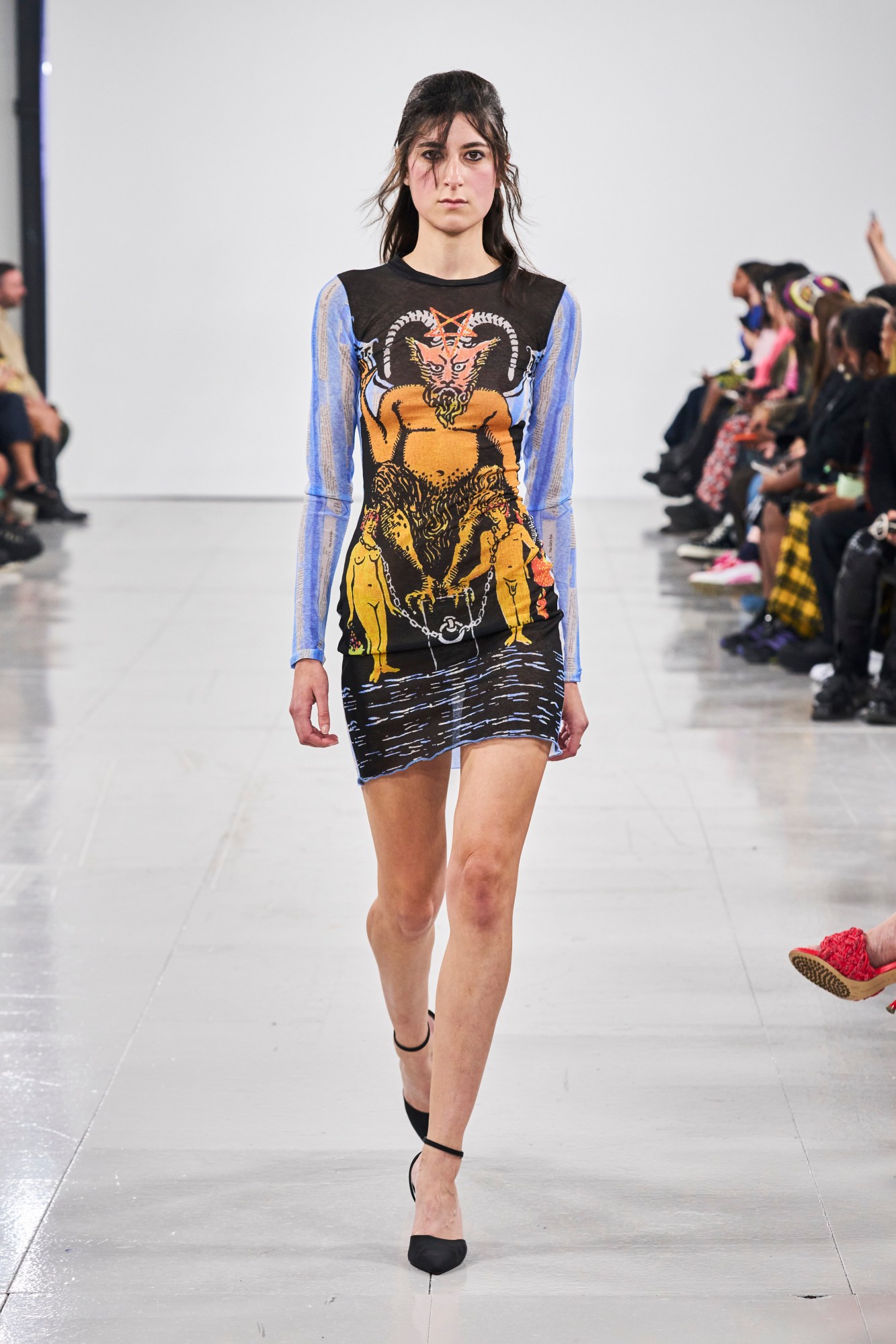
FEBEN
With the omission of certain heavyweight figures from the offerings this season, the city’s runway debutantes have been holding their own nonetheless, and bringing us some of London’s most must-watch moments. One of the names we’ve been most excited about in the run up to the week is, naturally, FEBEN, the NEWGEN recipient who, on Saturday, presented THE READ – her very first catwalk collection. Where previous work of hers ruminated on the whirlwind of emotional turmoil that so many of us have experienced over the past few years, this season found higher purpose in the spiritual.
Drawing inspiration from tarot cards, models walked an incense-bathed runway laid out in the formation of a Celtic Cross wearing deliciously textural looks that oozed a confident sensuality – and at times a brazen, domme-y sexiness. While literal translations of tarot motifs appeared in the form of devil-bearing mesh tops and an eccentric print lifted from the back of the deck that Feben owns herself, her reading of the cards was altogether more figurative. The divine power suggested by cards like “The Tower” and “The High Priestess”, for example, informed tumbling puckered satin dresses, a grommeted mock-croc biker jacket and an almost-clerical tunic dress, while a more carefree, flirty spirit shimmered through in fringed beaded slip dresses and miniskirts – created in collaboration with artisans in Ghana – as well as cut-out tube dresses in scarlet PVC and flounced rara skirts.
Where that sexiness took on a darker tone was in the places you least expected it. Formal shirts, roomily draped and knotted dresses, and bandeau tops in a brushstroke-striped poplin, had a respectable air to them at first glance – peer closer, though, and you’d see that the white spaces had in fact been filled in with minute reproductions of passages from Georges Bataille’s Story of the Eye, a sordid tale of transgressive sexual revolt. It’s details like these that attest to the conceptual depth of Feben’s clothes, a depth that only truly reveals itself when you read between the lines. MS

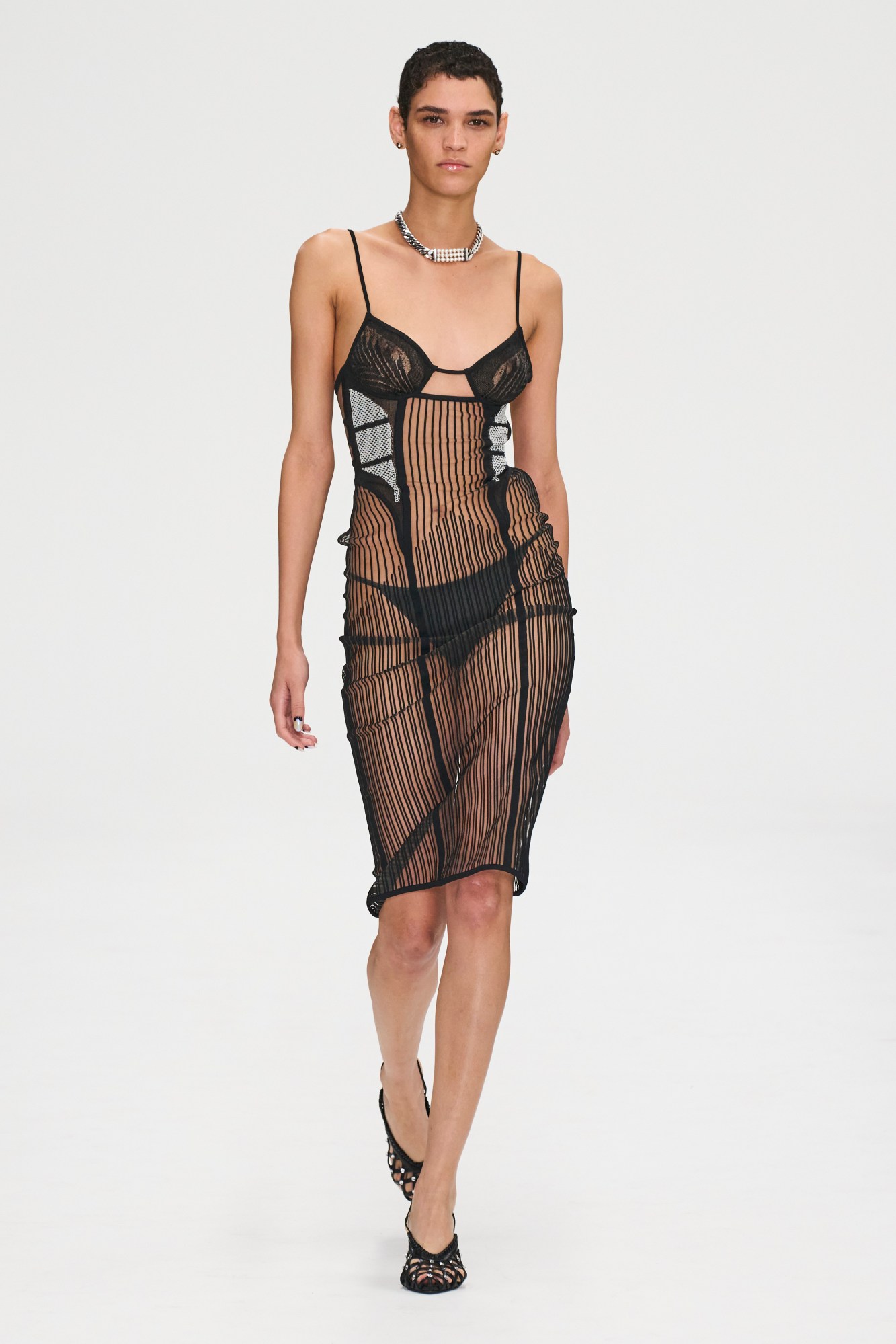

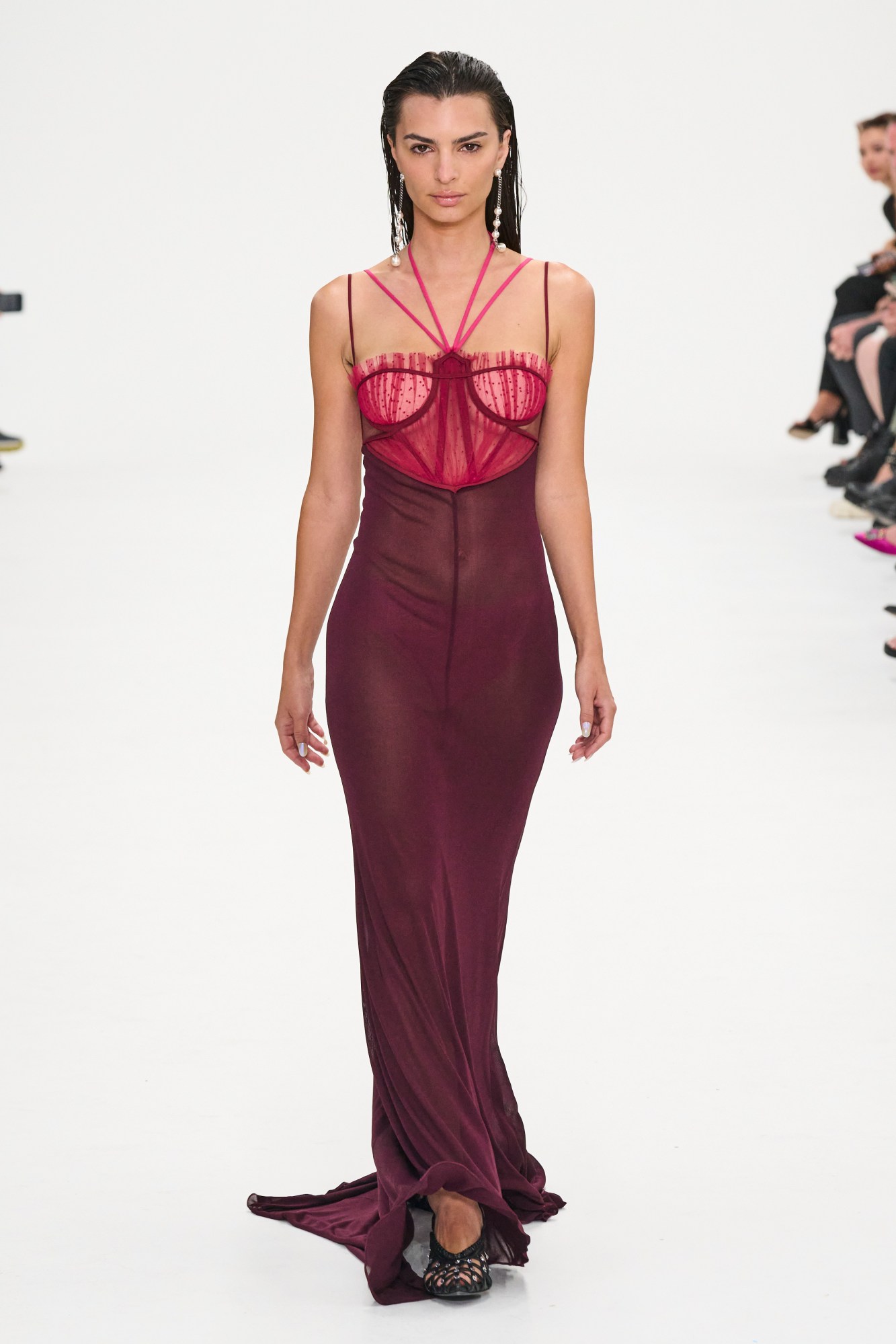
Nensi Dojaka
Nensi Dojaka knows how to make a great cocktail dress. It’s sort of her thing, crafting the most delicate pleats of organza and meticulously-placed panels of hosiery lace into cobweb-like contraptions for modern-day Black Widows. Wilting wallflowers, these are not. After all, it takes a lot of confidence to wear barely-there dresses that leave little to the imagination. And judging by the crowd at Nensi’s second standalone show — which took place at 10AM on a brisk Sunday morning, in a suburban neighbourhood — there are plenty of women who wouldn’t think twice about baring the cold in nothing more than see-through scrims suspended from spaghetti straps.
That might be because there’s something about Nensi’s vision of femme fatales that feels like a refreshing tonic to the grand tradition of mysogistic imagery of women in short skirts and bralettes. Her women choose to dress that way, dare to own their own sexuality, and relish in the intricate beauty of her craftsmanship. For her SS23 collection, the Albanian-born designer added to her repertoire without veering too far away from it. Vittoria Cerretti opened the show in one of the handful of black minidresses — by now, a Nensi Dojaka signature — and it comprised little more tan artfully jaunty lace bralette cups, asymmetrically-placed rouleau straps and a lace-spliced body-con skirt. It made clear that though the concept might be simple, the construction is anything but — which is why, despite many attempts, her dresses remain impossible to imitate.
Besides, how they’re made is precious and responsible. Throughout the collection, Nensi used fabrics from Nona Source, LVMH’s initiative for offering its deadstock fabrics for fashion’s new generation of up cycling designers. Most impressively, Emily Ratakowski’s finale dress, an oxblood chiffon and polka-dotted pink gown was entirely made from fabrics cast to the cutting room floor. Elsewhere, Nensi introduced some other new materials to her canon, challenging herself to incorporate lace into her typically structured dresses, while retaining its wispy lightness, and honing in on simmering wet-look lurex, too. The latter resulted in some of the more irreverent outings in the show: mottled leopard lurex slips (which Nensi put down to her sister’s recently adopted cat and a recent obsession with the photography of Jean Paul Goude) and glittering Discoball bandeaus and sequinned skirts for tearing up the dancefloor.
In fact, for spring, the Nensi Dojaka woman might actually be a bit more of a girl. Bubblegum pinks, lilacs and wired heart motifs that appeared on bralettes and the waistlines of jersey cycling shorts hinted at childhood nostalgia. It offered a counterpoint to the vixens in black; a little more sweet-hearted (literally) than, say, aggressively seductive. And what do Nensi Dojaka girls wear during the day, you ask? Jeans! The designer introduced bi-coloured ever-so-slightly-flared denim, the result panelling varying shades of the stuff, pairing it with a little bralette worn under a boxy black blazer in the manner of the very Y2K jeans-and-a-nice-top look. It still stands as ideal for the office, perfect for shedding a layer and going out out. For now, that’s what Nensi’s clothes are all about. OA

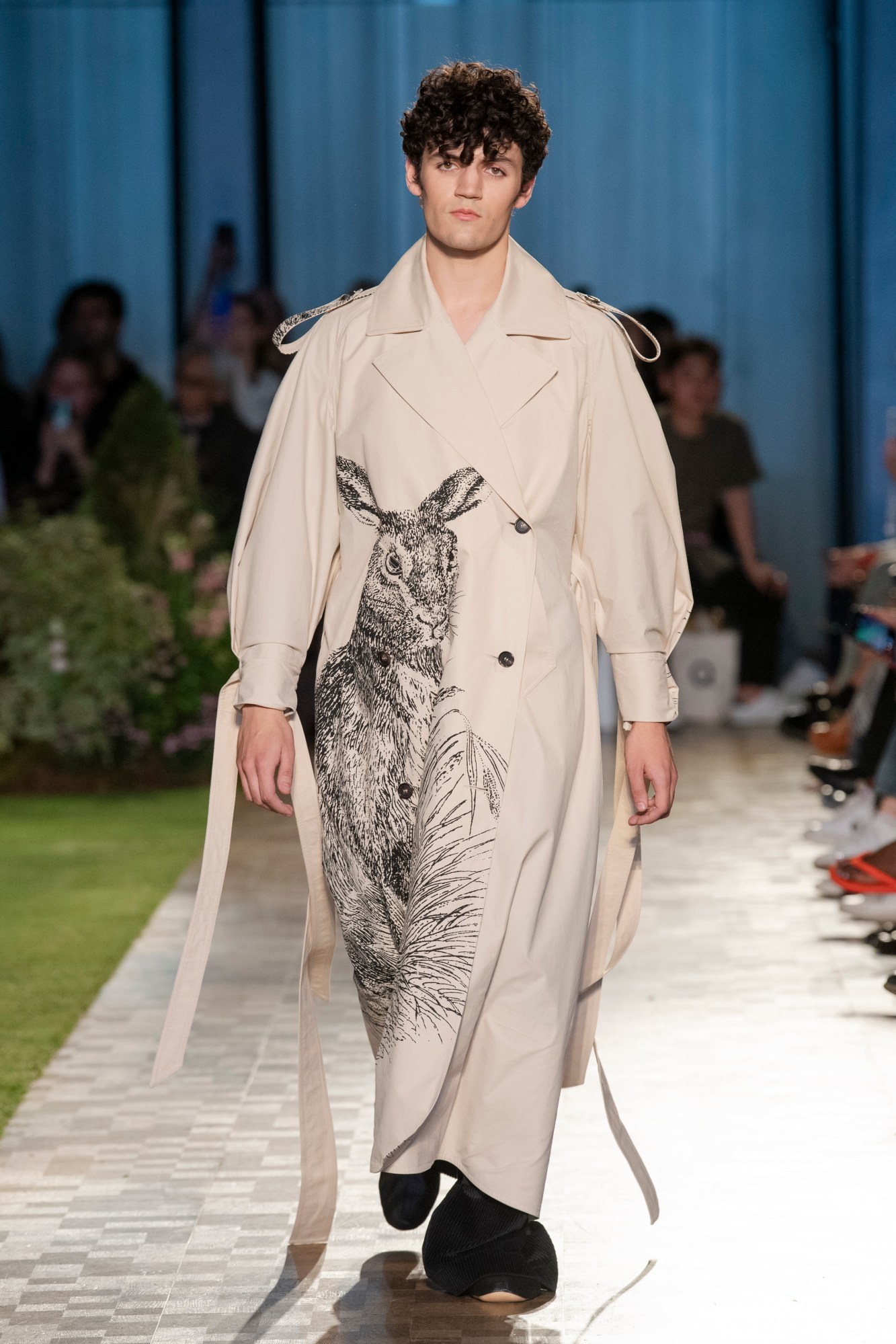
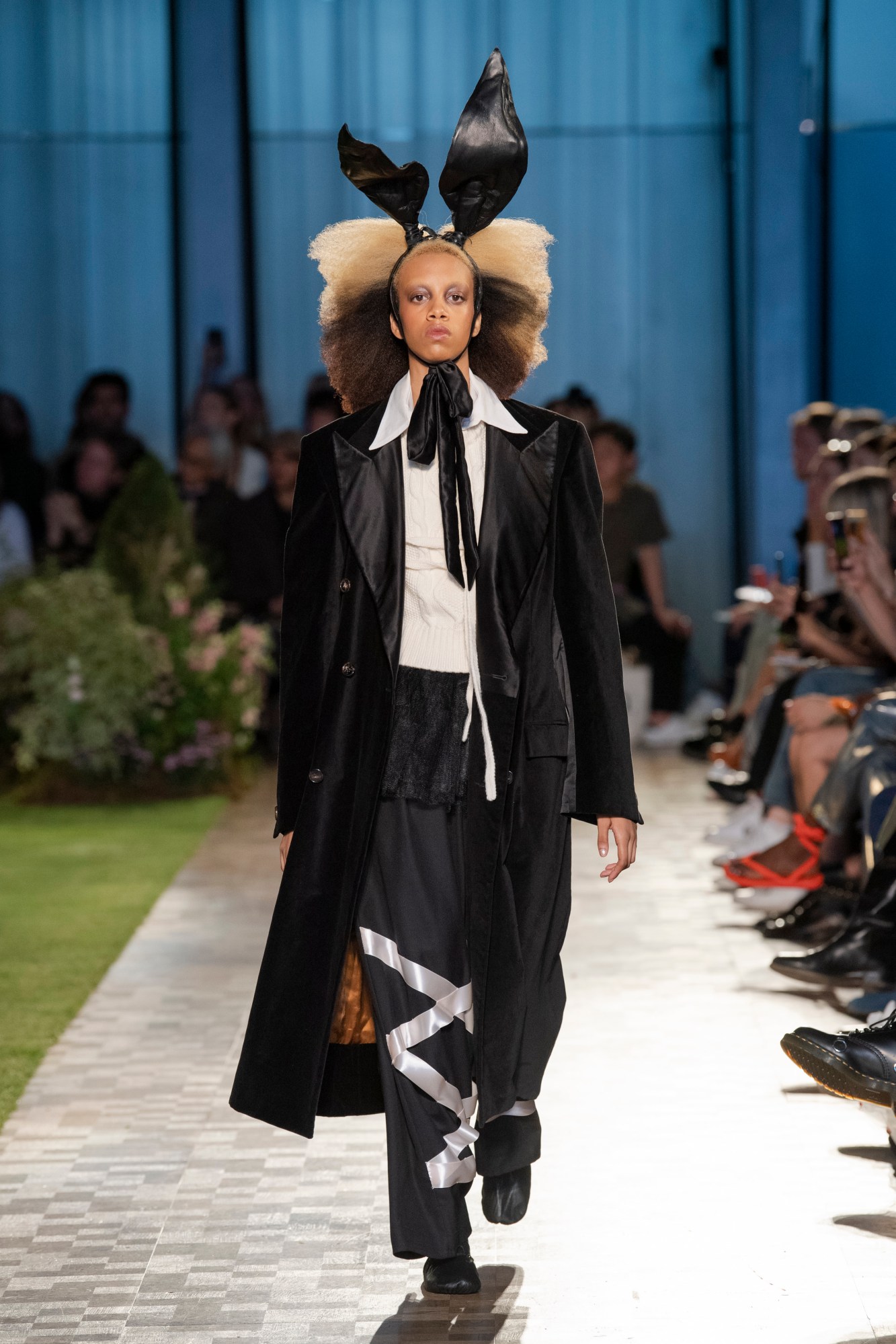
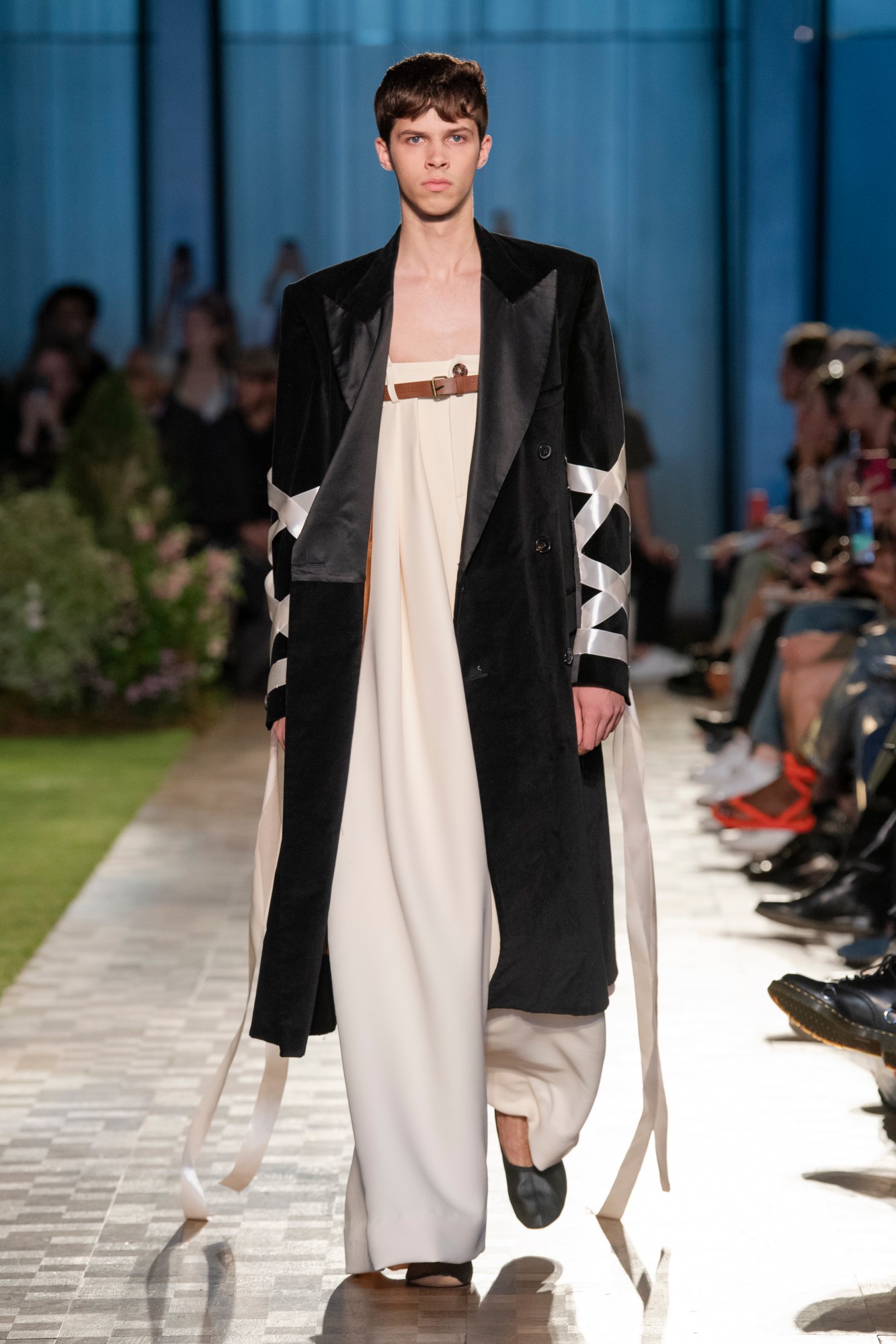
S.S. Daley
Many know the story of Vita Sackville-West and Virginia Woolf, and their famed illicit love affair documented through a series of forlorn love letters. But what is less known is Vita’s earlier messaging with another special V in her life: fellow writer Violet Trefusis. It was this correspondence between the teen lovers navigating forbidden love, heartbreak and gender identity in a patriarchal aristocratic society that became the cornerstone of S.S. Daley’s SS23 collection, aptly named Vita. Steven Stokey Daley, who won the coveted LVMH Prize earlier this year, has become recognised for his incredibly well-tailored women’s and menswear that espouse the air of an English boarding school kid’s preppy wardrobe with a queer edge. Vita, then, and her relationship to gender and class – in one letter to Violet, she described her masculine side as a “schoolboy let out on a holiday” – was a natural muse for the designer’s show at the St Pancras Renaissance Hotel, a garden inspired by Vita’s beloved pastures at Sissinghurst Castle sitting at the centre of the runway.
As the show opened, a church bell tolled as a model in a black corduroy wide-legged suit led a procession of uniform boys holding candles solemnly around the runway in the usual morning traditions of austere British society. What followed was a collection of garments that spoke to the intimacies of Vita and Violet’s letters. Her love of gardening was translated onto calico shirts with the illustrations found on a seed packet and lavender-printed loungewear. Heads were covered from the daytime sun by silk scarves and brimmed hats over eyewear designed in collaboration with Dan Levy of Schitt’s Creek who was engrossed from the front row. Bunnies, a common talking point between Vita and Violet, manifested in tee’s adorned with the words “bunny boy”; dancing hare knitted polos; trench coats — made entirely from one piece of fabric — printed with the intricate line drawing of a rabbit; cosy knitwear hare ear headbands and button nose and whiskers face paint. The entire collection was then paired with tassled loafers and uniform-esque laceups by Malone Souliers.
Ever the thespian – Steven was a member of the National Youth Theatre and enlisted them for his SS22 show – the models re-enacted the moments from Vita and Violet’s letters when their star-crossed romance was at its most fraught. The pair were then reincarnated in two final looks – featuring masculine black mourning coats with ballet ribbon detailing (a nod to an illustration of the pair hiding away in the South of France, Vita dressed as a man) a pair of Stephen’s signature wide-legged trousers dramatically elongated and belted at the bust, and black leather bunny ears. The kind of expressive, androgynous fashion Vita and Violet, we assume, would have loved to wear. TG
Molly Goddard
“I love clashing prints, clashing colours, and clashing textures,” Molly Goddard explained backstage after her SS23 show, distilling this raucous and riotous show down to those juxtapositions. The models came out in groups of twos and threes, criss-crossing the Seymour Leisure Centre’s main hall in different directions, overlapping with each other in intricate loops of the show space. The aim, Molly said, was to create an immersive show experience, something slightly unrecreateable in the endless scroll of images and catwalk look slideshows. It was about the experience of watching a show, that sensory overload of music and colour and people. Read our full review here. FP
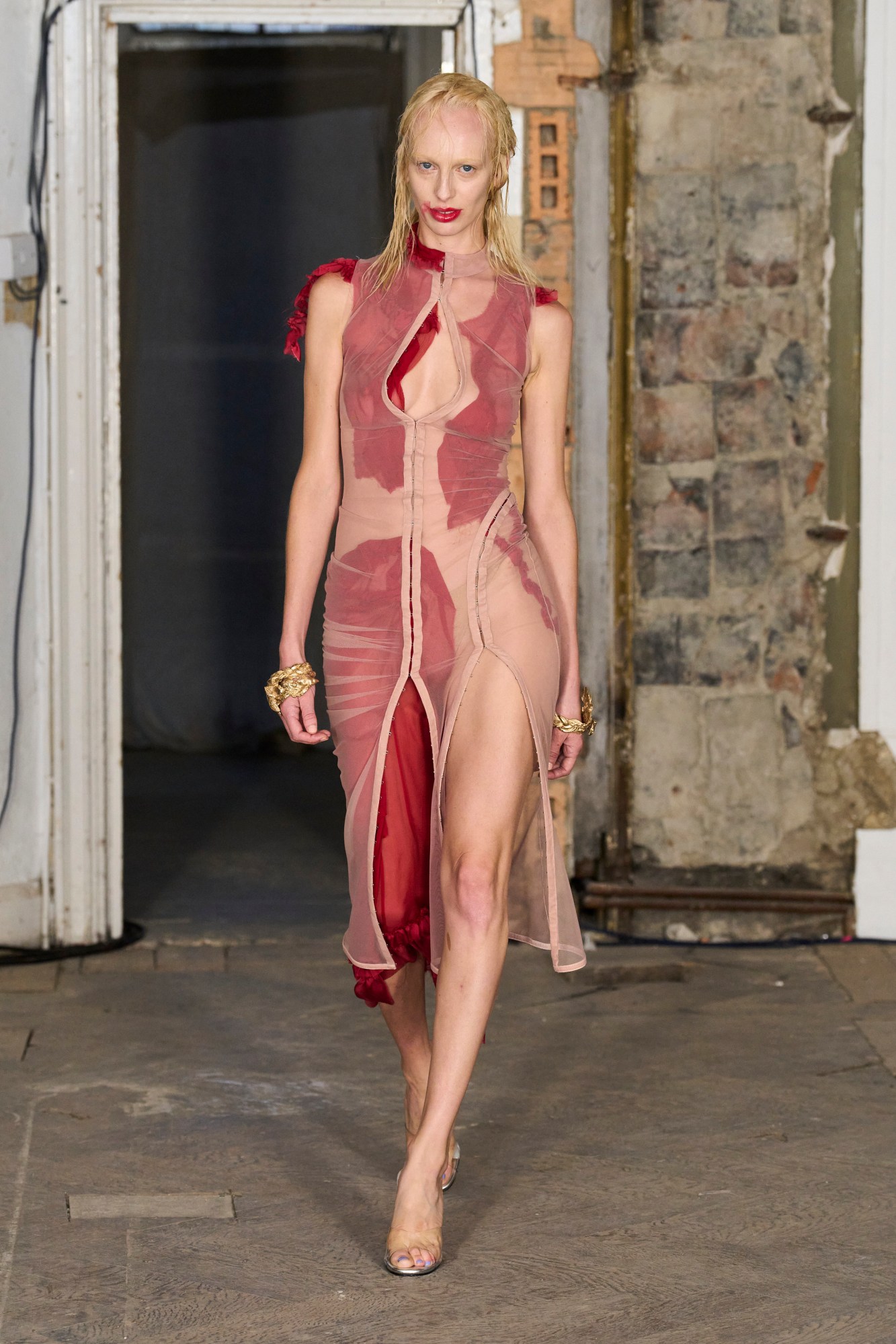
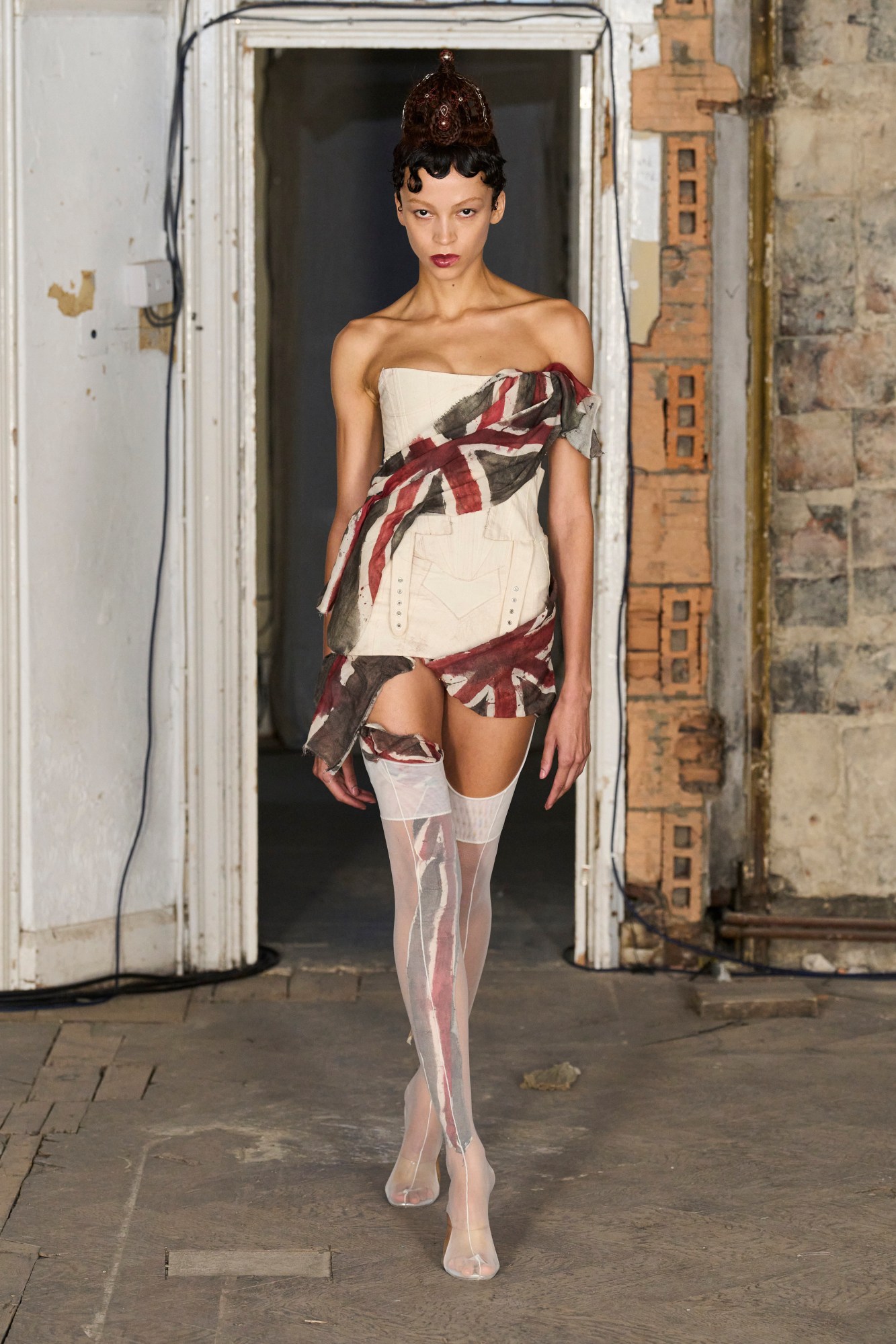

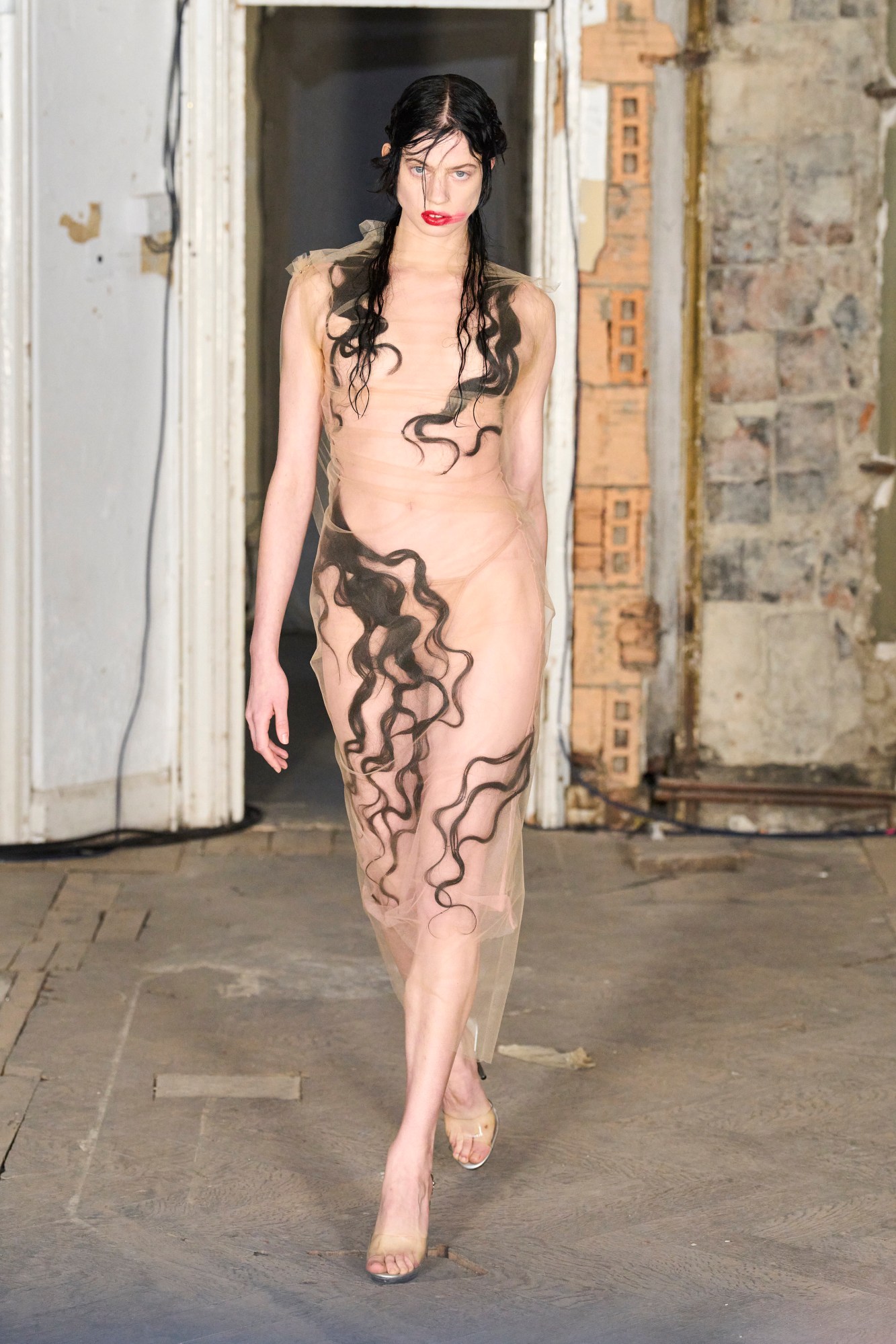
Dilara Findikoglu
The last year-and-a-half hasn’t been easy for most, but – on top of the collective emotional rollercoaster we’ve all had to ride – Dilara Findikoglu also found herself blighted by endless bureaucratic drama. Forced to return to her native Istanbul in order to process her visa to remain in the UK, on arrival she was soon reminded of “memories of feeling trapped and being controlled by tradition, religion and modesty,” she explains. “It really pushed me to think about what freedom really meant.” As such, the show she staged in a crumbling 19th-century hotel in West London amounted to a celebration of “my journey towards reaching physical and mental freedom” – a toast to successfully shaking off the shackles of a restrictive past.
Walking in pin-drop silence across the worn parquet floors, models with straggled hair and smudged make-up wore exquisite, evocative garments that simultaneously conjured feelings of awe, melancholy and hope. A battered leather shift dress and a scarlet feathered corset dress teetered the line between battle-ready toughness and delicate beauty – redolent, in many ways, of Lee Alexander McQueen and his propensity for transmuting emotional pain into exquisite, gothic beauty. Scrims of tattered Union Jacks were cobbled into a minidress and worn with a dainty braided crown – a nod to Dilara’s journey to these isles, rather than to current events – while wisps of gauze wrapped around swatches of Victorian brocade and trails of human hair, trapping them against the skin. “It comes from the idea of burying the things I don’t want inside of me,” she explains of the technique. “The first look is a delicate ruffled piece of a Victorian garment, trapped in a sheer mesh fabric representing the fact that I’ve left my childhood traumas and burdens behind, and have been reborn as a new free soul.”
As exquisitely crafted as the clothes that she presented were, for Dilara, it was the wider experience of this moment of homecoming that she cherished most. “It was so exciting to be back doing shows again, creating an experience that allowed guests to really go into my world,” she says. “It’s about the feeling that I leave in people’s hearts rather than just showing fabrics stitched together.” MS

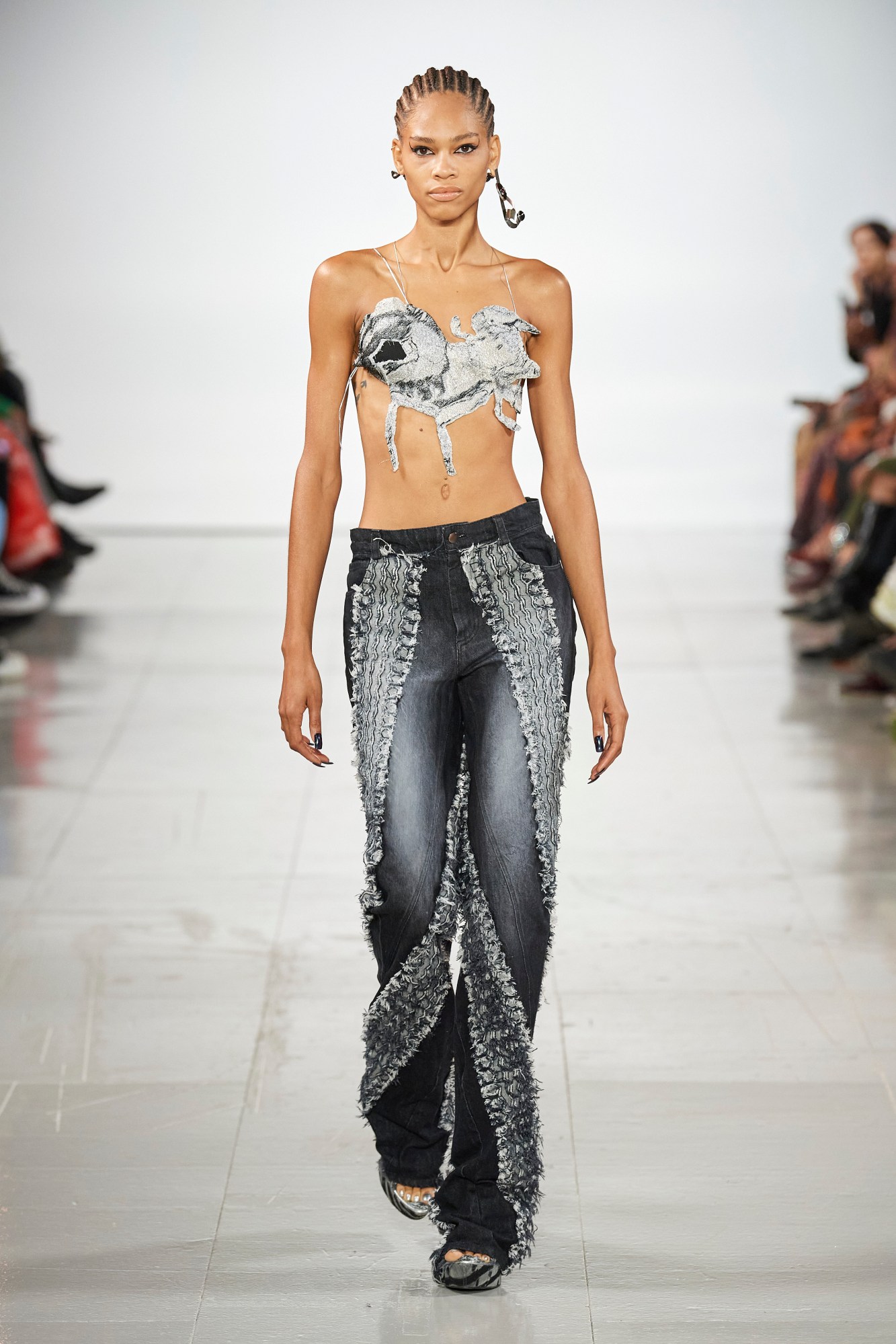
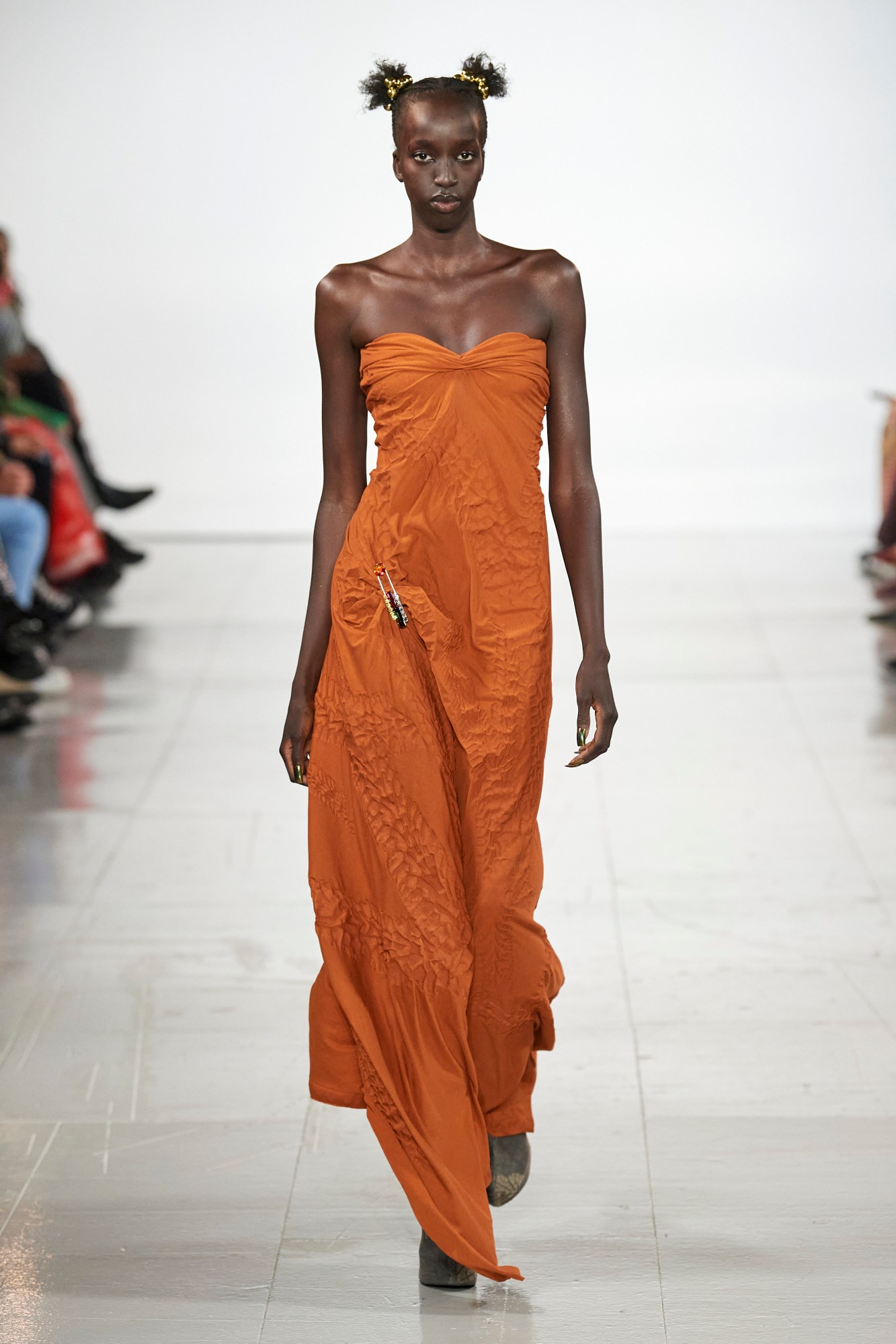
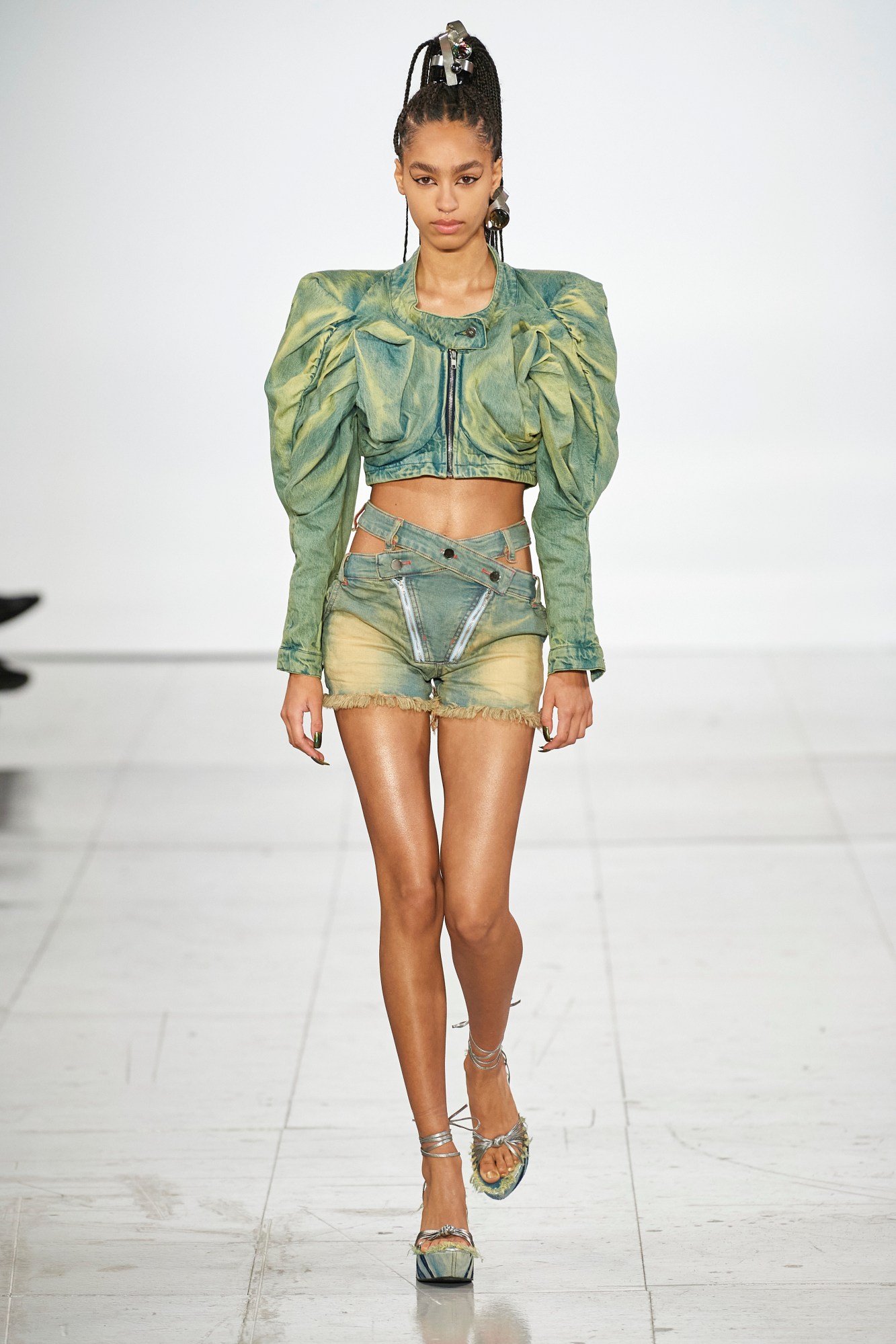
Masha Popova
Though a handful of notable presences may be conspicuous in their absence from this season’s order of service, just two days in, it’s London’s newest names on the schedule that have proven themselves more than capable of plugging those gaps. Among them yesterday was Masha Popova, the Ukrainian-born designer who, in just two years since graduating from CSM’s prestigious MA, has fast made a name for viral pieces like her crystal-encrusted butterfly tops and bleached-out swathes of denim, earning endorsements from celebs like Dua Lipa and Bella Hadid along the way.
For RUSH, her runway debut, Masha put the pedal to the metal, turbocharging the Y2K-redolent sexiness her work has long since been imbued with, and peppering it with grit. Denim, naturally, served as the collection’s primary canvas — slashed spaghetti strap slips worn over wide-leg jeans came in grungy washes of indigo, turquoise and mustard, and jackets and zippered tube dresses with crumpled, draped power shoulders were gravel-grey. Tyre prints dragged across body-cladding jersey tops and halter neck dresses, while jeans with the brand’s signature v-shaped waistband were streaked with iridescent petrol hues. Get in the car, losers! MS
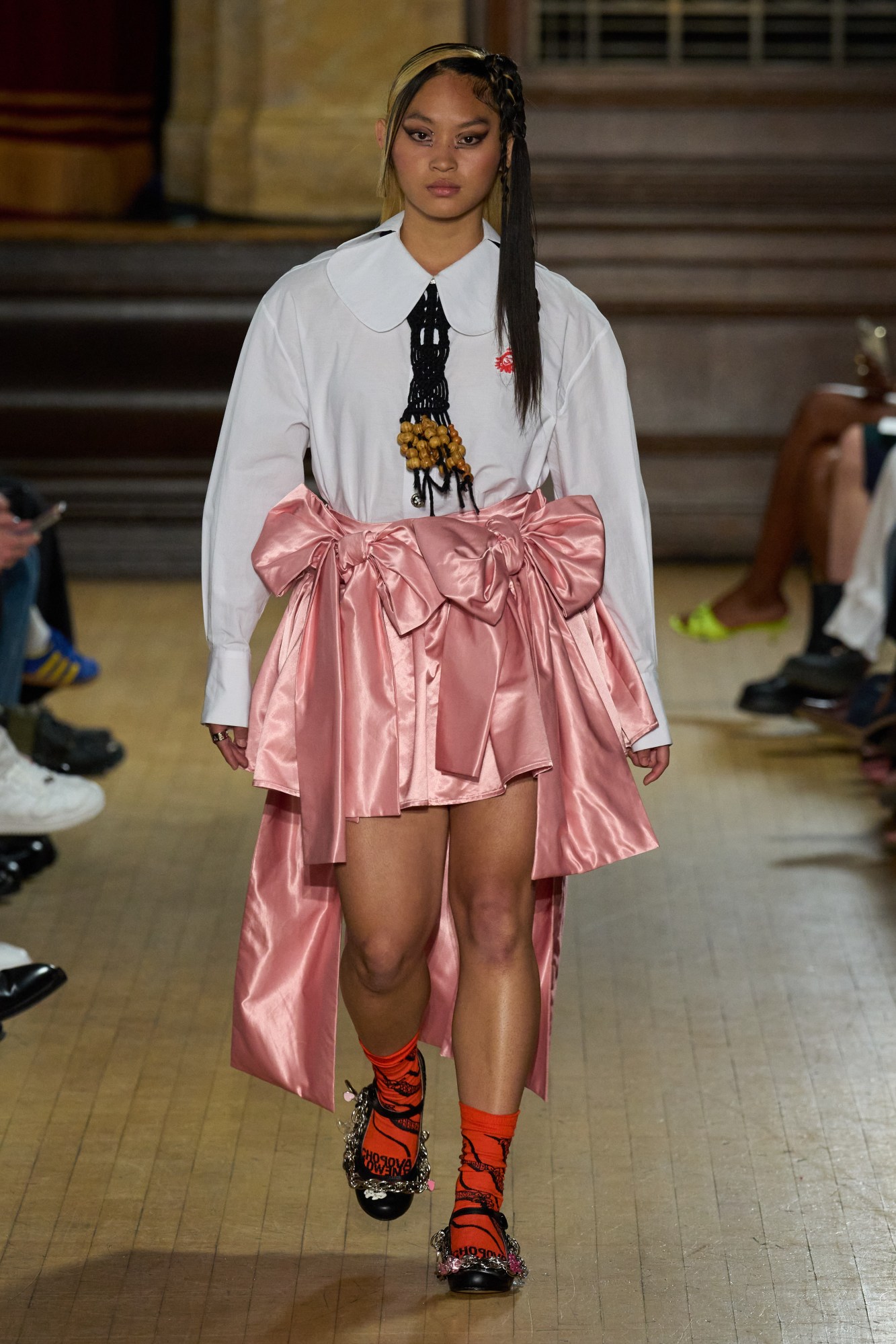
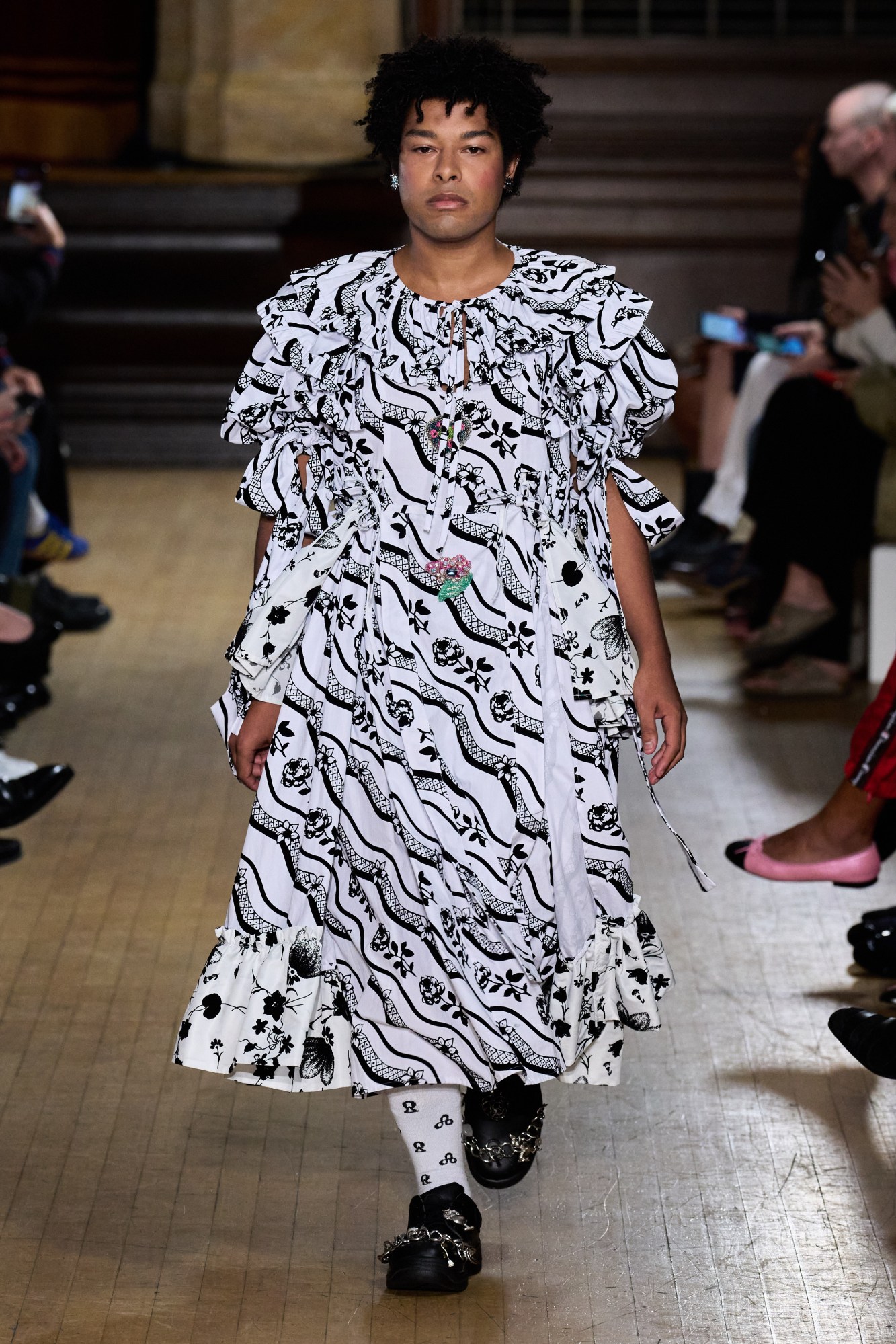
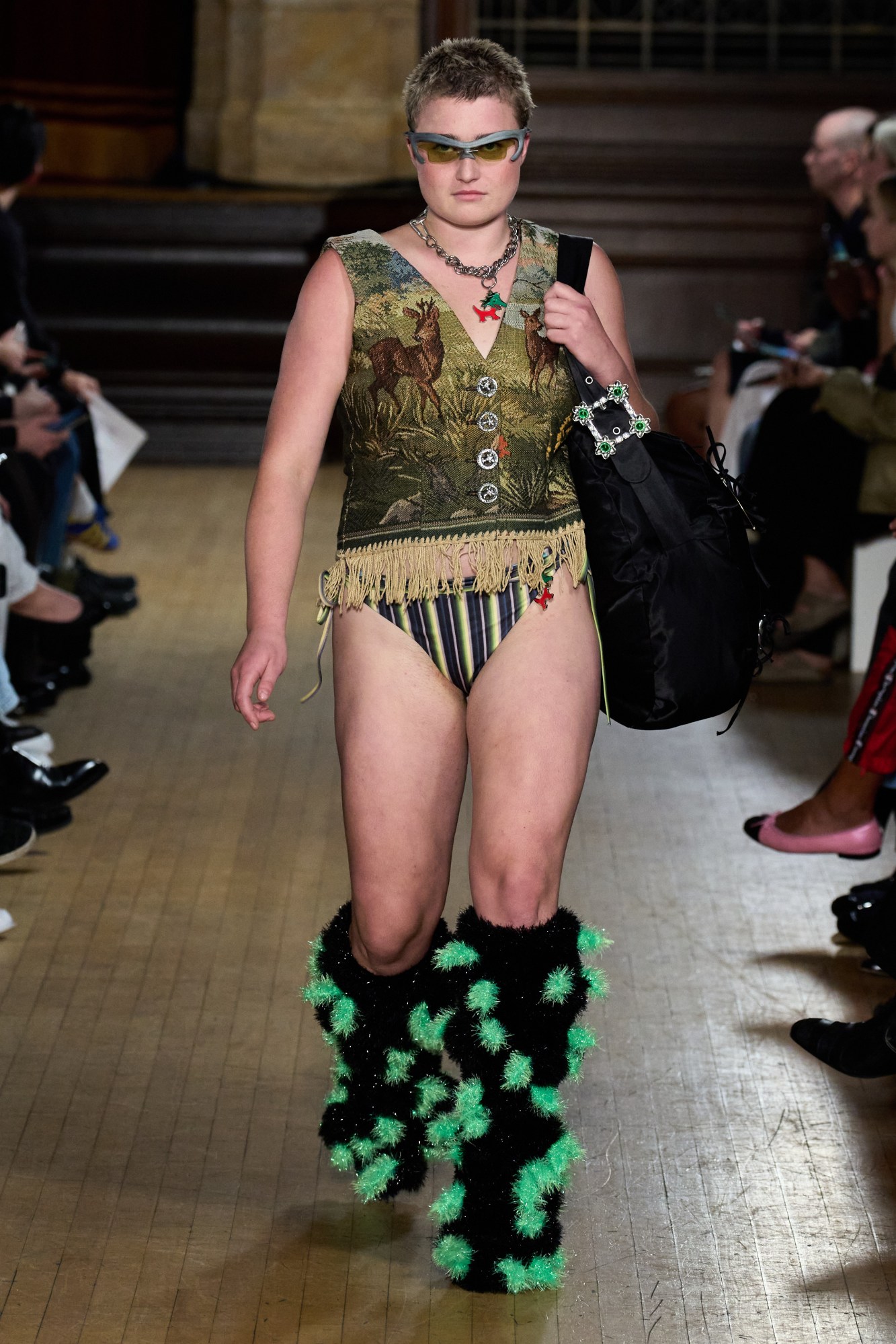
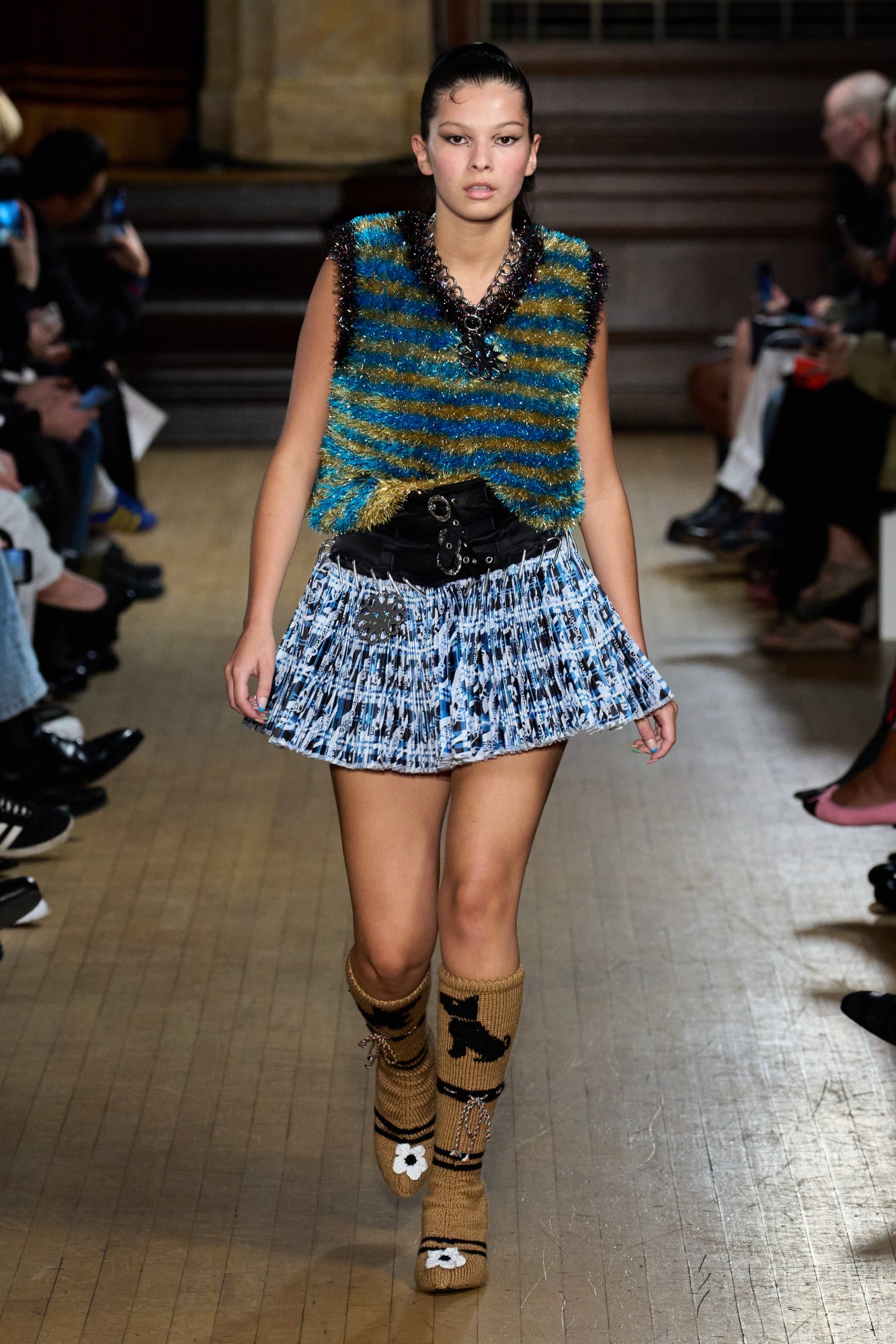
Chopova Lowena
Around the corner from the venue of Chopova Lowena’s first fashion show, more than a dozen of the independent label’s carabiner-fastened kilts could be spotted in the local pub. These weren’t just editors or buyers getting a G&T between the first day of London shows, but a colourful community of loyal fans of the brand, assembled like a classroom of punky school kids in customised British school uniforms. That’s a lot of devotion for a label only just making its catwalk debut, but then again, Emma Chopova and Laura Lowena-Irons have quietly amassed a cult-like following since they began working together on their Masters degree at Central Saint Martins, and subsequently launched their label together. Yes, they have become known for those spliced tartan kilts, inspired by traditional Bulgarian dress (Emma was born in the capital of Sofia) — but also for their chunky mixed-metal jewellery, whirling ruffles of fil coupé blouses and dresses, and slightly off-kilter mismatched fabrics and deliciously kitsch motifs.
For their first show, the designers streetcast a group of friends of all ages and sizes (including i-D’s very own Mahoro Seward!) to stomp the old ballroom of Porchester Hall in a collection inspired by the “tacky, pink and wonderful” annual rose festival and pageant that takes place in the village of Kazanlak, and sees a Rose Queen crowned each summer. Not to mention lacrosse outfits, an ode to the school sport that Emma played in high school. Somewhere in between lay a subversion of the teenage tribalism and angst that defines most classrooms: the jocks, the cheerleaders, the outsiders, the inevitable rebels. Tinsel-wrapped boots offered the perfect foil for fast-paced strutting, swirling pleats of fabric became exaggerated rose corsages, and throughout, the colourful, graphic sense of texture and colour that the duo have cornered so well were styled with the kind of irreverent, buckle-strapped styling familiar to those who flocked to the stalls of Camden Market in their teens.
Given that they began fitting the collection months ago, Emma and Laura were keen to point out that each outfit had been custom-designed for the diverse cast of people walking the show. The result was a celebration of individuality — as well as a testament to their devoted community. Therein lies their genius: clothing that makes you feel a part of something bigger than yourself, while resolutely looking like yourself. OA
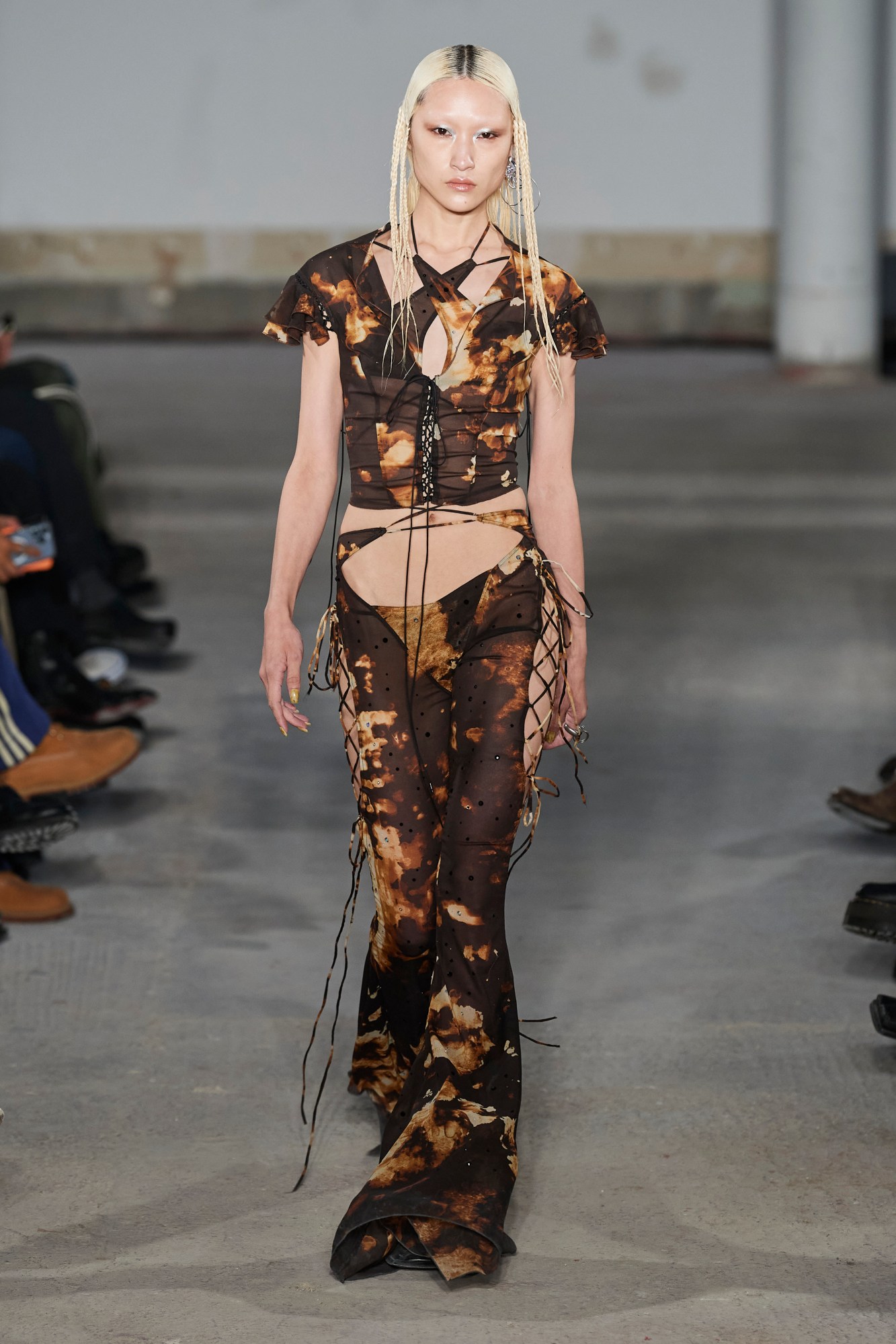
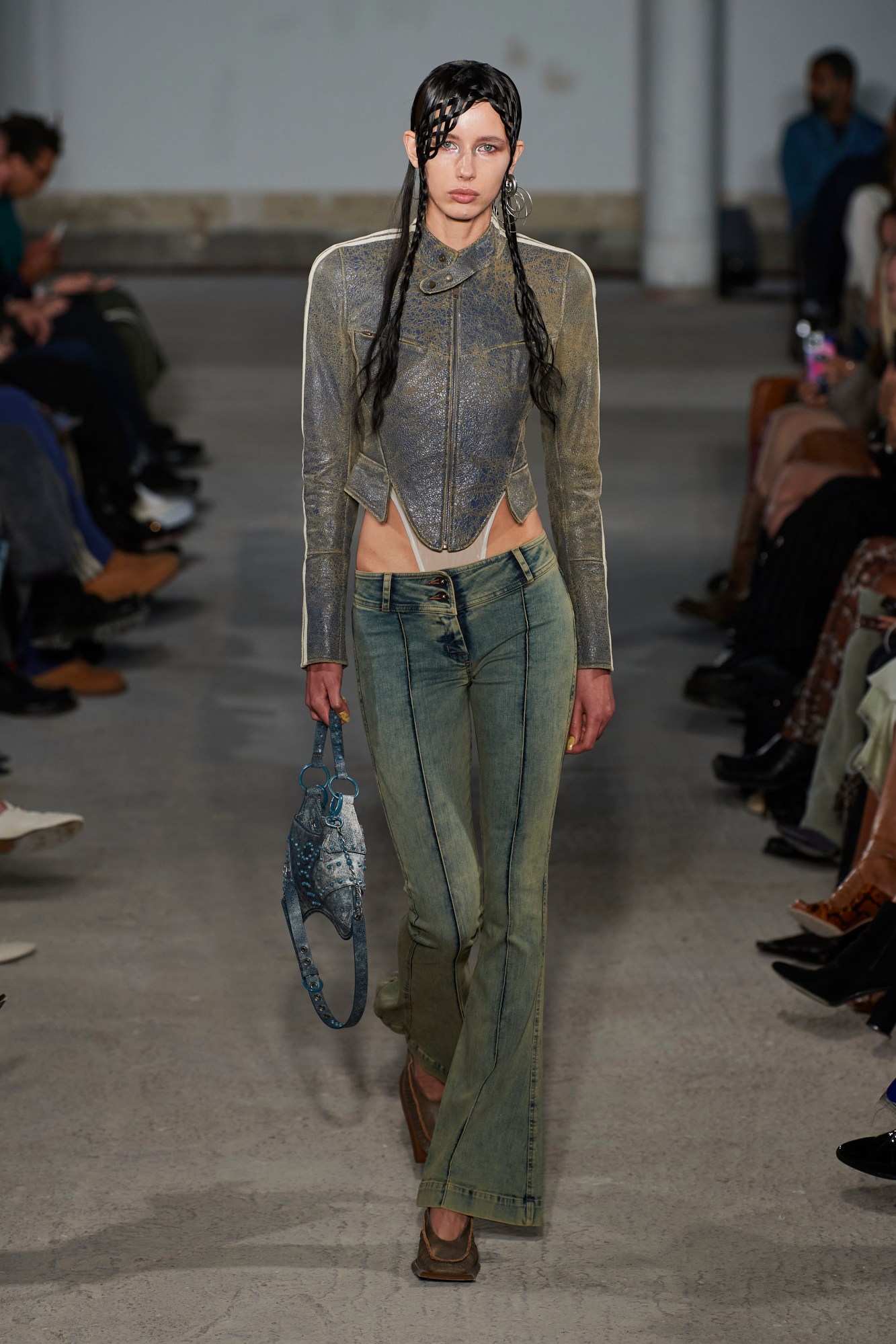
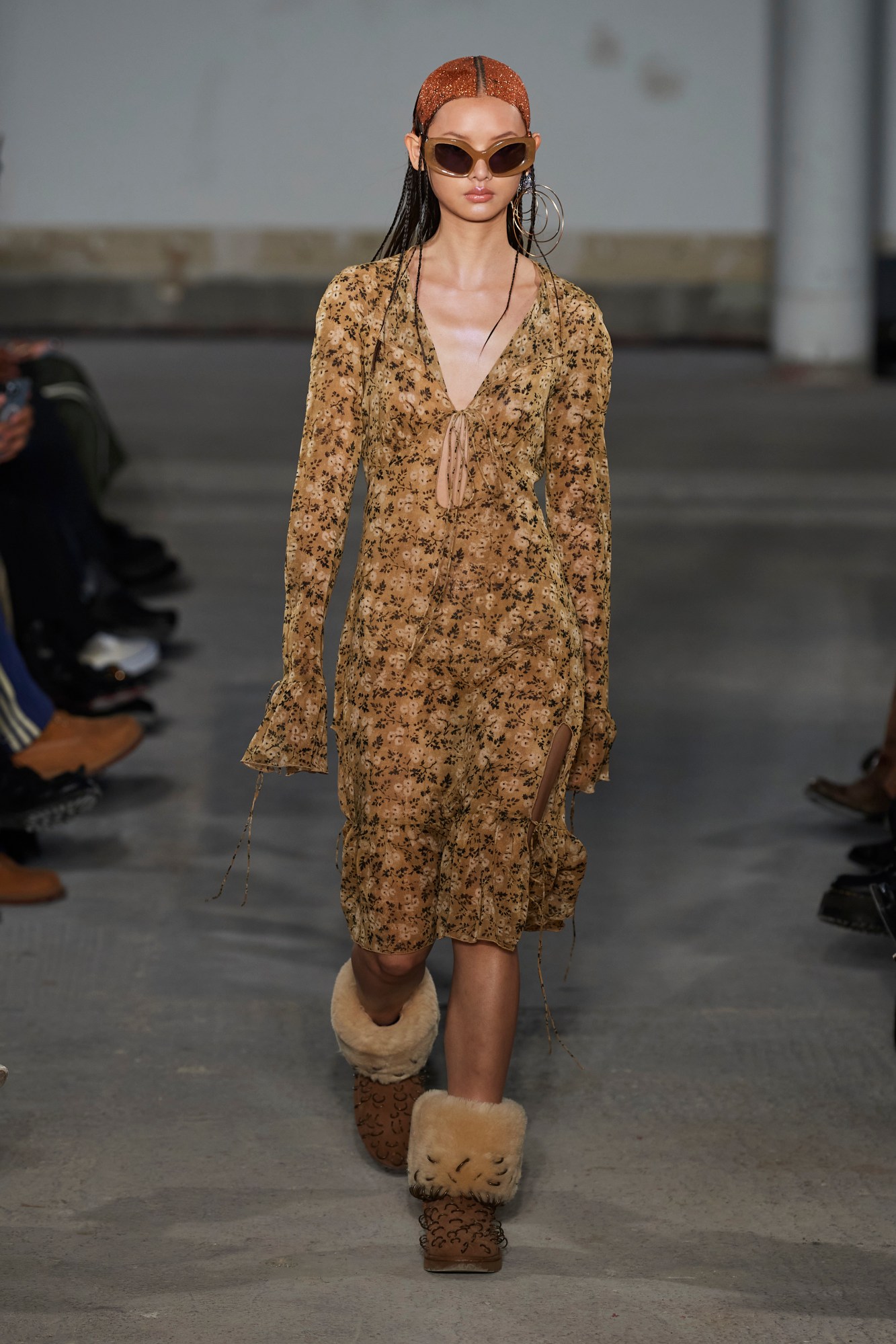
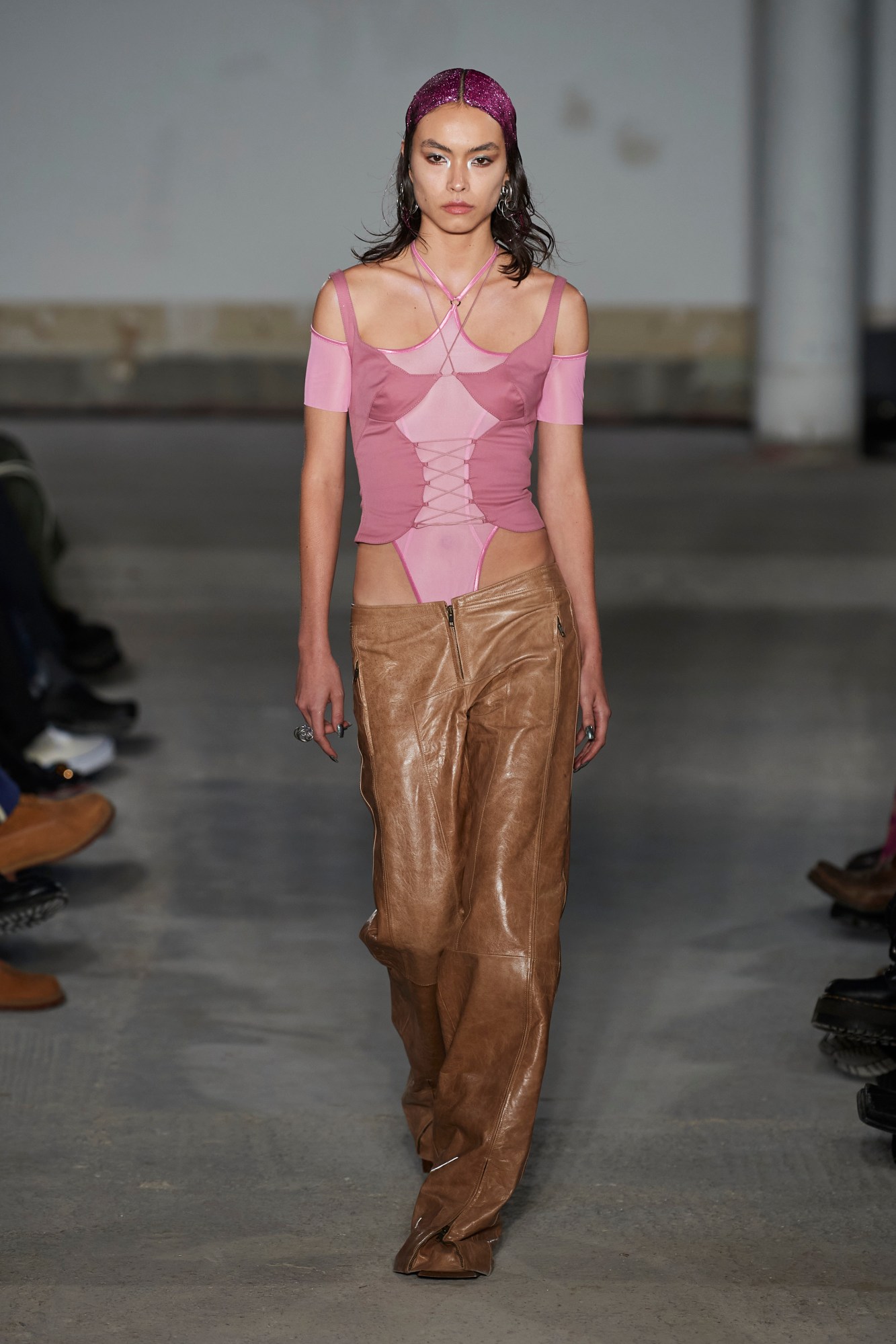
KNWLS
A big question facing young designers right now is how to navigate the ever-quickening pace of fashion. On one hand, a demand for more ‘sustainable’ methods of consumerism is often answered with a sense of timelessness and well-made investment pieces. On the other, trends are christened every second, and fast fashion giants are able to pump out imitations of buzzy independent brands at supersonic speed. What’s a young designer to do? For Charlotte Knowles and Alexandre Arsenault of KNWLS — stick to your guns. The boyfriend-girlfriend duo’s SS23 collection was shown yesterday in the annals of a derelict building. The raw concrete walls set the tone for a collection that was fierce, to be sure, but also more playfully girly than the usual flaming-hemmed stripper-biker hybrids. Whereas previously, their vision of hyper-femme vixens has been all tough leathers and dominatrix-y corsetry, this collection marked a gradual evolution into something lighter, softer and perhaps even a bit — dare I say it — girlier?
Make no mistake: the straps and lacing zig-zags, incendiary cut-outs, and worn-in leathers continued to outline the edges of the female form, if not expose it entirely. There’s still plenty of the tough-girl Moto jackets and sharp-edged stomachers beloved by the likes of Julia Fox. But this time, that deliciously earthy palette that Charlotte and Alexandre love was still present — honey-hued leathers, tobacco suede jackets, and biscuity shearlings — although made way for brighter bubblegum pops of Barbie pink and Little Mermaid aquamarines. Glitter-strewn wigs, ditsy florals (you’ll have to look closely for those) and a more diaphanous, flared silhouette showed a softer side to the otherwise hard-edged character. Perhaps it’s all this talk of Disney princesses, Greta Gerwig’s upcoming film, or just a general sense of grown women wanting to retreat into the warm embrace of childhood nostalgia — or maybe it’s just an indication that the Y2K revival shows no sign of waning. Case in point: as well as the fierce gladiator heels with web-like straps and tarnished brass piercings, there were KNWLS-designed Uggs, the cosy shearling-lined footwear once beloved by a generation of off-duty 00s starlets moping through airports. After all, in these trying times, there’s comfort in stepping into nostalgia. OA
Fashion East
We’ve said it plenty of times before, but we’ll say it again. London’s fashion ecosystem would look a hell of a lot different if it weren’t for Fashion East — and not in a good way. The talent incubator, founded by Lulu Kennedy in 2001 has, over the years, cemented its reputation as the place to look to for a temperature check on what’s hot in fashion — not just in Britain, but the world!
As bold a claim as that may sound, Lulu and the gang have the credentials to back it up. Over the past two decades, Fashion East has nurtured some of the industry’s most celebrated names — from Gareth Pugh, Kim Jones and Jonathan Anderson to Simone Rocha, Grace Wales Bonner, KNWLS and many, many more.
For this season’s show, which took place earlier yesterday in the cavernous Mills Fabrica complex in King’s Cross, two new names — Karoline Vitto and Standing Ground — joined the Fashion East line-up, with Jawara Alleyne showing his fourth and final collection before fledging the fold. Ahead of their shows, joined by photographer Henry Mills, we stopped by each of the designer’s fittings sessions for an intimate preview of their collections and a behind-the-scenes peek into their innovative processes. Head here to check it out! MS

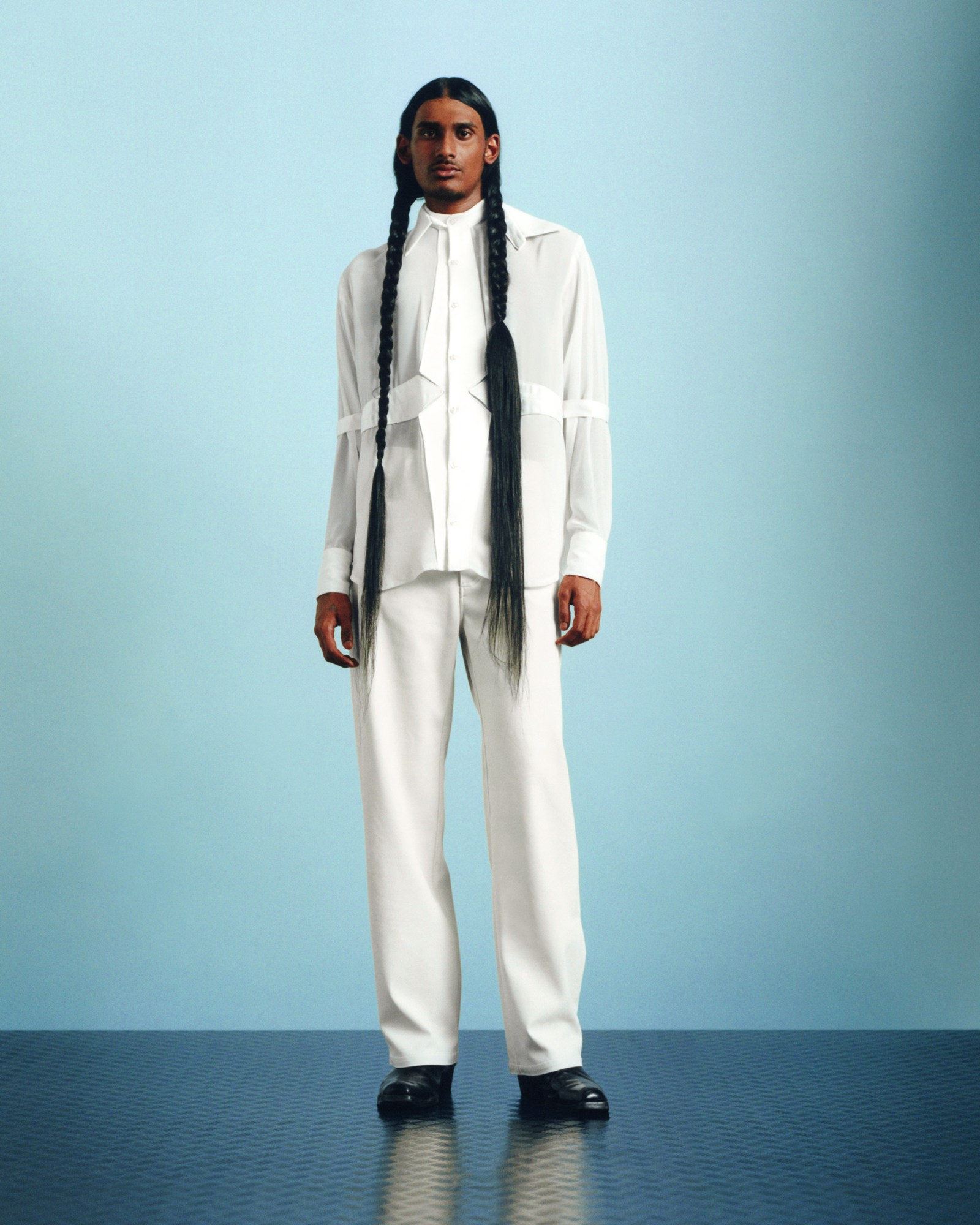

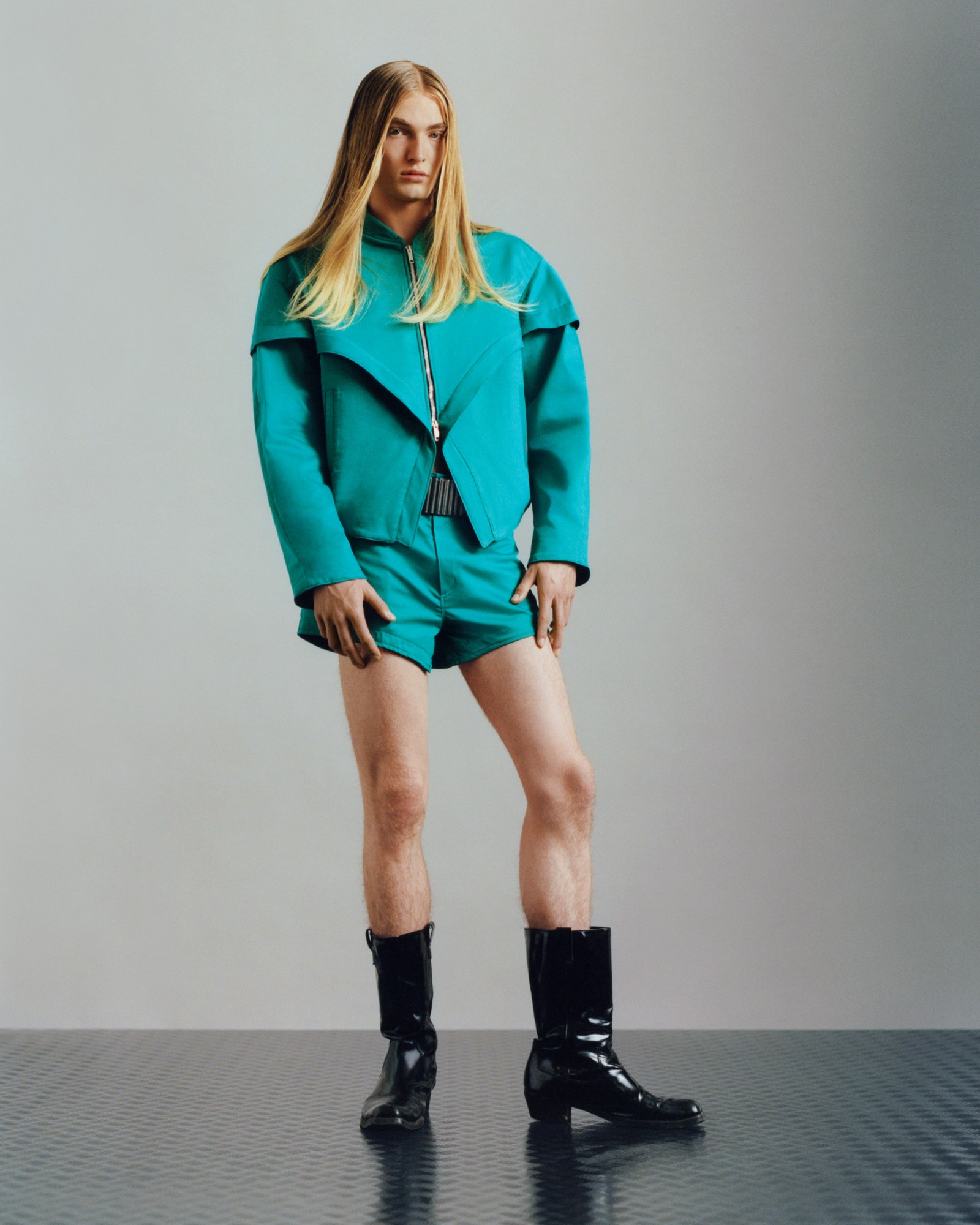
AV Vattev
If current events in Britain have reignited your love for fashionable royals, here’s another to add to your moodboard: Princess Kalina of Bulgaria. Ok, so, she’s not technically still a princess, given that the Eastern European nation’s monarchy was abolished in 1946, but gauging by her looks alone, she’s still deserving of the crown. Blessed with a gleefully eclectic, subtly subversive sense of style, she’s known for pairing richly embroidered traditional vests with punkish, spiked dog collars – svelte, black gowns with braided gold-chain wigs. For SS23, AV Vattev’s namesake founder, Antonio Vattev, drew inspiration from the unparalleled energy of his fellow countrywoman – in particular her yen for blending ceremonial chic with casual flair.
Rather than nod directly to her lewks, the London-based designer revisited a number of the brand’s instantly-identifiable signatures – diamond strap closure jackets, lozenge panelled jeans, and webbed knits among them – relaxing their their typical Mick Jagger-y sexiness. AV Vattev’s emblematic Jukebox silhouette – the aforementioned diamond strapped pieces – were interpreted as roomy blazers and hoodies in tobacco vinyl and tonal navy and royal blue jersey. Zings of colour come through in chartreuse cable knit bermudas and short-shorts of in pastel blue jacquard, while a moodier sensuality was suggested at by this season’s standout leather pieces — asymmetric wrap-kilts and laser cut trousers that echo the brand’s diamond grid pattern, while also nodding to artist Richard Serra’s series of vulcanised rubber sculptures. Please join us in prayer for a Princess Kalina cameo in these, stat! MS

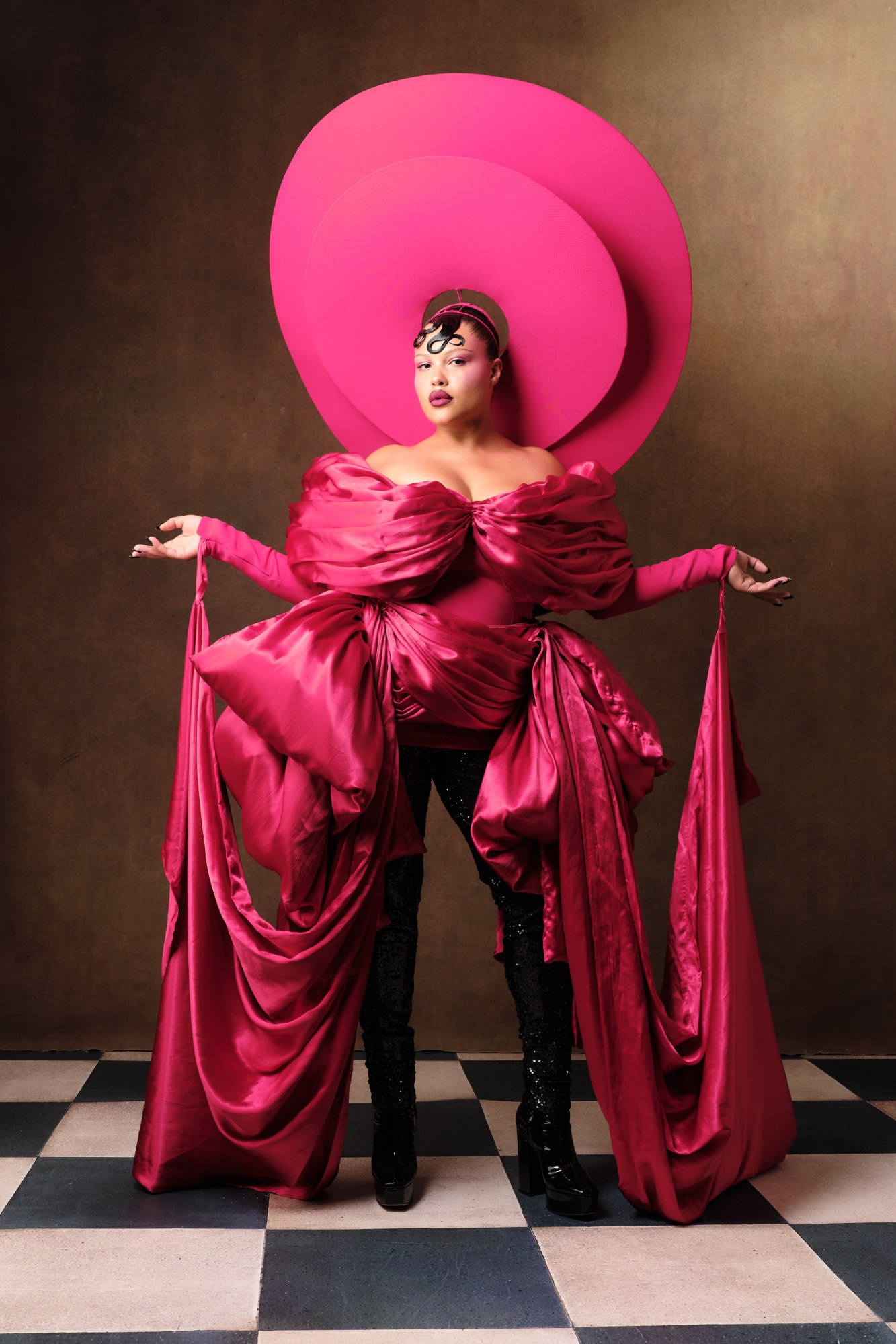

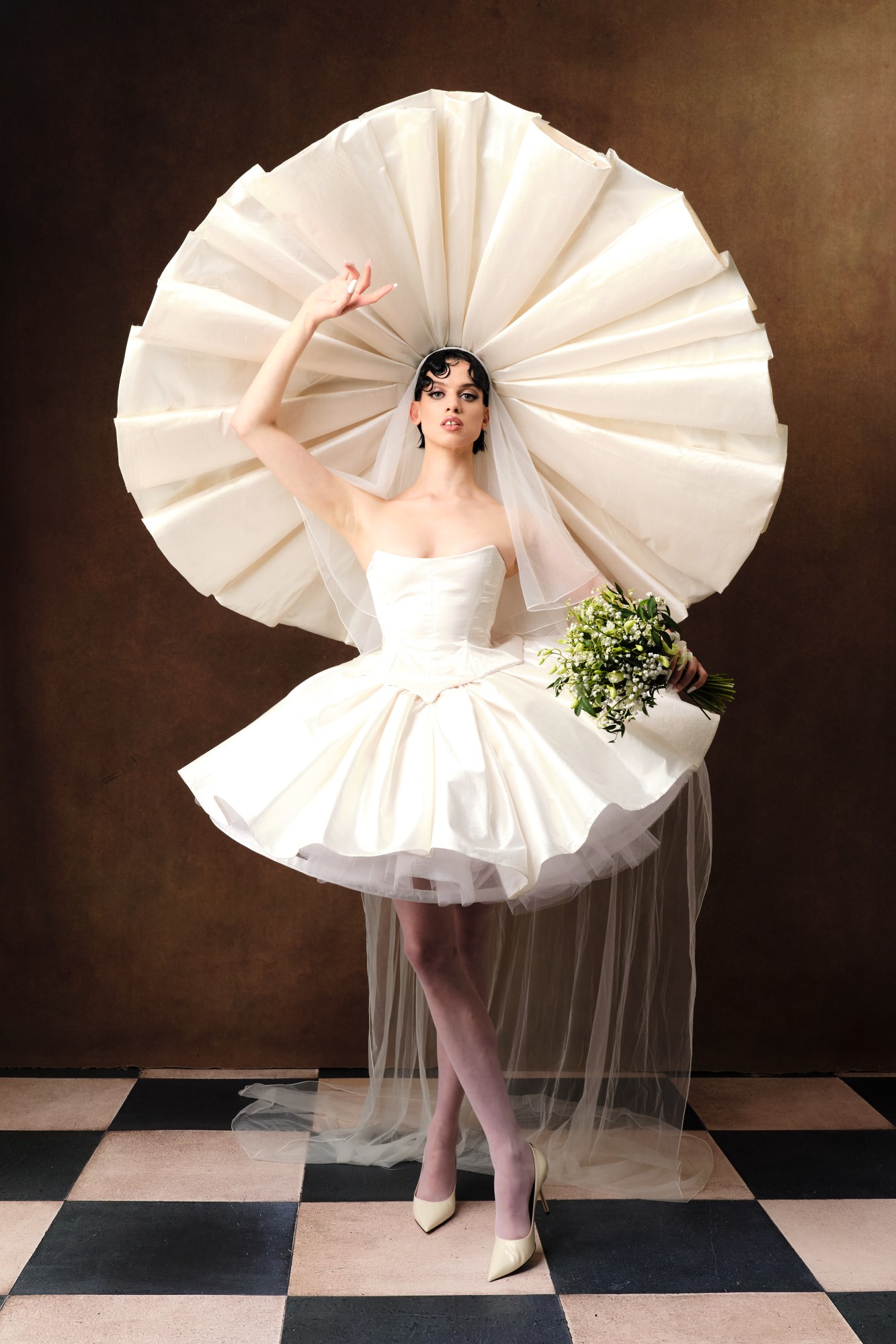
Harris Reed
Harris Reed is a master of a dramatic spectacle. With multiple iconic moments under his belt in recent months – Beyoncé and Lil Nas X both broke the internet this summer wearing one of his famed feathered halo headpieces – queer stars like Kim Petras, Sam Smith and Heartstopper’s Yasmin Finney, took to the front row in a renovated, 16th century protestant church in the City to watch the fourth season of Harris’ custom couture. Inspired by the traditionally feminine social etiquette of debutante balls, the collection, entitled Mise En Scène – a french term for “staging” – plays with the performative possibilities of dressing, as a fluid generation step forward and make a rebellious entrance into society by usurping the event’s austere codes.
Pop rock singer Adam Lambert sang a medley that included a Puccini aria and a Roberta Flack classic, while androgynous models graced the hallowed church floor in a structured crinoline cape, black svelte gowns with oversized blossoming petal necklines and a sequin-strewn mermaid skirt with an assortment of chains dangling across the chest, capturing celestial moons and star trinkets, created in collaboration with Missoma. Sparkling 70s-inspired flared suiting was paired with heightened brimmed hats or the signature colossal Harris headpieces, both designed with oft-collaborator Vivienne Lake. Metres upon metres of regal duchess satin trains were either framed around faces to create a celestial orb, or, in the case of Alva Claire’s look, hiked up and ruched at the hip in dramatic hot pink bows. Finally, as Adam performed “Who Wants to Live Forever” by his adoptive band Queen, Lily McMenamy was a ballerina bride fittingly carrying a bouquet of lilies of the valley, folds of her crisp off-white corseted dress reflected in a matching disc that sat upon her veil. Theatrical, commanding and with Harris’ usual New Romantic flare, you couldn’t help but wonder which pop star will be all over social media when they wear one of these show-stopping looks in the months to come. TG




